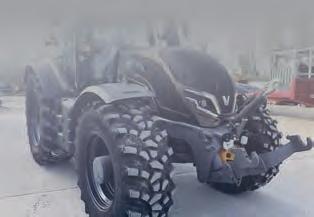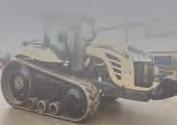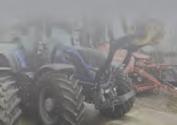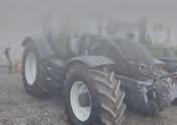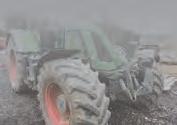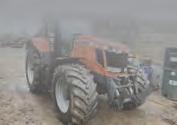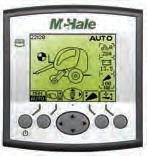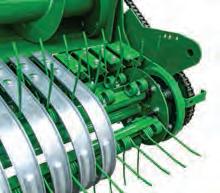

































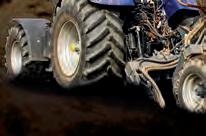




0%








































0%

NOVACAT V 10000
Flexible operation - optimises mowing width for maximum output - hydraulic side shift adapts up to 370 mm The best ground tracking - hydraulic weight alleviation with optional, automatic ground pressure adjustment depending on the set working width






Convenient – section control capability for automatically lifting and lowering the mower units at the headland Reliable - NONSTOP LIFT collision safety system - unique 3D deflection of the cutter bar - no need to stop Durable - Unique Y-DRIVE driveline ensures 5 times longer service life
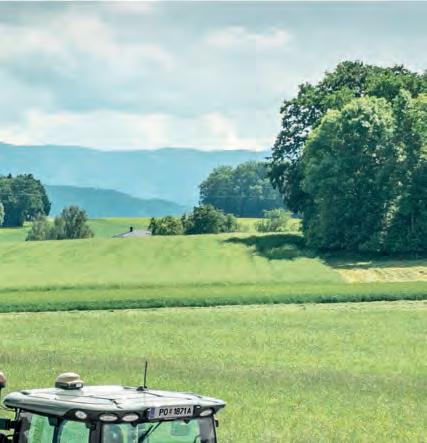
EDITOR Daniel Colombini
Daniel.colombini@farmmachineryjournal.co.uk
ART DIRECTOR David ‘Spike’ McCormack
DESIGNERS Sarah-Jane Mortimer, Claire Trent
RETOUCHER Linda Duong
ADVERTISEMENT SALES Alex Cronin 020 8639 4406
ADMINISTRATOR Martin Attis 020 8639 4409
PUBLISHING DIRECTOR Paul Cosgrove 020 8639 4401
CONTRIBUTING WRITERS AND PHOTOGRAPHERS
Ken Topham, Mick Roberts, David Laley, Graeme Kirk, David Wylie, Howard Sherren, David Pullen.
Farm Machinery Journal is published by Sundial Magazines Ltd, Sundial House, 17 Wickham Road, Beckenham, Kent, BR3 5JS


TEL 020 8639 4400 FAX 020 8639 4411
EMAIL info@farmmachineryjournal.co.uk
WEB www.farmmachineryjournal.co.uk
SUBSCRIPTIONS
Farm Machinery Journal subscriptions
Trinity House, Sculpins Lane, Wethersfield, Essex, CM7 4AY



TEL +44 (0)1371 853634
EMAIL farmmachineryjournal@escosubs.co.uk

NEWSTRADE
Seymour Distribution
2 East Poultry Avenue, London, EC1A 9PT
TEL 020 7429 4000
REPRO
Design & Printing Solutions Ltd
Unit 45C, Joseph Wilson Industrial Estate, Whitstable, Kent CT5 3PS TEL 01227 770034
PRINTING
William Gibbons & Sons Ltd
26 Planetary Road, Willenhall West Midlands WW13 3XB
COPYRIGHT
Sundial Magazines Ltd 2023. All rights reserved. Reproduction in whole or in part is forbidden without the express permission of the publishers. ISSN 2055-043X Sundial Magazines Ltd. Registered in England no. 4134490.
CONDITIONS FOR ADVERTISING
All advertisements are accepted subject to the publisher’s standard conditions of insertion. For a copy of advertising terms & conditions, please write to Paul Cosgrove at Sundial Magazines Ltd, Sundial House, 17 Wickham Road, Beckenham, Kent, BR3 5JS
Welcometo Farm Machinery Journal, the monthly magazine dedicated to modern agricultural equipment.





Spring is nally in the air and with summer on the horizon, hopefully we can all start to enjoy the more clement weather both on a professional and personal level. With that in mind, I’d like to welcome you to another new edition of FMJ.

As you will see inside, our plans to champion the operator are going from strength to strength and we continue to bring you up-to-date content to re ect the changes at the magazine.
This month we will be taking a look at mowers and their importance in the coming months. We also have a special report on opportunities for young farmers to travel in the USA. Travel broadens the mind a er all, so we want to showcase the opportunities that exist for young farmers, who are the future of our sector. Something we will be exploring further in the coming months.

Furthermore, our new Hot Topic feature this month takes a look at alternative fuels. A subject that is pertinent to us all amid the global climate crisis. The impact this has on many agricultural businesses must not be underestimated and so we feel that a look at alternatives for the future is a must.
With a new era at FMJ now underway, we would like to encourage your contributions to the magazine and invite you to stay in touch with your views.
Dan Colombini, Editor
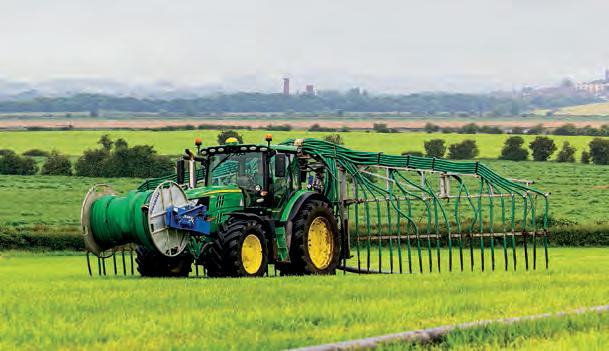





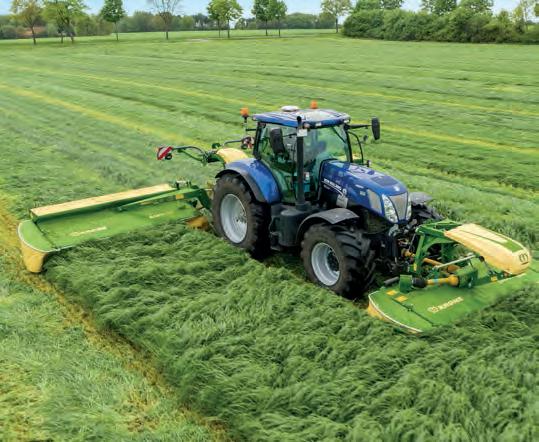





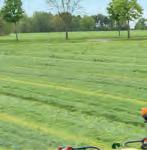



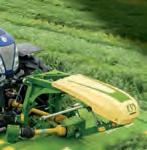













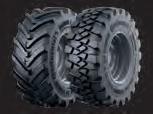








With silage season approaching, we have the perfect tyre range to improve machinery performance on the road, in the field and at the clamp.
Our tyre technology not only reduces fuel consumption, but also improves machinery efficiency, reduces soil compaction, and helps tyres last longer.



To find out how our tyres can help you bring in the green harvest and make better quality silage, use our QR code or visit the link below.
www.continental-tyres.co.uk/specialty/agriculture












After a promising spell in February and a glimpse of the Valtra at Olly Harrison’s farm, the weather broke and we waited longer than a BBC nature film crew to see the Q305 back in the wild.

In mid-April as it began to dry up, we got our chance. The tractor is dealer John Bownes’ latest demo unit. Before that, though, it spent some time in the ‘Valtra Unlimited paintshop’. With a nice paint job and ‘Batman black’ interior, the aesthetics are on point, but does it have the substance to go head to head with some serious contenders?
AGCO’s selection box of components is now probably the envy of the tractor world and the Valtra Q Series – like its red stablemate – is loaded with all the goodies. Under the bonnet there’s the formidable 7.4-litre Stage V AGCO Power motor – the one that comes from Finland and is fitted throughout the range. Further back the AGCO CVT from Germany, the ML260 unit, is also found in
these green and red tractors. It isn’t the first time the two have been mated together, but it is for tractors with the Valtra badge.
What’s underneath?
The Q Series skid unit is the same across the range, from a Q225 through to the Q305, which is the only one not to have an EPM boost of 20-25hp, depending. The transmission is also present through the range, with no other variants available – like the T series where a powershift or CVT can be specified.
Across the range the new Q tractors produce peak power at 1850rpm and torque at 1500rpm. Hydraulic and transmission oils are kept separate, and 75 litres of ‘exportable oil’ are available externally. Hydraulic output
WORDS AND IMAGES KEN TOPHAM/MWR MEDIA
After its September 2022 launch, the Valtra Q305 has been round all of the shows during the winter. After a wet March, we finally caught up with it to find out what the new range bring to Valtra’s stable
“The Valtra Q series – like its red stablemate – is loaded with all the goodies”
is 200 lit/min and there is an eco pump option that enables max output to be reached at 1650rpm. Lift capacities are 10t at the rear and 4.8t at the front.

Driving impressions
When we finally caught up with the tractor, it was on demonstration with A&D Gregory, near Chester. Operator
Gareth Evans normally drives a Fendt 824 so provides an interesting comparison.
We set to work with a Kuhn 153 5+1
Valtra Q305
Engine 74 LFTN-D5
7.4-litre, Stage V
Max power 305hp
Transmission
Two range CVT
0-50kph
Wheelbase 3.05m
Base weight 9,200kg (full tanks+driver)

Lift capacity Rear 10t; front 4800kg
Hydraulic pump 200 lit/min
Varimaster hydraulic auto-reset, ploughing 20in furrows at 8.5-9.0in deep on land that is ‘normally’ fairly dry and sandy. Unfortunately, this spring it was wet and sticky and a fresh dose of slurry on top made it quite a challenge to maintain productive work.
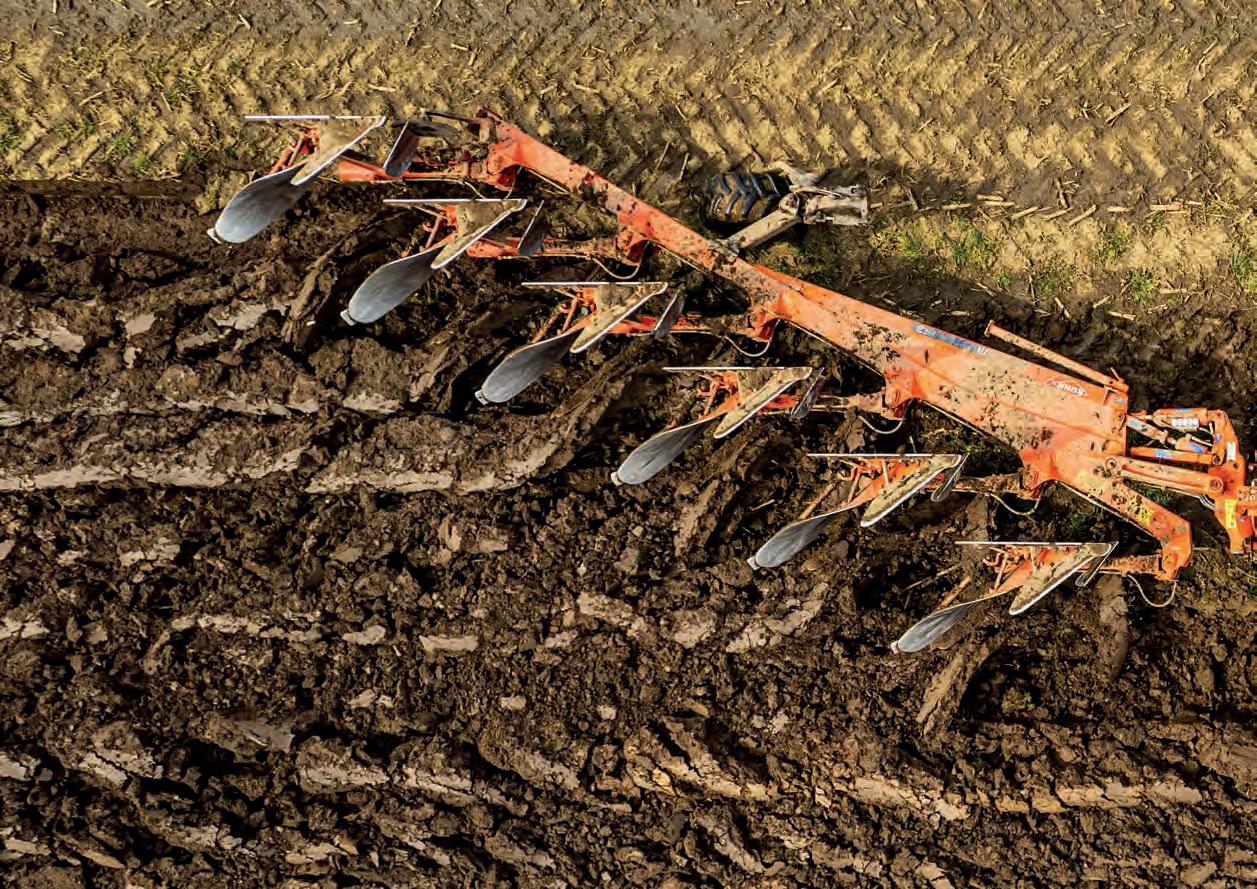
If you’re a Valtra operator, driving the Q Series should be seamless, as the cab and operator

Above: LED indicators built into the cab top, at the rear, with work lights to the front. The slim bonnet gives good visibility
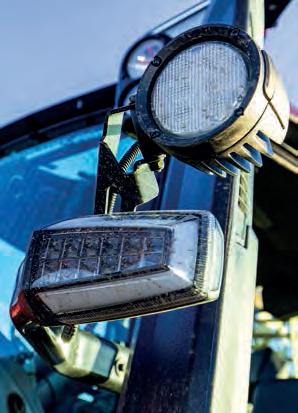
interface are practically identical to the T series, and the control lever and Smart Touch screen are the same. As well as a seasoned Fendt operator, Gareth is also a Valtra T Series user, so we couldn’t have had a better guide.
Jumping into the seat, which is the plush leather Grammer unit with sliding headrest, Gareth immediately points out that it’s nice and comfy – a good start. He had only spent a few hours in the Valtra when we arrived
“If you’re a Valtra operator, driving the Q series should be seamless”Right: The cooling pack is easy to access, with hatches to facilitate cleaning between the various exchangers Below: The front linkage capacity is rated to 4.8t, with ISObus and two SCVs ex-works. A free oil return is also fitted Above inset: Valtra side markers with LED strips are fitted on to a mirror arm and are a useful addition for wider implements Left: The front indicator cluster has had a Q Series touch, with LED turn and side lights
and hadn’t set up any short cuts, so we were ploughing manually, albeit with electronic controls.
Looking past the nice seat, the corner display is clear and easy to read, but in honesty, you hardly need to look at it, as everything you might want is displayed on the SmartTouch. In this case, however, more precision jobs that tie up the screen may involve looking to the corner display for tractor stats.
The SmartTouch was set to ‘drive’ display, showing four panels: speed,
engine, linkage and SCVs. The screen is easy to navigate, with a tractor icon at the home page that you can scroll around to find whichever area you want to set up.
Gareth had ploughed past the stickiest part of the field before FMJ took control but, even with a slick layer of slurry on top, he
never ground to a halt. The tractor was running at about 1550rpm, travelling at about 8kph, causing an average load of about 67-69 per cent with 13 per cent wheel-slip. The work covered was 6.9ha and the Valtra Q305 had used 83 litres of fuel at the point where we checked the figures.
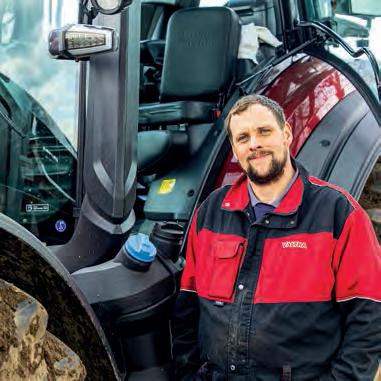


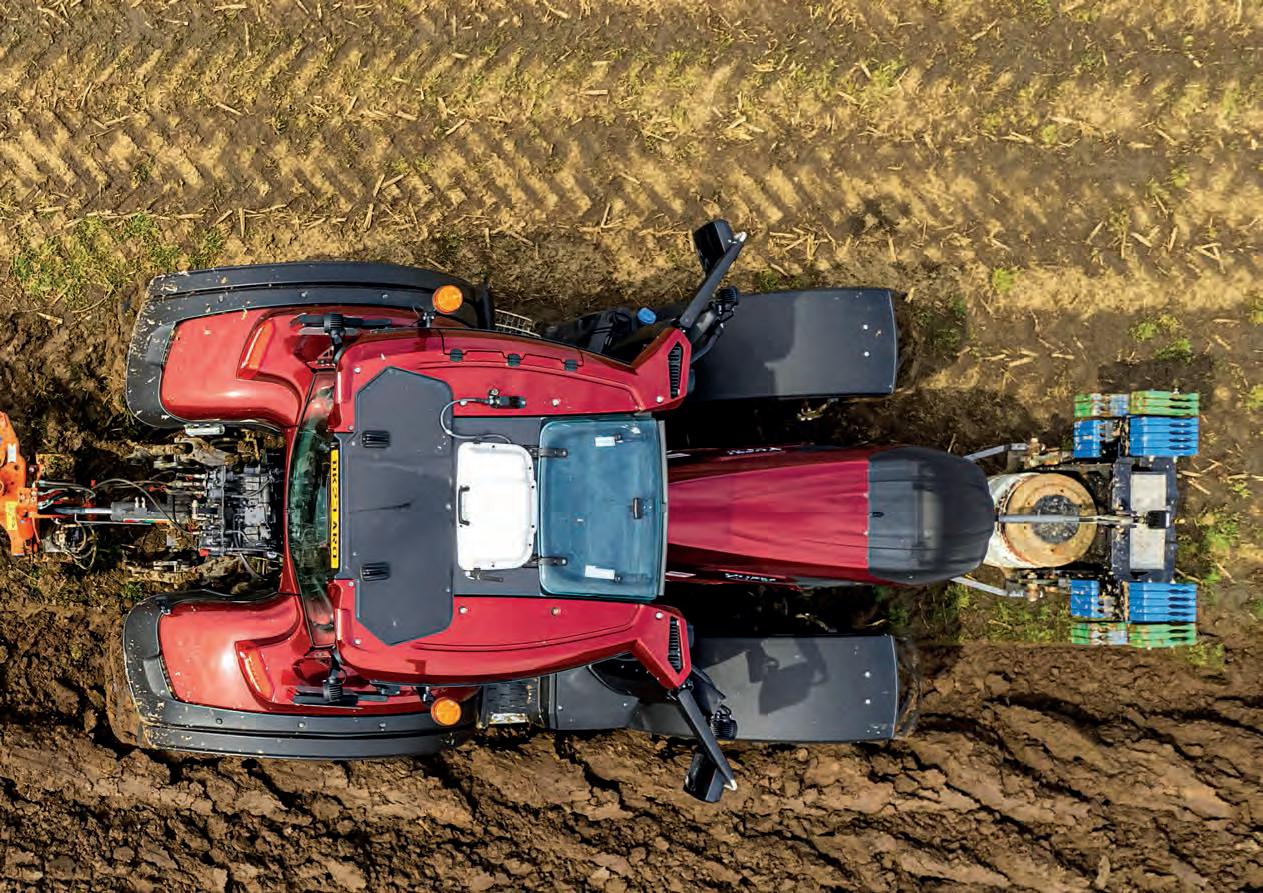
The transmission has two ranges, A and B that require a stop to change between (like a Pre-TA
Left inset: Gareth showed us the ropes and offers some interesting comparisons with the other tractors he operates
Fendt). Operating in A, it was silky smooth and speed changes under load were effortless. Direction changes were equally smooth and with no discernible transmission noise (with the windows closed). After a few attempts we found matching up the cruise control with the pedal easy enough as the scroll wheel offered 0.2kph increments. Knocking the lever to the right, when set in ‘cruise’, it accelerated up to
8.2kph without hesitation with smooth and positive speed adjustments. The CVT is a pleasure to use, even from a dead start with the plough in the ground.
Engine-wise, there was nothing surprising to report. It set off from tick-over with six furrows in the ground without
flinching and purred away under load. Valtra has made an excellent job of marrying the engine and transmission. The front axle is air suspended on the Aires system, offering a good lock and, for a 300hp tractor it didn’t feel numb on the headlands. You could keep the turns tight and with QuickSteer lock-to-lock is achieved with only a single turn of the wheel.
While we did not use the SmartTurn and U-Pilot functions, Gareth has experience of these on the Valtra T235, which is part of the A&D Gregory fleet. “It took a little


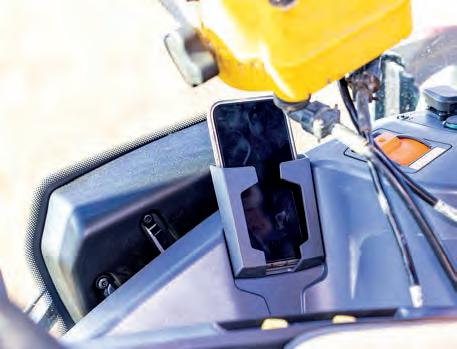
Below: It’s a small detail but you can plug your phone in while it’s in the holder, but does it actually take a modern phone?

“Operators are spoiled for choice –300hp has replaced 200hp in the hot sector stakes”Above inset: The corner display is bright and easy to read, delivering useful tractor info if the SmartTouch is occupied Left: The armrest will be familiar to Valtra users and the SmartTouch interface is easy to use
working out, but I followed one of the Valtra guys on YouTube and set it up how he explained. I needed to mark out a larger headland than I would normally use.”
It does involve setting some of the tractor parameters, such as doing full-lock turns, to find the turning circle of the machine, but they should only need doing periodically. You have to map the perimeter of the field and it works out how many turns you can fit. We were only doing grassland maintenance, nothing precise, but it did work well.”
After our admittedly brief drive,
Gareth was able to use the tractor for a couple more days clocking up hours with a set of Claas triple mowers, as well as a stint with a buckrake. He reports this was a very positive experience, appreciating the amount of power on tap and smooth drive. While buckraking, he also used a compactor on the clamp, and the tractor coped well with the deadweight on the rear linkage. He
says the front linkage also performed well – able to lift and push the grass with bags of traction. After a few days driving, his only negative comment concerned legroom – he’s used to more space on the Fendt.

The Q Series has excellent components. This, however, is a competitive sector that includes the 6R 250 from John Deere, the new Fendt 728, Massey Ferguson’s 8S, as well as the new CNH offerings in the Puma and T7.300.


Operators are spoiled for choice – 300hp has replaced 200hp in the hot sector stakes.




No matter how challenging your needs, AGRIMAX TERIS is your best ally for all harvesting operations. This radial tyre actually combines extraordinary traction and high load capacity with outstanding stability. Thanks to its special compound, the reinforced shoulder and bead, AGRIMAX TERIS provides a high level of puncture resistance as well as great handling and driving comfort.

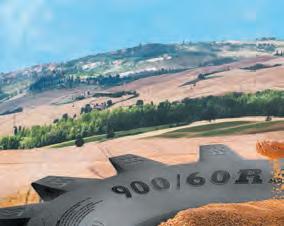
AGRIMAX TERIS is BKT’s response for combined harvesters providing best performance without damaging your crops.



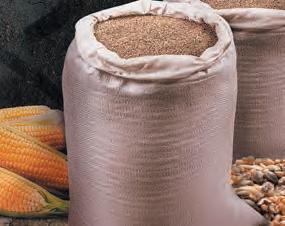







Tel: +44 0151 728 4171








bkt_enquiries@kirkbytyres.co.uk



www.kirkbytyres.co.uk

John Deere’s plant at Mannheim in Germany has produced its two-millionth tractor. It was unveiled in March at a ceremony at the site that was attended by John Deere’s CEO, John C May.


Appropriately, the two-millionth tractor was a 6R250 – the most powerful model from Mannheim – and as a thank you to the production team, the tractor has been wrapped in portrait photos of more than 300 employees.
The Heinrich Lanz company laid the foundation stone at the Mannheim site 102 years ago, when it started building its Bulldog tractor; the John Deere brand has been produced there since 1956.
Today, the plant’s tractors range from 90hp to 250hp rated power in the ‘luxury’ class. About 3300 employees help produce 40,000 tractors each year at the plant, before the machines are exported globally.

Due to a sharp increase in production, the factory is now the largest John Deere production facility outside North America. Mannheim is also the largest tractor production facility in Germany, as two-thirds of all the tractors manufactured in the country are produced there.
The factory benefits from its location on the River Rhine, as about 250 tractors are shipped twice a week to Rotterdam or Antwerp and then exported overseas.
For more than 20 years, John Deere has been the market leader for tractors in all major Western European countries. The brand’s current success is due, among other things, to the flagship of Mannheim production, the 6R250. With a maximum output of 300hp, it is the most powerful tractor ever built on the site.
The two-millionth tractor will take its place in the factory museum next to its little brother, the one-millionth tractor, a John Deere 6400 that was built 30 years ago.
Maschio Gaspardo is establishing a dedicated UK subsidiary to distribute and back up its full range of products.
Current importer Opico is working with the Italian machinery manufacturer to establish a new UK headquarters in the Midlands with all the people and facilities required to support dealers and customers. It will cease its involvement with the brand at the end of 2023.
“We are incredibly grateful to the Opico
team for the work they have done in growing the Maschio Gaspardo brand in the UK during the past 12 years,” commented the company’s chief commercial o icer, Alessio Riulini. “We now want to widen our o ering to include the full range of products we sell worldwide, including sprayers, fertiliser spreaders, direct drills and cultivation equipment. To do that, we’re setting up a branch in the UK, just as we have in other major European markets.”

Bobcat has launched its new TL25.60 Agri super compact telehandler, extending the brand’s agricultural range to eight models. The newcomer is powered by Bobcat’s D24 Stage V 75hp diesel engine. The new handler has a rated operating capacity of 2500kg, a maximum lift height of 5.9m and a fully extended reach of 3.3m.
The TL25.60 Agri offers superior comfort from a roomy cab – identical to some of Bobcat’s larger models – offering easy stepless access via the large entry door’s ergonomic handholds. Inside the cab there is a tilting steering column as standard (or
telescopic as an option) that can be adjusted for the operator’s convenience.
The operating experience is enhanced by innovative smart technology found throughout the machine. This includes unique Bobcat features such as maximum lifting angle and return-to-ground functions, boom suspension and boom float. This is combined with the high productivity provided by fast cycle times thanks to the flow-sharing function that is standard on the TL25.60 Agri. Smooth hydrostatic transmission and flow sharing ensure precise control at any height.
Using the same main valve as larger
models from the Bobcat range, the TL25.60 Agri also claims high pushing and breakout forces, giving operators the power they need with dependable torque and hydraulics, supported by a robust build.
The performance of the TL25.60 Agri is said to be matched by the maximum uptime that results from straightforward maintenance requirements, including direct access to all major components around the engine. In addition, the large bonnet and no-tool design of the maintenance cover allow operators to easily perform regular maintenance tasks themselves.
Vervaet has already sold into the UK market two of its new Quad XL combinations that match a Vervaet Quad 550 self-propelled slurry applicator with a trailed slurry tanker to produce a high-capacity unit with a total volume of 40 cubic metres.
UK importer J. Riley Beet Harvesters (UK) supplied two of the systems, where the 22cu.m Vervaet Quad and 18cu.m tanker are emptied via 36m Vogelsang SwingMax dribble bars.

The trailed tanker has been designed as a capacity-enhancing bu er tank. An additional centrifugal pump is used for filling and emptying, with slurry supplied to the Quad, which still handles the rate control and feeds the rear application tool carried by the tanker’s hydraulic linkage.
The managing director of J. Riley, Matt Carse, said the additional capacity of the unit means it can empty a lorry tanker with room to spare, or it can be brimmed to total capacity if a large nurse tank is being used. The company has supplied nine Quads to UK farms in the past 12 months, making it the applicator’s largest market to date and the machine the market leader for self-propelled slurry applicators.





























Amazone has introduced its new Tyrok 400 semi-mounted reversible plough for on-land ploughing. The Tyrok Onland’s seven-, eight- or nine-furrow models for tractors of up to 400hp, provide a high level of flexibility due to the quick and easy change between either on-land or in-furrow operation.
The plough has a high-tensile steel rectangular beam with dimensions of 200mm x 150mm x 10mm, giving it an extremely high level of rigidity. It doesn’t bend, even under challenging ground conditions. This ensures a uniform working depth across the entire length. It also provides the same for the working width.
Fertiliser spreader manufacturers Bogballe A/S and Bredal A/S are to merge. Investment company Erhvervsinvest, which has owned Bogballe since 2017, has reached an agreement with the owners of Bredal to bring the two companies under the same management.
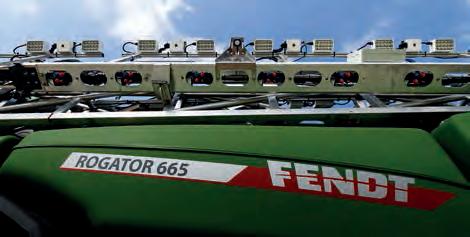
Bogballe makes and sells mounted fertiliser spreaders, while Bredal is focused on high-capacity trailed fertiliser and lime spreaders.
Bogballe and Bredal employ 109 employees split between three factories at the Danish towns of Vejle and Bøgballe that are just 20km apart.
Following the merger, Bredal’s former owners will retain almost 10 per cent of the new business and continue to work for the Bredal brand.

Following two years of field trials, Agco has announced it will integrate and commercialise Bosch BASF’s Smart Spraying technology on Fendt Rogator sprayers and jointly develop additional new features.
The system aims to deliver optimal herbicide savings without compromising weed control and will enable targeted spraying during the day and night-time conditions. In addition to targeted spraying, the system will provide integrated digital tools to turn the application data into actionable insights and improve yields and e iciency for farmers.
Supported crops initially include corn, soy, cotton, canola, sunflowers and sugar beet. More crops, such as small grains, will be added over time.
The new Maxima 3 TIe precision drill from Kuhn will be on a series of on-farm demonstrations in the UK this spring.
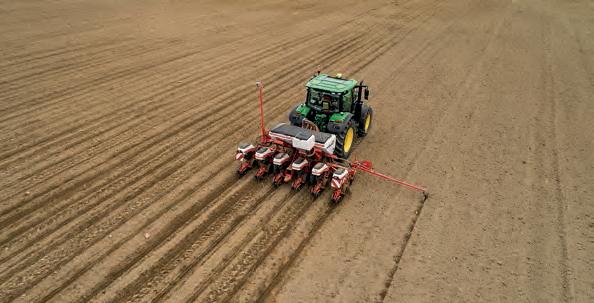
The six-row machine used for the tour is part of a range extending up to 12 rows with a telescopic chassis o ering row spacings from 45cm to 80cm. Electric drive technology enables variable seed rates, which can be changed manually from the tractor cab or as determined by a variable-rate map.
Maxima 3 precision drills are suitable for drilling maize, sunflower, beetroot, sugar beet, peas, beans and other crops at working speeds of up to 10kph.














When others just see another job, you see an opportutnity for greatness. You’re not just building castles in the sky, you’re achieving the impossible. Combining your skills and the right equipment to create things that matter.


Record demand for the Claydon Opti-Till seeding system has led the family-owned business to expand its West Suffolk factory further. The completion of the new assembly building will more than double production capacity and create additional jobs.

The new building, which measures 36m x 36m and 8m to the eaves and features four 3.2t overhead cranes, is the second stage of a grant-aided business development project agreed in 2015 with the New Anglia Local Enterprise Partnership.
County Antrim-based Quad-X has launched a new custom boom for applying liquid fertilisers. It comes with a mounting kit for ATVs, while options for UTVs are also available.

The Quad-X liquid fertiliser boom can be paired with any of Quad-X’s spray tanks and provides a fast and easy way to deliver crucial nutrients to plants, grass and crops. Fertiliser application is possible right to the edge of the crop to avoid losing yields by under-fertilising crop margins.
Pöttinger’s new Harvest Assist app simplifies and optimises logistics while harvesting forage. It works by considering harvesting volumes, the distance between the field and the clamp and optimising compaction performance in the clamp to achieve the best quality forage.
Available for iOS and Android, the app also enables real-time communication using existing hardware; every member of the harvest convoy can install the app on their smartphone for free to provide an intuitive overview for straightforward control of all grassland harvesting machines.

Amazone shareholder and former CEO Dr Heinz Dreyer has died at the age of 90. He joined the business in 1958 and remained central to the day-to-day management of Amazone until he was succeeded by his son, Dr Justus Dreyer, in 2005. He continued, however, to be responsible for Amazone seeding systems.

Firmly committed to research and product development at Amazone, he invented the first ZA three-point linkage-mounted, twin-disc fertiliser spreader and the company’s legendary Amazone D4 tractor-mounted seed drill.
Chandlers Farm Equipment now supplies Horsch’s full range of cultivation, drilling and spraying equipment through its Chandlers RFM depots at Bridgnorth, Ross on Wye, Martley and Raglan.
Spaldings now has exclusive distribution for Dutch Openers tine drill coulters in the UK and Republic of Ireland. The Lincoln-based company previously shared the rights for the Canadian manufacturer’s products.
Merlo has appointed Brompton by Sawdon-based Hardwick Agricultural Engineers to its dealer network. The firm succeeds Yorkshire Handlers, which held the franchise for 27 years.
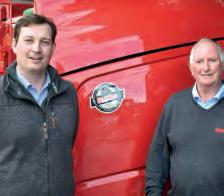




















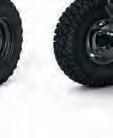

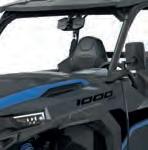

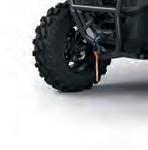



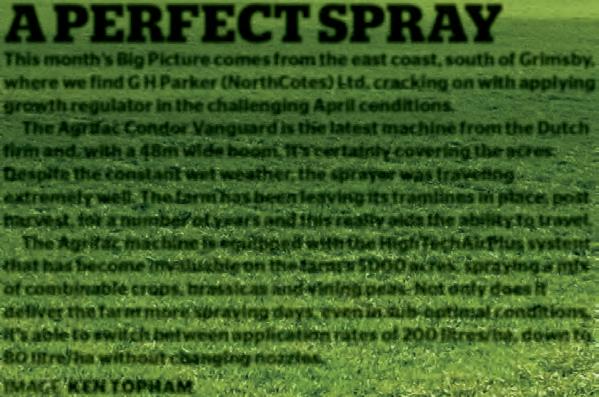
This month’s Big Picture comes from the east coast, south of Grimsby, where we find G H Parker (NorthCotes) Ltd, cracking on with applying growth regulator in the challenging April conditions.
The Agrifac Condor Vanguard is the latest machine from the Dutch firm and, with a 48m wide boom, it’s certainly covering the acres. Despite the constant wet weather, the sprayer was traveling extremely well. The farm has been leaving its tramlines in place, post harvest, for a number of years and this really aids the ability to travel.
The Agrifac machine is equipped with the HighTechAirPlus system that has become invaluable on the farm’s 5000 acres, spraying a mix of combinable crops, brassicas and vining peas. Not only does it deliver the farm more spraying days, even in sub-optimal conditions, it’s able to switch between application rates of 200 litres/ha, down to 80 litre/ha without changing nozzles.


Cereal establishment cost increases drove a Lancashire contractor to look at different sowing methods. W.
Agricultural Contractors bought its first Mzuri Pro-til

and has just bought a second machine
Contracting can be a fickle business, customers often just want you to turn up and get the job done the same way year-on-year. But W. Rothwell Agricultural Contractors decided it wanted to reduce cereal input costs and break away from ploughing and combination drilling.
Working with a handful of customers who were on board, the idea was to have a more efficient drilling system with lower input costs. And the ability to offer cover crop and companion crop establishment options, too.

After looking into some of the other strip-till alternatives on the market, Phil Rothwell decided on the Mzuri, feeling it offered the best combination of build and specification at the time. First job out was sowing oilseed rape in the autumn of 2020, and things have snowballed since. The Pro-til 4T was ordered with two tanks and four-inch double seed coulters, to which they added an existing Sumo seeder complete with a Mzuri spout fitting kit. The ISObus compatible drill is controlled by the New Holland terminal, which is equipped with an RTK GPS reciever.
The Rothwell’s Mzuri’s configuration uses the rear legs for seed, which are spaced at 300mm, point to point with a four-inch double outlet coulter. This places the seeds in a distinctive pattern, two rows around four inches apart, with an approximately 200mm gap in between.
The front legs are typically used for fertiliser or growth product, these could also be used to place companion crops. There are two pipes that can allow seed or fertiliser to be placed at different band widths, depending on requirement. The Sumo seeder can be used for a companion crop or slug pellets, or both.
One of the features Phil specced for his machine is leg lift control for tramline markers. This is because some customers are using semi-

Above right: The coulters create a distinctive sowing pattern, with two close rows 100m apart and a gap to the next
“It o ered the best combination of build and specification”
Left: The Mzuri Pro-til 4T has fully ISObus operation, with section control for headland shut off, all controlled via the tractor screen.
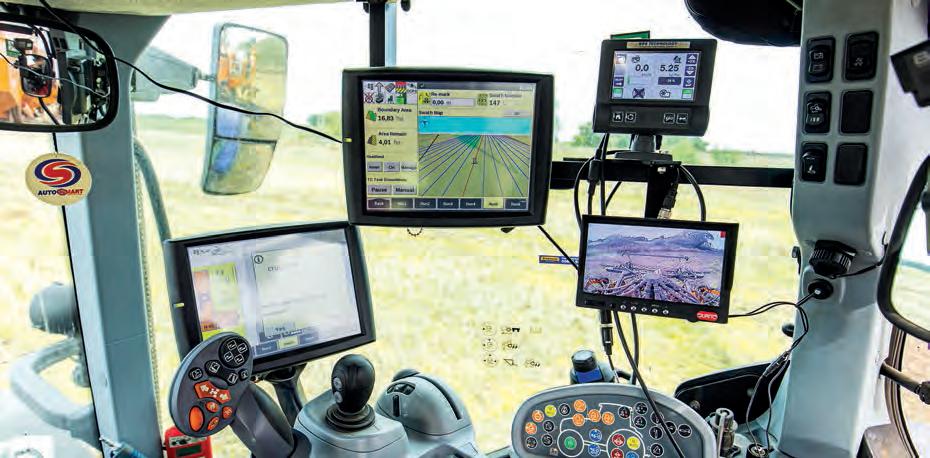
Mzuri Pro-til 4T
Working width 4m
Pulled with New Holland T7.270
Used for Sowing wheat, OSR, barley. Control system ISObus
reduced traffic control in their rotations and need to leave them undisturbed.
“We’ve had great feedback about not ripping up tramlines, particularly this spring, where the sprayers are traveling reasonably well considering the rain we’ve had,” he explains. “I’ll usually map the field boundary, then work off the previous year’s tramlines stored in my drilling data, lining up where the liftable legs are on the drill,” Phil explained.
We saw the machine working, sowing wheat into OSR stubble that phosphate fertiliser going down the front legs. This left a finish, which when the drill was new drew a few comments: ‘bit rough that isn’t it?’. It’s water off a duck’s back these days.
The proof is in the pudding, when some of the first wheat Phil drilled yielded 11.9t/ha attitudes to the post

drilling aesthetic changed. The strip-till finish has become the norm and interest in the system has grown. Customers already on board are happy and a few field visits from those wanting to know more were common in the first season.
The Pro-til provides three possible application methods, the six front legs are fitted with individual suspension and are typically used for banding fertiliser products and clearing residue. The second row is for seed placement and are also suspended individually. Lastly, the Sumo seeder feeds the third row for broadcasting cover crop seed and applying slug pellets.

A trial the Rothwell’s are working on with a customer involves sowing oilseed rape with a mix of slug pellets
and clover through the Sumo. “The clover companion crop is a variety that dies with frost, but we didn’t have any good frosts the first year, so it was only knocked a bit, which actually didn’t affect the OSR,” says Phil.
He explains the oilseed rape managed to get going while the clover was not thriving. This provided cover and kept the pigeons off while the oilseed rape was at the vulnerable stage allowing it to grow up and smother out the clover.
Section control on the Pro-til individually shuts off each tool –fertiliser, seed and broadcaster – at the
Top: The front leg is usually used for fertiliser products, with two pipes to provide different band widths

Above: The Rothwell’s drill is equipped with the four-inch double outlet coulters, which are spaced at 300mm point to point

headland, all working to the same boundary. While it doesn’t offer individual coulter shut off, they match up perfectly because the distance between the front legs and the last element on the drill are programmed into the GPS. Everything runs through the tractor and drill’s ISObus systems.
Seed and application rates are controlled by two separate metering units. These use a variety of seed wheels to deliver the desired rates. For example, the phosphate could be going on at only 10kg/ha with wheat




being sown at 190kg/ha.
In reasonable conditions the Mzuri Pro-til 4T can cover 5.1ha/ hr. Fuel consumption for its host New Holland T7.270 ranges from 9 lit/ha, in optimum conditions, up to 12 litres/ha in ground that may have been compacted during harvest. The tractor is running on Trelleborg TM900 650/75R38 rear and 600/65R28 tyres on the front, which give a good balance between traction and soil protection.

Centre inset: Getting used to a less uniform finish is, for some, still a learning curve, but once the crop is growing it’s soon forgotten
Above inset: While a seed hopper camera is a good idea, it’s too dark to see inside. An LED light would help, but Phil’s brush modification works well
Left: The secondary hopper is an option ordered by Phil. He has specified the same set up on the new machine
An existing
was
A camera, monitoring the drill’s seeding section, allows Phil to see if there are any issues with residue blockages. A second camera, in the seed hopper, is there to check the contents, but he says, with the lid shut it’s too dark to see anything.

An LED light inside or a window in the lid, would solve this. Currently the Rothwell fix is to prop the lid open with a small hand brush. This doesn’t allow much dust in, but offers enough light to see the seed.
The wearing metal, naturally, takes
“We’ve had great feedback about not ripping up tramlines, particularly this spring”Right: Sumo seeder mounted with a kit from Mzuri that attaches the plates to the following harrow
some punishment – but it’s only the drill and not on a plough and drill as well. The 11 front legs have two wearing components, the point and wing, which cost about £150 to replace (per leg) and usually last about 350ha. At £4.71/ha each, the seed coulters are doing 750ha at a
cost of £1.02/ha in steel. Phil is currently using genuine parts.
While compared with plough points the wearing parts are not cheap but the system is not the same. It is producing gains from fuel consumption savings, output and access to weather windows.


Phil is impressed with how well the drill performs its primary function – putting seeds in the ground. “The control over depth is very good, each coulter has its own down force mechanism, so it’s very consistent. The closing/depth wheels work very well, we’ve never had any stalling or blocking problems.”
Seed-to-soil contact is also good, with the legs creating enough tilth to get crops established without causing all of the topsoil to move.

Being an early adopter is always risky, although strip till isn’t a new concept. In Phil’s area there is a variety of farming and cropping, where the easy answer is to plough. So far, he’s managed to sow into every type of residue presented, and the sceptics are coming around.
Existing customers have all settled into the concept, and a second Mzuri Pro-til 4T is on its way, not to replace, but add capacity to the first machine. The only di erence with the new one is the addition of a double following tine harrow.























All fuel consumption and emission values are based on the new WLTP (Worldwide Harmonised Light Vehicle Test Procedure) test cycle which uses real-world driving data. Official fuel economy for the standard Isuzu D-Max range in MPG (l/100km): Low 25.1–27.6 (10.2–11.2). Mid


Lancashire-based Wannop Farms Ltd fully utilises John Deere HarvestLab to save on nitrogen and achieve better use of their slurry. The business has been working with its local dealer to maximise their manure
HarvestLab has been around for a number of years and it’s now not unusual to see the NIR sensor mounted onto the chute of one of the John Deere’s forage harvesters.
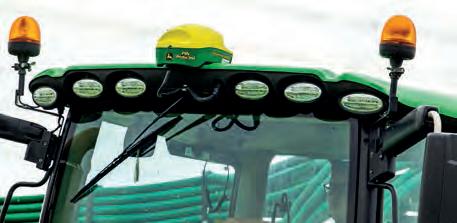
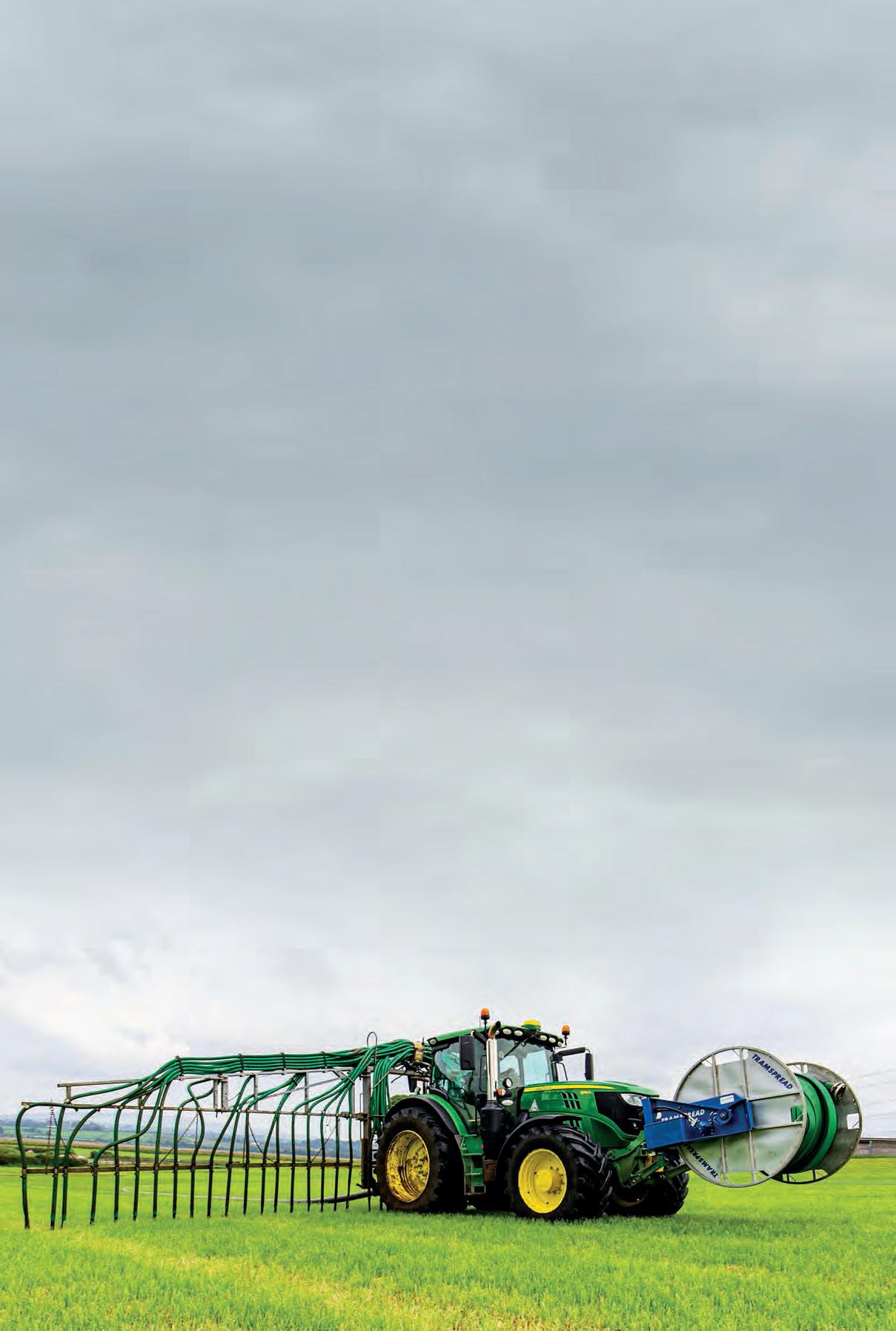
As well as measuring forage sugar, protein, starch, metabolisable energy and ash content of the crop, correctly calibrated, it will also log the yield. But the same sensor can also analyse slurry and many applicators have a blanked off aperture to accommodate sensors.
Some would wonder why we need a fancy sensor to spread slurry. But, since nitrogen prices have risen since the invasion of Ukraine, along with every input cost, it’s never been more important to look at how best to utilise on-farm commodities. In slurry, HarvestLab can read levels of nitrogen, phosphate and potash, and takes 4000 measurements/sec.
Wannop Farms currently milks 520 cows, give or take along with young
stock they have nearly 1,000 mouths to feed. With that scale comes the ability to be self sufficient in many field operations. Significantly the grass harvest, running its own mowers tedder and rake along with a John Deere 8300i, which was equipped with the HarvestLab sensor and Starfire 6000 receiver.
Silage making
The farm takes four cuts of grass silage a year, totalling 1750 acres. Usually starting early May, its latitude in Morecambe and proximity to the coast dictating the growth of grass and how early it can cut.

Grass mowing and tedding are done in short time frames, aiming for a short wilt and 30-35 per cent dry matter at harvest, striving for the best quality they can achieve. The grass lays don’t usually contain clover, because the farm aims for good weed control in the grassland. Wholecrop from wheat and maize are also part of the ration.
Wannop Farms still measures silage quality from the clamps by having samples testec because it feels the HarvestLab isn’t quite there with accuracy when used as a standalone test station. But on the forage
harvester it’s delivering information that is steering decision making at grass variety level.
“We did some hybrid variety reseeds in 2021, and the protein levels were disappointing at harvest 2022. We’re used to seeing 13-14 per cent and the reseeds were down to 9-10 per cent, they yielded very well, but the quality wasn’t there,” Joe
WORDS AND IMAGES KEN TOPHAMAbove and top: The telemetry is key, the StarFire 6000 receiver connects the forage harvester and spreading tractor to the Operations Centre software
“Some would wonder why we need a fancy sensor to spread slurry”
Near infrared spectroscopy uses an infrared light source – that is reflected o the material passing before it. A sensor picks the light up and, depending on the reflected spectrum, it determines what the measurable constituent parts are. The information collected is compared by HarvestLab’s software against data from thousands of analyses of either crops and slurry to accurately determine what the sensor is seeing.
It is impressive to see the John Deere technology at work and delivering measurable results. It has involved a steep learning curve for Wannop Farms Ltd, and a not insignificant capital investment, but they are utilising the equipment for both ends of the cow and connecting the dots of harvest and manure with technology.


Wannop explains.
Additive application on grass silage is also an area where the HarvestLab also has an impact, with the correctly calibrated forager yield monitor the farm helping to deliver a 25 per cent saving. Silosolve SC, which is the farm’s additive of choice from CHR Hansen, works well on all of the forage types grown for the ration.
The accuracy from the system, applying the correct volume every load according to yield measurements taken second by second, has seen more consistent fodder at feed-out too. This is further helped by the variable chop length, with the JD
This picture: With auto-steer and automated forward speed, Joe steps in at the headlands to make the turns
8300i changing from a shorter chop in higher moisture crops, to a longer chop when the grass is drier.
Precise slurry spreading Slurry application, although still seen as a bit of chore, is now becoming a specialist job as more farms recognise its nutrient value. The Wannops have looked closely at every aspect of the operation from storage to spreading.



Monitoring applications from data transferred via the JDLink telemetry system some big differences in the nutrients available from different slurry consistencies. In one field they found a big reduction in nitrogen on
1 The map shows an ideal application of slurry, where the target rate of nitrogen is consistent across the field.
2 Neglecting to properly stir the store can affect the consistency of the nitrogen application as this map shows – with the poorly mixed slurry on the left.
3 A yield map created by HarvestLab on the forage harvester, the next step will be fertiliser application to balance out yields.
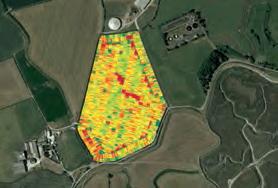
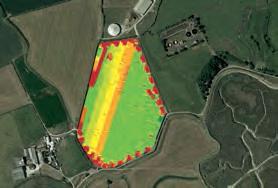


the half applied with slurry that had not been stirred, compared with the other half that received material.
Since then the farm has taken to adding water to the stores when necessary and ensuring they’re fully agitated before they reel out any pipes to start spreading. The above-ground stores had built-in stirrers built and one is covered, providing almost perfect control of consistency.
Equipment is key.
Wannop Farms runs its own slurry kit, using a John Deere 6155R with auto-steering and AutoPwr transmission, which pulls an Agquip 12m dribble bar applicator, with a Vogelsang macerator. This is fed by 5-inch pipes, connected with Storz couplings. These have universal ends that makes it more convenient to reel in by the Tramspread front-mounted reeler, which was new in 2022.
Currently the pump is a tractordriven Doda HD35, but a self-propelled unit with telemetry is under review in the farm’s equipment update policy. This would enable the pump to be controlled from the spreading tractor and release an operator from having to be with or near the pump system.

The spreading tech utilises HarvestLab – swapping it over from the forage harvester to the dribble bar takes about half an hour. A Krohne flowmeter is fitted in-line after the HarvestLab sensor while a John Deere SF6000 receiver provides GPS positioning. Importantly a JD Link Modular Telematics Gateway wirelessly connects everything to JD
Operations Centre software, which collates the data in one place.
Employing the data in a meaningful way is the key piece. The farm adds yet more data to the equation with soil sampling that is tied in with yield maps to create slurry application prescriptions. These maintain the target nutrient rates by allowing the data coming from the HarvestLab, which is prioritising nitrogen content, to control the speed of the tractor.
Working to target rates the farm typically applies 40m3 of slurry, before first cut and 30m3 between cuts, which equates to the equivalent of 74-75 units of n/ha of nitrogen, respectively.



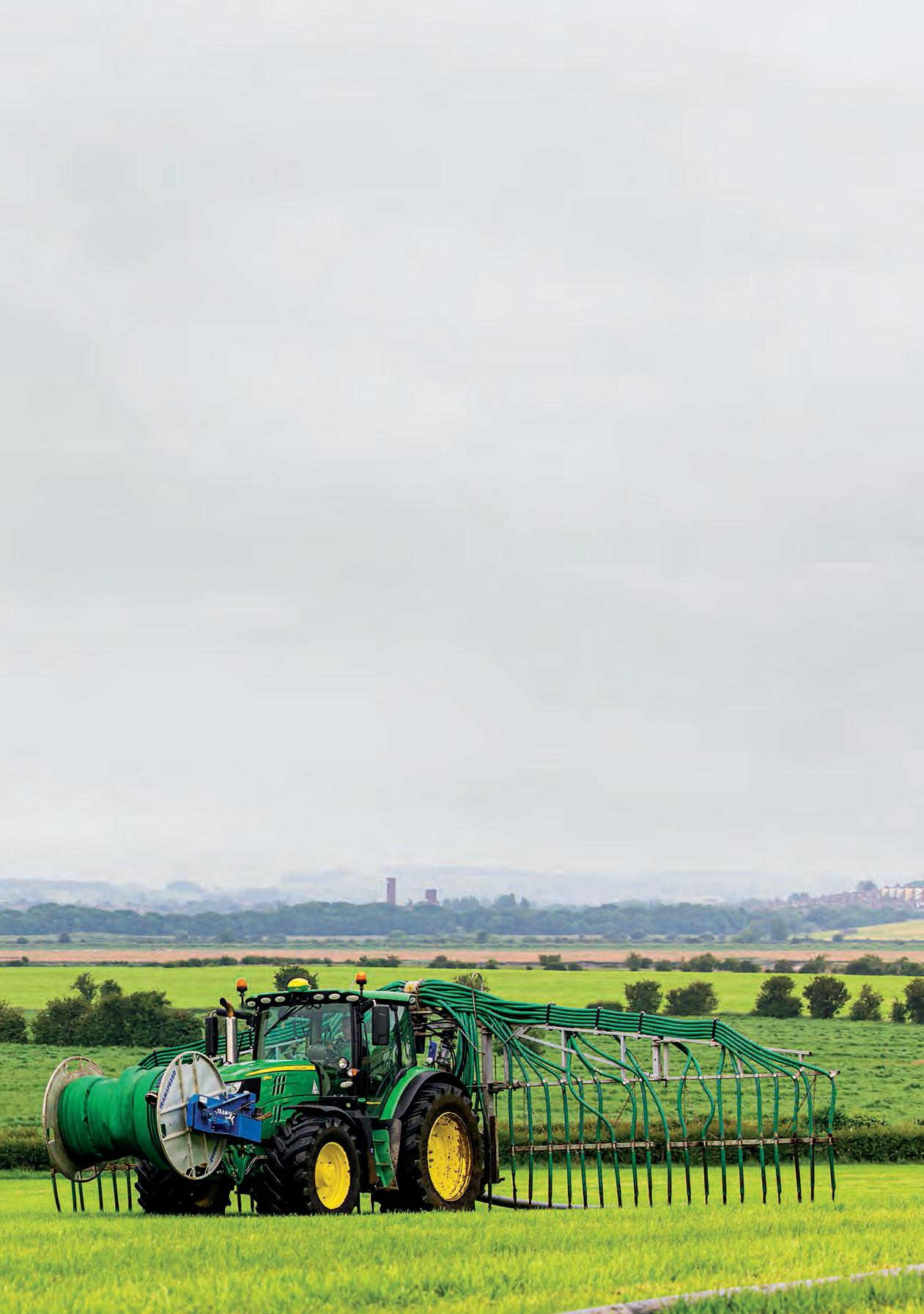
With the accurate application Joe reckons to have saved 6t of bought in nitrogen for the first cut alone, with that figure slightly dropping for the subsequent cuts.
The next step for the farm’s bought-in fertiliser will be to create prescription maps that will take yield maps created by the forage harvester into consideration with the aim of balancing out the field’s high and low points.
ACKNOWLEDGEMENTS Thanks to the Wannop family for showing us their system – David and Annette working together with sons Joe and James. Tim Hodkinson, harvest specialist from Cornthwaite Group, who shared the screen data from the John Deere Operations Centre to visualise the workings of the set-up.
“Employing the data in a meaningful way is the key piece”Left: John Deere’s tractor mounted 4600 screen set to spread slurry, with the target rate of nitrogen controlling forward speed Right inset: Joe Wannop is the usual pilot on the forage harvester and slurry applicator Below left: A 4640 screen in the forage harvester displays the yield and key information about dry matter, protein and sugar in the grass









Earlier this year north Nottinghamshire-based contractor George Roworth took delivery of four new John Deere 6R 185 tractors and a 7R 350 Gen II to replace his Fendt and Massey Ferguson frontline fleet. FMJ discovers why he switched brands and what his operators think of their new tractors

George Roworth has been involved in agricultural contracting for more than 20 years. Based in north Nottinghamshire, he originally set up RBContracting with his brother Henry in 2004. The arrangement was demerged in August 2019 so both could develop their own businesses separately.

George specialises in straw-based services running Krone, Massey Ferguson and New Holland big square balers, while he also runs three bespoke Jones Engineering Ltd straw layers for the over-.wintering protection of root crops such as parsnips and carrots. Other key services include
spraying with a pair of Bateman RB35 self-propelleds, while ploughing, cultivation, drilling and hedge-cutting are also carried out. plus spring root crop tasks such as destoning, bed forming and tilling.
Vario tractors
Until a month ago George and his dedicated team of operators carried out all of this work with an AGCO-based fleet of tractors centred around a pair of 240hp 2014 and 2020 Fendt 724 Vario tractors that had clocked 8000 and 4400 hours, respectively. The two 724 Varios were supported by a pair of older 200hp 2010 and 2011 Fendt 820 Vario tractors that had clocked almost 30,000 hours between them and were
fitted with Quicke Q76 and Q78 front loaders. These tractors spent most of every summer carting straw behind George’s three big square balers.
Heavy draft work and baling with a Krone 1290 HDP was carried out by George’s fleet flagship, a 2018 400hp Massey Ferguson 8740S that had clocked 6000 hours. It was this particular tractor that turned out to be the catalyst for George’s switch to John Deere.
“The 8740S was a decent tractor that was exceptionally good at putting its power down through its 8.4-litre Sisu engine and Dyna-VT constantly variable transmission. I came close to replacing it with another highhorsepower Massey Ferguson tractor,” says George. “My operators really liked its cab and control layout, while it also represented excellent value for money.”
“However, over the course of last year we
“The 6R 185 comes with a class-leading powerto-weight ratio”WORDS AND IMAGES DAVID LALEY
began experiencing a number of niggling problems with the 8740S. By the time I was ready to replace it my local John Deere dealer, Ripon Farm Services, came back to me much quicker with A significantly cheaper quote than my existing AGCO dealer to replace the Massey Ferguson 8740S and my pair of Fendt 724 Varios.”
“I’ve been a John Deere customer in the past and started out contracting in 2004 with a 135hp 6820. I’m also a huge fan of their high specification AutoPowr constantly variable transmission that I had fitted to the vast majority of John Deere tractors I previously operated, including the 6820.”
Dealer back-up
Other factors that persuaded George to switch brands included the location of Ripon Farm Services’ nearest dealership at Clarborough, just six miles away from his yard, and their comprehensive dealer network throughout North and East Yorkshire.
“A large proportion of the work I carry out for root crop growers such as Huntapac takes place in these areas. When you’ve a new fleet of tractors working a long way from home for a significant length of time it gives you an enormous amount of comfort knowing that they’re going to be taken care of at a moment’s notice by the dealer who supplied them,” George explains.
His brand-new fleet of John Deeres comprises four 234hp 6R 185s, two of which are equipped with the optional panoramic cab roof for loader work, and a 388hp John Deere 7R 350 Gen II to replace his Massey Ferguson 8740S. “The 6R 185s have become the natural successors to the Fendt 724 Varios, while the pair of older Fendt 820 Varios have now entered semiretirement,” he says.
“All four 6R 185s are currently destoning with Grimme CS150 and CS1700 separators, plus bed tilling and carrot drilling. They will also be expected to carry out all of the straw spreading in the winter and spring months, before going baling in the summer with my Massey Ferguson 2290 and New Holland BB9090 big square balers. The two 6R 185s I’ve specified with the panoramic cab will be equipped with Quicke loaders in readiness for a busy summer following the balers round taking over straw-carting duties from the Fendt 820 Varios.”
John Deere launched its range of revamped small-frame, mid-frame and large-frame 6R series tractors towards the end of 2021. Farmers in the UK were given a first glimpse of their much-anticipated new model, the 6R 185, in the first quarter of last year at various demonstration events hosted by John Deere dealers, including Ripon Farm Services.


The 6R 185 is John Deere’s new high power-to-weight ratio flagship model in their mid-frame 6R range that also includes the 6R 165, 6R 155, and 6R 145. All four tractors feature a 2.7m wheelbase and come equipped with John Deere’s proven 6.8-litrre PowrTech PVS engine that’s matched to the 50kph AutoPowr constantly variable transmission in the 6R 165 and 6R 185 models.
Weighing just 7.9 tonnes and equipped with an engine that boosts to a maximum 234hp on the road and at the power-take off shaft, the 6R 185 comes with a class-leading power-toweight ratio that’s ideally suited to the work George and his team carry out. “Prior to investing in the 6R 185s I’d demonstrated a large-frame 6215R with over 250hp on tap. However, it’s larger dimensions and additional cab step meant it wasn’t quite nimble or convenient enough for straw spreading, a task that requires the operator to be in and out of the cab a lot,” explains George.
“I was then given the opportunity to run a smaller 6155R, which at the time was the top of the range mid-frame 6R series tractor John Deere offered. While I loved its specification and compact dimensions, I wasn’t convinced that it was the most suitable like-for-like replacement for the higher-powered Fendt 724 and 820 Varios I was running, and I questioned if it would be the appropriate tractor for a strenuous day on a triple bedformer.”
“I can even recall suggesting to Ripon Farm Services at the time if only there was a more powerful mid-frame 6R available with the AuoPowr transmission. That’s when I was told the 6R 185 was just about to be launched. My eyes lit up and I knew straight away that it would be the perfect fit for my fleet.”
John Deere’s AutoPowr transmission is capable of maintaining a pre-selected speed
Since they arrived just over a month ago, George Roworth’s fleet of new John Deere 6R 185 and 7R 350 Gen II tractors have spent most of their time preparing beds for carrots and parsnips in East Yorkshire

between 0.3kph and 50kph in two speed bands by automatically adjusting to load changes. Once running at maximum road speed, the tractor’s engine rpm drops instantly to the minimum level required to maintain that speed, saving fuel and reducing running costs in the process. The transmission is controlled through John Deere’s new CommandPRO joystick that features 11 customisable buttons to control engine speed, front and rear linkages, spool valves and ISObus functions.
“It’s a fantastic transmission to
Above: The 6R 185’s category 3 rear linkage is capable of lifting up to 8100kg at the hook ends and has no issues lifting and powering this impressive Jones Engineering triple bed formeroperate and ideally suited to low-speed power take-off tasks such as destoning and bed-tilling,” says operator Karl Bunning. “The new CommandPro joystick falls easily to hand too and is simple to use.”
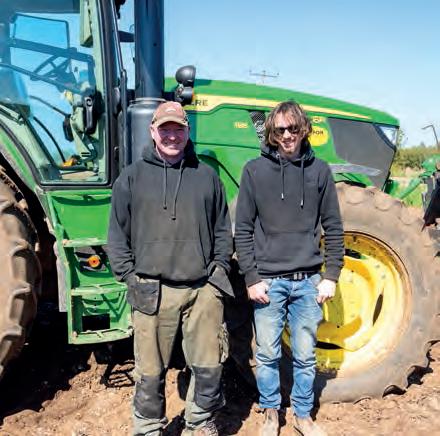



George’s operators say they’ve become immediate fans of John Deere’s revamped 71d(BA)
ComfortView cab, which features a fully adjustable swivelling seat with lumbar controls, a new A-pillar corner post display screen and additional storage space. “It’s a wonderful cab to spend long hours in and the rotating

Location Beckingham, North Nottinghamshire
Core tasks Large square baling, bale chasing, haymaking, straw laying, root crop establishment, ploughing, cultivating, drilling, spraying and hedge-cutting
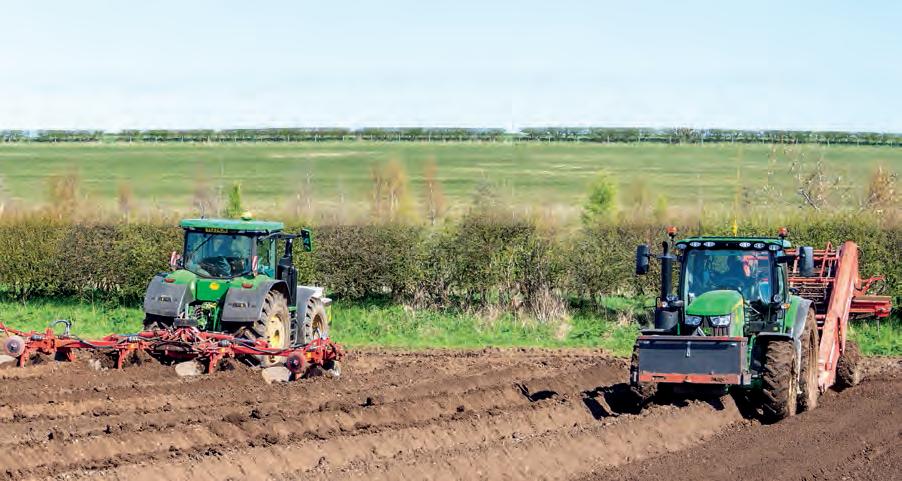
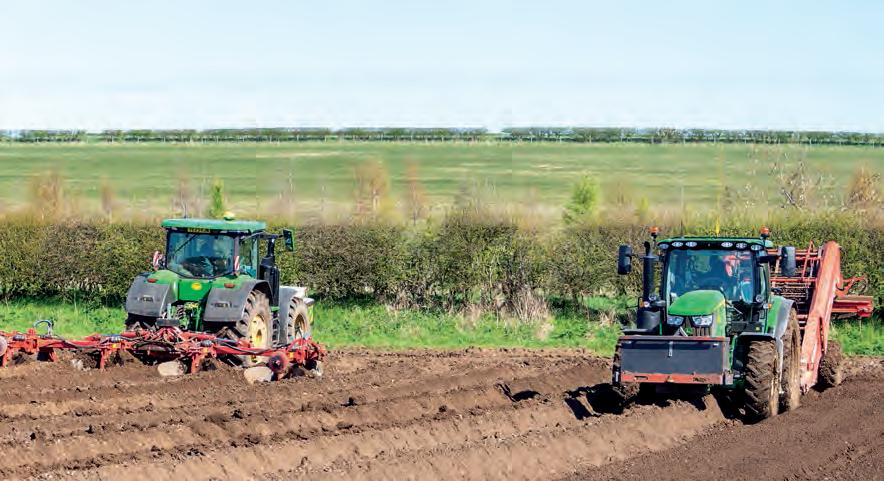
Frontline fleet
● 2023 John Deere 6R 185 x 4
● 2023 John Deere 7R 350 Gen II
Above left: George and his operators have been very impressed with how easy to configure John
seat enables you to operate the destoner and look out of the rear window to monitor its performance without unnecessarily straining your body,” says operator Tom Kemp.
functions
Above:
designed and thought out
John Deere’s CommandArm control console situated to the right of the operator’s seat comprises the CommandPro joystick and Gen 4 CommandView touch-screen performance-monitoring terminal. It can be used to run John Deere’s AutoTrac automated headland management system, ISObus controls and provide wireless connectivity to

the company’s CommandCenter.
“We’re determined to make the most of the additional automation, telemetry and technology the CommandCenter provides us with,” says George. “We’ve already begun to use the system’s Machine Sync function that enables all of the tractors to be linked together and automatically communicate with each other. I can also check their performance and operational status though my phone and office PC so as a team we can manage and run each tractor more efficiently.”
“It puts its power down exceptionally well”Deere’s new CommandPro joystick has been. The joystick is used to control the AutoPowr constantly variable transmission and the tractor’s main hydraulic Operator Tom Kemp says the 6R 185’s Comfort View cab has been exceptionally well Left inset: Operators Karl Bunning and Tom Kemp have been very impressed with the levels of comfort George Roworth’s new John Deere 6R 185s offer
Heavy draft work is now carried out by George’s compact 11.4-tonne John Deere 7R 350 Gen II introduced in July 2020 to head Deere’s revamped 7R range that was originally launched at Agritechnica in 2019. The range features styling and several useful creature comforts designed by automotive firm BMW.
The 7R 350 Gen II is powered by a nine-litre PowerTech PVS engine rated at 350hp. It’s capable of boosting to 385hp in the field and 388hp on the road and at the power take-off shaft courtesy of JD’s Intelligent Power Management (IPM) system.
“The 7R 350 Gen II was the logical replacement for the Massey Ferguson 8740S,” says George. “While it doesn’t have quite as much horsepower as the 8740S it’s still a very capable ploughing and bed-forming tractor. Also it’s much more suited to the large amount of road work we complete between jobs thanks to the AutoPowr transmission and its slimmer dimensions.”
Operator Jimmy Emmott has been equally impressed with the 7R 350 Gen II since switching from the seat of the 8740S. “It puts its power down exceptionally well. Although I really liked the 8740S’s control layout, overall the 7R 350’s Next Generation cab is much more refined and well thought out,” he says.
Externally the four-post cab on George’s 7R 350 comes equipped with John Deere’s 360-degree lighting package featuring up to 28 LEDs and electrically operated telescopic mirrors. Inside, a slim-line fully

Right: The 7R 350 Gen II’s category 3 rear linkage is capable of lifting an impressive 13010kg
Below right: The Next Generation cab comes equipped with a 6.5in touch-screen digital radio and controls for the tractor’s convenience lighting package designed to illuminate around the cab at night so tasks such as refuelling can take place safely and efficiently

Below: The 7R 350 Gen II is powered by a nine-litre, six-cylinder turbo-charged John Deere PowerTech PVS engine rated at 350hp, capable of boosting to 385hp in the field and 388hp on the road
seat can also be rotated up to 40 degrees to the right and 25 degrees to the left. “It’s a fantastic office to spend the day in, and thanks to its AutoPowr transmission that features four customisable modes its equally at home on the road or carrying out heavy draft work,” says Jimmy.
So far George’s fleet of five new John Deere tractors have each clocked just over 100 hours without any problems.
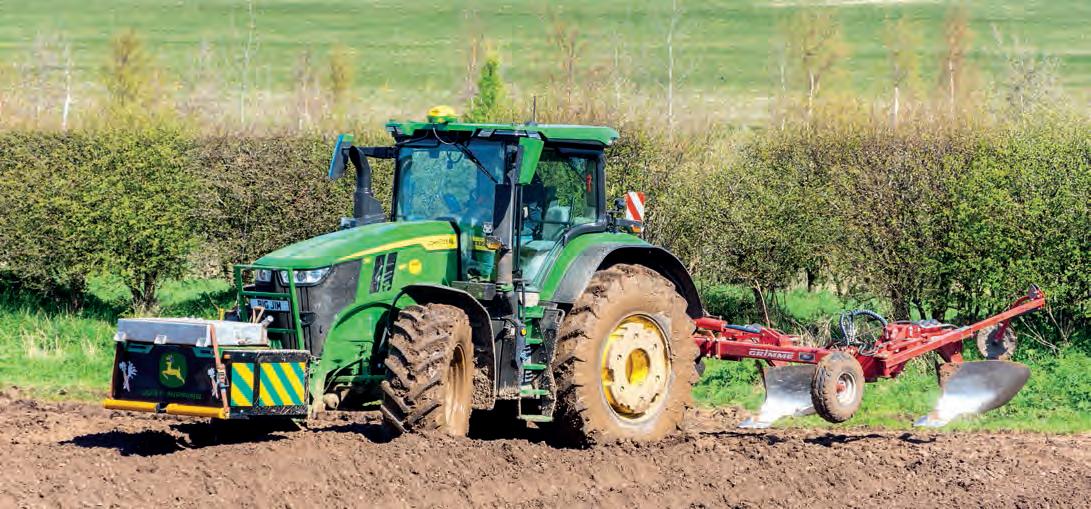
Below left inset: Jimmy Emmott currently operates George Roworth’s John Deere 7R 350 Gen II and has been delighted with its performance on the road and for heavy draft work


adjustable steering column provides additional forward visibility and is also fitted with a useful set of foot pegs.
Other notable features inside the cab include a touch-screen digital radio linked to a brand-new audio system incorporating six speakers, and John Deere’s ventilated ActiveSeat II featuring electric suspension and a built-in massage system. The Active II
“We’ve all been very impressed with them, their specification and AutoPowr transmissions. Power-toweight ratios are ideally suited to the power take-off drive, the draft and road work we carryout, while their cabs are among the best on the market today,” says George. “I’m aiming on keeping them at least three years before I contemplate replacements.”
ACKNOWLEDGEMENTS Thanks to George Roworth and his operators for their time and assistance with this feature.
“Creature comforts designed by automotive firm BMW”






To achieve quality forage, you need to get the most out of your machinery. Innovation that will drive performance up and efficiency that won’t let you down.

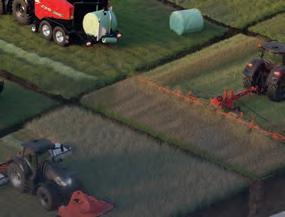


gofurtherwithyourforage.kuhn.co.uk/events/ Scan the QR Code to visit the ‘Find your local event’ website page

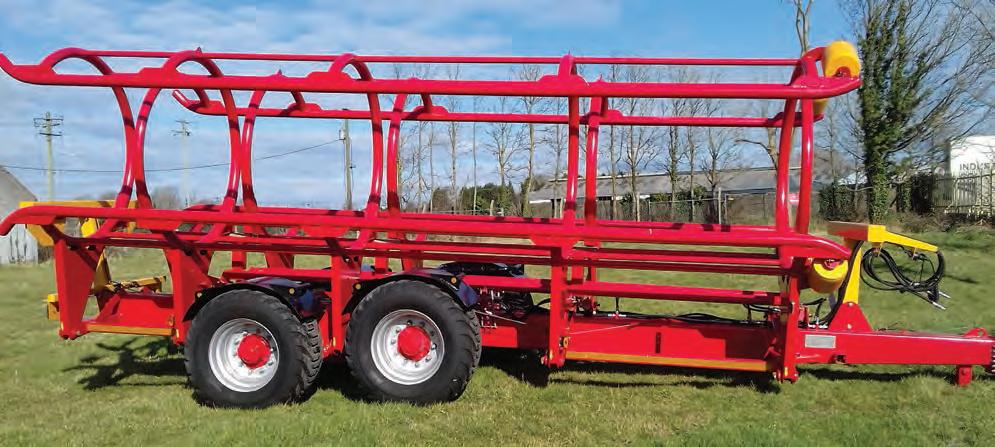














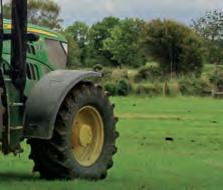







Showing wisdom beyond his years, one young Irish contractor has achieved much in his first five years of operation.
Beginning in 2018, at the age of just 18, Kelum Harrington initially concentrated exclusively on hedge-cutting, based on the local need for a dependable service.
Seasonality of hedge-cutting meant diversification was needed to ensure continued work through the year.
Expansion into slurry spreading and more recently a zero-grazing service has proved particularly popular and brought much additional work to the Monsea, Nenaghbased operation that serves North Tipperary and across the border into parts of County Offaly.


Motivated to build a contracting operation, the first move came with the purchase of a McConnell PA6500T EDS hedge-cutter and a used 2013-registered John Deere 6150R tractor. Representing a sizeable investment for a newcomer, buying used kept costs to a modest level without compromising performance and reliability.
“There were already lots of others doing contracting in this area so the only way to build up a customer base is to offer the best service possible,” Kellum says. “It all comes
Above: For optimal weight distribution, the Keltec Ten Pack must be loaded in a pre-defined fashion. Kelum has developed his own technique for bale handling to ensure the process is completed without damaging the plastic bale wrap
down to keeping the promises you make and doing the job to the highest standard, which helps build customer loyalty.”
Based on these values, gradually building the business by growing the services offered was a crucial move.
Moving into new areas meant tractor expansion was also needed. This resulted in the original 6150R being complemented by a 2017-registered John Deere 6155R, which carries a particularly high level of specification. This is mandatory requirement for working in an intensive contracting operation.
“At peak times we have run the tractors up to 24 hours straight, which has piled on the hours.
Below: No time is lost securing the load for road travel as all ten bales are held gently but securely in the unit
Both have been trouble-free, evidence of the quality and reliability built into John Deere. The 6150R is the real money-maker, as it has 15,000 hours now and is still
Establishing a new agricultural contracting venture is clearly a major undertaking. It calls for a shrewd approach to identi cation of local niche requirements and tactful machine selection to ensure the highest return on investment
WORDS AND IMAGES EOGHAN DALY
“TRACTORS AND MACHINERY WERE ALWAYS A PART OF MY LIFE FROM THE START”
going strong. Since getting the 6155R, the level of spec it has brought has really helped me get through work and eased the pressure over long hours.
“Both tractors have been really reliable and the only spanner I’ve put on them has been to the sump nut to let off the oil to service them. I service the higher-hours tractor every 350 hours and the 6155R every 450 hours, which is the key to keeping them up to the job long term.”
This operational competence is especially manifest in the tractors’ ability to handle the 16,000-litre tankers running on tandem axles with a trailing shoe system. “Longer hauls have become common as many dairy farmers rent land. We are also seeing an increased demand for drawing and spreading pig slurry as fertiliser has become so expensive over the last year. Having tractors that can cope with these high capacity tanks is a must and both have plenty of power to handle this kind of work.”
In addition to the contribution of the John Deere duo, the tanker design also has a major positive influence. Having looked at many different manufacturers’ machines, the willingness of Conor Engineering to build a truly bespoke machine ensured they emerged as the most appealing supplier. Such was the success of the initial high specification tank that a second unit has just entered service. Its design has been refined slightly with some minor changes to the filling point specification on the latest model.
Thanks to their high capacity 13,500 litre pumps, the tanks are filled using two filling hoses in just two minutes. Also, during spreading, the design of the trailing shoe system especially in the crucial areas of the stone trap and macerator makes for continuous user-friendly operation.
As slurry spreading using these low emissions tankers brings a considerable work stream, many dairy farmer clients were looking for a more complete service to include zero-grazing. In response to this Kelum purchased a French-built Belair Gabare 2030-2 zero-grazer. While the machine worked well enough, its reliability soon became a concern. As the workload continued to grow, the best overall option was to supplement it with a new Feed All machine manufactured by County Kilkenny-based Desmond Condell Engineering.
After using the Feed All unit for a whole working season, it has proved to be everything that was first expected with its build quality reflecting the needs of intensive contractor utilisation.

As the zero-grazing element of the business proves to be a considerable success, another important diversification was soon made to provide an even more complete service. Noting how an opportunity for an umbilical slurry-spreading system existed at local level. Following assessment of several manufacturers’ products, County Down-based Slurry Quip were recognised as offering one of the more feature-rich systems. Designing and manufacturing umbilical
Above: The Feed-All zero-grazer has low ground pressure thanks to the optimal weight distribution and tyre selection, which results in minimal compaction and ground damage

Right: Even heavy loads of grass with a high moisture content are unloaded in a reassuringly fast and competent way thanks to the three-chain drive design and staggered unloading slat mechanism

 Above: A co-ordinated approach makes loading the Keltec Ten Pack bale chaser extremely fast and one of the most efficient means of handing and hauling bales in a self-contained fashion
Above: A co-ordinated approach makes loading the Keltec Ten Pack bale chaser extremely fast and one of the most efficient means of handing and hauling bales in a self-contained fashion
“THE WORKLOAD IS STARTING TO BECOME TOO GREAT FOR JUST TWO TRACTORS”
systems since 1994, this experience was evident in the quality and functionality of their equipment.
Evaluating Slurry Quip’s diverse range, Kelum decided on a 12m dribble bar with integrated reeler. The system is governed by a Slurry Quip flow meter system with an in-cab monitor. Further demonstrating the comprehensiveness of the specification, the combination also uses a front-mounted Slurry Quip 1200 pivot reeler unit. Operation of the front reeler is by a pedal on the host tractor’s floor, so as the hose is being fed back to the reel, activating the pivoting action of the reeler means the hose is spread evenly across the reel surface, which makes for much faster and less labour intensive retrieval of the pipes. Coupled to a high capacity Bauer pump, the system has proved its abilities over longer distances, as sufficient pipe length is held to cover over 2.2km.
The ability to cater for such a distance has been proven on a number of occasions, though there is a significant level of set-up involved. Once operational, vast volumes of slurry can be spread in an uninterrupted working cycle. “We have pumped slurry over 2.2km in distance, including across two public roads. We have traffic ramps for these crossings and the capacity of the slurry pump means it has no problem covering this kind of distance.
“It’s just a case of setting the spreading rate and using
the 6155R’s auto-steer, it’s a very user-friendly way of working. We use a 6in draw hose and have 4 1/3in drag hose for more challenging conditions.”
To ensure the whole package is as self-contained, allowing movement between locations by just the two tractors, a PTO-powered compressor is utilised, which was sourced from Applied Concepts Ltd based at Birr, Co. Offaly. Even though the Applied Varimount 350 compressor can be mounted on either the front or rear linkage, it is favoured for front-mounted operation, leaving the rear PTO free to cater for the slurry pump.



In addition to the slurry-spreading and zero-grazing interests, another niche service was introduced for the 2022 silage-harvesting season after a new Keltec bale chaser was purchased.
While a growing number of services are offered and provide work throughout the year, more avenues are still being evaluated . However, for the immediate term, the next investment will be tractor orientated. “A third tractor is the next purchase with a new one coming during the year ahead. The work load is starting to become too great for just two tractors so a third is a must at this point. Even though it is a significant cost, reinvesting in the business is vital going forward.”
 Having used other manufacturers’ machines at the outset, the transition to the Irish-made Feed-All zero-grazer has resulted in a much greater level of performance and reliability
Harrington Agri’s zero-grazing service on the lands of one of their larger dairy farmer clients near Puckane, County Tipperary
Having used other manufacturers’ machines at the outset, the transition to the Irish-made Feed-All zero-grazer has resulted in a much greater level of performance and reliability
Harrington Agri’s zero-grazing service on the lands of one of their larger dairy farmer clients near Puckane, County Tipperary
Working a custom harvest in the US can be a dream come true for many young farmers. The most celebrated and well-known way is through the Ohio State University programme. But with other organisations now o ering support, Paul Hore of Harvest Support USA UK tells FMJ how to turn a dream into reality
 WORDS PAUL HORE AND DAN COLOMBINI IMAGES LAURA HAFFNER/PAUL HORE/JAMIE McCORSKRY
WORDS PAUL HORE AND DAN COLOMBINI IMAGES LAURA HAFFNER/PAUL HORE/JAMIE McCORSKRY
FMJ: Can you give us some background on your experiences and how Harvest-Support USA was created?
Paul: I first went out to do a Custom Harvest in the US in 1983 and was one of the first people to do so. It was an invaluable experience. I went through the programme offered by Ohio State University and returned the following year by myself, using the H2A temporary agricultural visa.

I have worked several harvests since then with my last full harvest in 2001, and since then I’ve been back every year at the start to train new guys on machines and get them settled into the harvest lifestyle. I spent my time working for Haynes Custom Harvesting and 2010 I was asked if I would recruit guys from the UK, Ireland, New Zealand, Australia and parts of Europe to join them.
Mary, my wife has also become very involved with Harvest Support USA UK (HSUU), and her knowledge has grown over the years with her visits to custom harvesters,

and she is able to give first-hand advice to anyone looking to join a crew. HSUU works with a number of Custom Harvest teams in the US, such as High Plains, Agland and Paplows that provide the opportunities for young farmers in the UK and beyond.

FMJ: What did you take from your experiences?
Paul: Being part of a harvest crew is an amazing thing, it will teach you many things that you will take with you into life. It will teach you to live with a group of people 24/7, on the road in a relatively small space you will soon learn to clear up after yourself, and respect other people.
But before you can even get to the fun part, which is the harvest, there are several hoops that need to be jumped through to get to that stage.
FMJ: Can you provide some advice on how to achieve this?
Paul: Once you have done the hard work of getting your visa, either working with companies like HSUU or The Ohio State University programme, then the opportunity to work in the USA can become a reality for young farmers around the world.
Now there are two types of visas you can be on when joining a harvest crew, they are:


J1 Training and Education Visa: This is done through a University in the USA, you would be placed with a harvesting company for the season, this could involve some written course work during your time on the harvest, it may only be doing a diary update once a month, the rest of the time you would be operating equipment that’s used. A J1 visa can only be gained once, so you would not be able to go back to that harvester, or any other, on a J1 visa.
H2A Work Visa: This visa can be gained for up to nine months, it’s
“Before you get to the harvest, there are several hoops that need to be navigated”Right, far right and below: Teamwork is a vital part of the experience while working on high plains Above: The scale of the work across the pond is what attracts many youngsters
NOT transferable between other harvesting companies, it’s assigned to the harvester you’re going to be working for, it’s advised that you return home either before or very soon after your visa runs out if you wish to return the following year on a new H-2A. The H-2A visa is ONLY for agriculture, not for anything else, ie over the road trucking, working in a café, cook on a crew etc.
There can be the option in some cases to apply for a winter H2A visa with your employer if they have agricultural work that can take you through this time.
FMJ: What are the first things you do once you arrive at your destination?
Paul: So once you get to the USA the first job is to get you settled and probably a trip to Walmart or Tractor Supply to get bedding and supplies. It’s not necessary to take bags of clothing as its generally cheaper to purchase jeans, t shirts etc when your there. It’s advisable to take about a week of clothing with you, there will be facilities to wash clothes. If you take work boots, make sure they are spotless or just take a new pair, as customs could inspect them. Gloves are very important, when it’s hot, metal can burn, and when it’s cold, tools etc could stick to your hands. Again purchase in the USA as they have more selection.
Most guys now head to the USA around early April as there are several things that need to be done before harvest kicks off at the end of May.

The first job is to get you registered so you can get your social security number. This is the same thing as our National Insurance number in the UK and once this is issued its good for life, so don’t lose it.
The next big job is getting your truck licence completed, this is the main reason why you have arrived early. This can take up to 6 weeks to complete. There is a written and a driving part.



Your employer will get you out in trucks learning to drive well before you have to do your test.

“There are three main jobs on a harvest crew. But you can experience all of them”Above and centre: You must be prepared to work as a team in confined spaces
Other jobs that will be done in the first months you are with your harvester are getting a US bank account, drug testing and safety meeting.
During these first months you will also be getting equipment ready. There will be new combines to be assembled, radios and decals fitted. There will also be tractors and carts to be made ready and trucks to be polished and fit to hit the road.


And of course, there will be time to enjoy the US way of life with BBQ’s trips to the lake - and get used to the heat.

FMJ: What sort of jobs do you do?
Paul: There are three main jobs on a harvest crew, but as a crew member you don’t just do one of these jobs, you need to be prepared to do all 3. What most harvesters do in the first months you’re with them is watch and work out who is most natural operator on each machine. And to be honest after four months of sitting on a combine, you maybe happy to drive a truck or grain cart, hence why everybody on the crew gains their CDL, as guys on combines or carts could be driving a truck or pickup on moving days.
The Grain Cart operator
This person has the busiest and most stressful job on a harvest crew (apart from the crew cook). They are not just a trailer monkey, they are keeping the whole operation moving forward, they need to plan were the trucks park to reduce travel time and not do too much chasing from combine to combine. This is why you see them cutting in a staggered line, you always try to dump from the rear combine and work forward. They are also responsible for keeping field records and scale tickets in order for each farm, plus loading the truck to a legal weight (there are scales on the carts). Also keeping their tractor and cart serviced properly and repairing or reporting any work that may need doing when time allows.


Everybody wants to be the combine driver, you will be responsible for looking after the machine on a daily basis. Most harvesters start each season with a fleet of new combines and just about all combines run with a draper header made by John Deere or MacDon. Another popular system in the US is the Shelbourne stripper header used a lot in the Midwest to hold the moisture in the straw in winter and also to stop blowing dust when it gets windy.
Usually there is a lead combine driver on each crew and it’s his responsibility to set the combine and every other machine will be set in the same way. When moving fields, you could travel down the road with a header still attached. You could be up to 45ft wide so you have to be on your game. Or you maybe pulling the header behind the combine.
Running a combine on the US harvest is not like operating back home. Fields can be very rough, there are terraces to help the flow of water and there could be big wash outs over them to avoid. In Montana it’s very rocky and hilly and you need to be on your game not to suck a big rock in. There will also be windrow crops to pickup, which can be very testing. You will also have to be prepared to do lots of blowing down of the combine every day you run it. Also when doing seed crops you could be cleaning down the combine several times in one day.
Left and far left: The service truck is a vital part of any Custom Harvest operation Far left: Paplows crew on the road . One of the firms that offer roles in the US Left: Paul worked his last harvest in the US in 2001 Above: One of Wolf Harvesting’s service truck

If you have a UK HGV licence you will still have to gain the US CDL with a doubles and triples endorsement on it. This will allow you to pull 3 trailers, but most harvest crews only pull doubles. You will have to do a car test first, then you can move onto doing your CDL which will involve a written test. This is all done on a computer screen at the driving test office. Once you have passed this you can move onto doing the driving part of the test.
So, when you move from state to state you will be hauling oversize loads and possibly pulling a hopper type trailer or headers behind the combine. And when you are
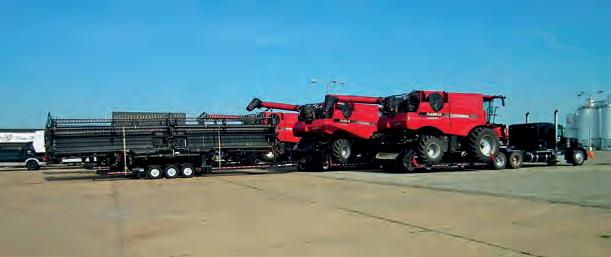
harvesting you will be going back and forth to town or the bin site on a farm, so you will need a good sense of direction. If the combines move you will need to find your way back to them but lots of harvesters now have a system in each piece of equipment so they can see were everyone is, which can be a help.
As a truck driver you could be asked to jump on a grain cart or combine during mealtimes so the operator can get off and stretch their legs and eat.
Fuelling machines up is often done at the end of the day while equipment is running down.

Servicing of machines usually happens in the morning when you first arrive at the field. Everybody on the crew is expected to help with this working as a team. You have to be very mindful of poisonous snakes and spiders that may have got into the engine area or the top of tyres when they were hot, so its always advised to check oil carefully, then start your machine and move it forward and kick it into gear to hopefully remove any possible danger before greasing and adjustments are made.
FMJ: Can you sum up your experiences over the years?
Paul: The one thing being on a US Harvesting crew will bring you is memory of a lifetime, traveling from Texas up through the Midwest into Montana and the Dakota’s you will make lots of friends, meet amazing local people, eat some great and interesting food, get to see fantastic scenery, and every chance you get to explore take it, make sure you take lots of picture of harvest and especially the people you work with, and if you have a drone, be sure to get lots of footage.
“Being on a US harvest crew will bring you memories for a lifetime”Right: Combine servicing under way on a cold autumn morning Below: The grain cart operator’s job is considered the busiest and most stressful in the harvesting team
FMJ also caught up with North Lincolnshire-based farmer Alex Coggon, who spent 2022 working across the US through the Ohio State University Programme. He tells us about his life-changing experiences driving combines, sheltering from tornadoes and a trip to Las Vegas
FMJ: Can you tell us about your background?
Alex: I’m a sixth-generation family farmer at Coggon Brothers in North Lincolnshire, near Scunthorpe.
FMJ: When and where did you travel?
Alex: It was the 2022 season. I flew out to the US on 25 March, started working for Jim at JKD Harvesting on 31 March and finished at the start of December. I flew home on 11 December.
FMJ: What did you learn from the experience that you brought back to the UK?
Alex: A lot of it is learning the value of teamwork. The other aspect is engineering skills. I learned so much out there. We did our own mechanics, we’d PDI the combines and we built up our own headers. You are learning something different. You get to understand a different way of farming.
FMJ: What sort of machines did you get your hands on?
Alex: We were running six John Deere SM70 combines. We had five John Deere 8R340s, four grain carts and we used Peterbilt trucks. We were all CDL-trained. Unfortunately, that doesn’t transfer back to the UK, which is a shame. Coming from a country where you are legal to tow doubles and triple-loads and come back here and you can’t tow anything, I found it frustrating.


FMJ: How else did it differ from your experience working at home?
Alex: Mainly it was the excitement of using larger equipment. I previously worked on a big farm out near Lincoln and we were using a 40ft combine and we did six of those out in the US. It is the same equipment just on a massive scale, with more of it running.

FMJ: What size teams were you working in?
Alex: It was 15 people. Six of us on the Ohio programme, including five from various parts of the UK. We also had a woman from Australia. It was a nice mix of people. The youngest member was 18 and I was the oldest at 24.
FMJ: How did you cope with the weather?
Alex: It was different! We had 40-degree heat every day and that carried on all the way up to South Dakota in mid-July. Then it began to cool off and stayed around late-20s/early 30s.
In Oklahoma at the back end of June we had a tornado pass through, which was pretty interesting. We were 30 miles from the nearest town, so we just sat in the campers. But there is a national alert that comes up on your phone. I wanted to take some pictures. But, thankfully, I had second thoughts and if I had gone out 10 minutes later I’d have been hammered by baseballsized hail stones. It was absolutely incredible. Very scary, but looking back it was once again a fascinating experience.
FMJ: That is certainly not something you are likely to have experienced in the UK is it?
Alex: Once the rain had stopped we moved everything into the sheds so if it happened again there would be no damage. I had to
sleep in a truck overnight as my bed had become so wet. I woke up about 4am and another lad woke up in another truck. The wind was shaking the truck all over the place. Totally incredible. I have never experienced anything like it.
FMJ: What were the highlights of your time?
Alex: Meeting new people and learning new skills. My boss, Jim, who owns JKD Harvesting, was very supportive about exploring the local areas and enjoying your downtime. We were advised to go and see the US in all its glory. When I was in Texas I went to Fort Worth and the Dallas Cowboys stadium.
We also went to the John Deere factories. I went to Las Vegas, went skiing and to the Grand Canyon. I have seen so much of the US and was supported the whole way. We also had a chance to sample plenty of the locals beers on more than one occasion,
FMJ: How did you manage the schedule?
Alex: You’d start at 8am until – usually –10pm but I don’t recall working longer than a week before you had a day off so it was very rewarding. We had meals made for us and never wanted for anything, meaning we could get on with working and enjoying the unbelievable experience. I would recommend this experience to any young farmer, whatever your background.
All of the combines being prepared for work on the flat plains on the Texas/Oklahoma State line Above: The JSD Farming custom harvesting team on the move from Kansas to Texas in the summer of 2022 Half of the team working with 3 combines for a customer in some wheat in North Dakota.



















A precision approach,targeting only the specific effected areas makes more sense environmentally and economically
Sprayer manufacturers are ghting to comply with the rules on crop protection products. FMJ looks at how new technology is spearheading the changes
 WORDS MICK ROBERTS IMAGES AERO21/AGRIFAC /AMAZONE/ MICRON SPRAYERS/ MICK ROBERTS/SYNGENTA/VALTRA
WORDS MICK ROBERTS IMAGES AERO21/AGRIFAC /AMAZONE/ MICRON SPRAYERS/ MICK ROBERTS/SYNGENTA/VALTRA
Crop protection products are under intense scrutiny and pressure. Many important active ingredients have been banned or withdrawn and many others are facing the same fate. In the EU the plan is to reduce the use of pesticides by 50 per cent by 2030.
To meet these considerable challenges sprayer manufacturers are responding by developing technology to increase precision. These developments improve accuracy by cutting drift, targeting products more precisely or cutting overlaps to ensure every drop counts.

At the same time the latest technology helps reduce environmental and operator exposure, which may also persuade regulators products are safe. For farmers,
higher accuracy should result in better crop protection leading to providing higher levels of control, reduced resistance risks, active ingredient savings and, ultimately, more profit.



All farmers know there are huge variations in the levels of infestation by weeds, pests and diseases in their fields. Currently, in almost all cases however, whole fields are sprayed with plant-protection products to treat what are often isolated patches of the
Right: There are often huge variations in crops.
Targeted treatments can significantly reduce the use of chemicals compared with overall ‘blanket’ applications
actual problem. A precision approach, targeting only the specifically affected areas makes more sense environmentally and economically.
There is now a range of technology that delivers applications far more precisely than the current, widely used ‘blanket’ treatments to whole fields.
Band spraying This is not new and already in use, particularly by vegetable growers
Prescription Now common for variable-rate fertilisers and seeds, it is now being adopted for use with crop protection products
Prescription banded A combination of variable rates and precise placement of product inbetween or over the rows
Optical spot spraying Cameras and sensors targeting applications in real time to vary applications.
Under the EU’s Sustainable Use Directive (which also still applies in the UK), aerial applications – which include drones – are not permitted unless for operations with special derogations. Their use is banned because of the high risk of non-target exposure – to the operator and bystanders.
There are, however, huge drone fleets in Asia, particularly China, Vietnam and
Indonesia. In these countries drones are replacing workers with hand-held sprayers, essentially removing operators from a dangerous environment – resulting in massive safety improvements.
Drones are also useful for use in vineyards and other crops grown on steep hillsides. They not only provide better access, they also reduce the dangers that come from operating machinery on steep slopes. Drones are permitted for this use in Switzerland.

Although drones hold potential to accurately target problem areas, they do not deliver precise applications. Trials by Syngenta show the spray distribution is erratic – producing a coefficient of variation (C0V) of 64% to 109%, which compares to a CoV of just 7% for a ground-based sprayer or 30% from a standard aerial application.
Precision rating: Drones
+ Low cost
+ Safer than hand-held
+ Ability to target problem areas
– Use not permitted in EU and many other countries
– Erratic spray distribution
– Currently unsuitable for large areas
Band Application
While not new, band application is a precise technique that can cut chemical use by 40 to 60 per cent – depending on band width. It’s use is now widely adopted by vegetable growers, mainly because of the chemical savings and its ability to precisely target sprays both on or off the row.
There is a good choice of equipment available, with twin-tank machines that can apply, for example, an insecticide or fungicide on the row, as well as a herbicide inter-row. On-board camera guidance offers increased accuracy and ease of use that, in combination with a side-shift system, enables the sprayer to automatically follow the row.
Auto-steering also enables mechanical weeding to replace herbicides, as well as working in tandem with an over-the-row spray application.
The challenge facing those looking to use bandspraying is its relatively slow workrate of about 4kph to 8kph. While it could be suitable for other, not so specialist uses, such as weed control in oilseed rape, maize or other broad acre crops current workrates limits its wider adoption.
Syngenta has also carried out band spraying trials in a crop of winter barley, drilled with a wider coulter spacing to enable the sprayer to work up the rows. The trial tested the


While not new, band application is a precise technique that can cut chemical use by 40 per cent to 60 per centThis picture: Band spraying reduces chemical use by between 40% to 60% and is already widely used by vegetable growers in precise row crops Right inset: Trials by Syngenta shows band spraying is effective in cereals grown in wider rows. But its width and workrate (6-8kph) restricts wider uptake in broad acre crops
technique with herbicides applied between the rows.
This approach worked well in the trial, which was illustrated by a blocked nozzle that shows untreated blackgrass in the row. This proves, with some minor changes to equipment and refinement, band spraying does offer potential for large reductions in product use in broad acre crops.
Precision rating: Band sprayers
+ Between 40 per cent to 60 per cent
chemical savings
+ Mechanical weeding can replace herbicides
+ Enables use of selective and non-selective applications at the same time
– Slow working speed – 4kph to 8kph
– Works best in row crops
– Wider rows required for use in cereals

Many farmers, contractors and operators are now familiar with prescription maps and variable rates for drilling as well as liquid and solid fertiliser applications. Variable-rate spraying is most likely to start with fungicide and plant growth regulator (PGR) applications in oilseed rape.
Creating a prescription map is a relatively simple process. The first step is to identify the agronomic challenge – such as poor establishment, patches of weeds or disease infestations.
These can be detected and mapped with normal field walking as well as by satellite or drone scans, which are used to make a digital image. This information and position data is then used to create a prescription map, which is transferred to the sprayer.
In theory the machine will automatically vary the rate according to the map. In reality users may encounter some real equipment and software compatibility issues.
Trials in the UK by Syngenta show variable-rate PGR and fungicide applications to a patchy field of oilseed rape produced significant chemical use reductions.
The ‘as applied’ maps, created after the application, reveal PGR was applied to just 15 per cent of the field and fungicide to 68 per cent (twice), using the system.
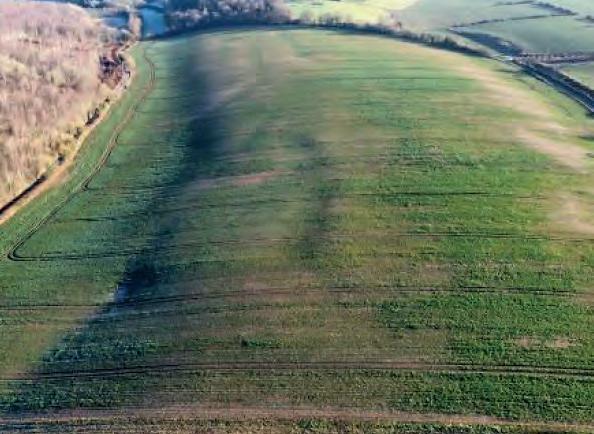
Current sprayer technology does, however, restrict the ability to vary and target application rates to specific areas. But these are not unsurmountable.
Boom size/resolution The resolution of the application is determined by the section width. Individual nozzle control does, in theory, enable applications to be targeted to 50cm. But some systems will only apply variable rates with nozzles grouped in sections
Spray quality Normally the only way to change the flowrate on a sprayer is for the rate controller to adjust the pressure. To double the flowrate the pressure has to increase by four times. This will create smaller droplets as the speed increases and larger ones if the machine slows down Turn-down ratio Essentially this determines the window of tolerance in which a conventional hydraulic nozzle is able to vary the output using pressure. In most cases this will be limited to a rate variance of no more than 30 per cent.
Water volume Changing the pressure will also alter the volume applied and this could result in inconsistent coverage, reduced efficacy and affect control
Tank mixes Many treatments will be applying a tank mix of more than one product – such as a herbicide, fungicide and PGR – at the same time. The difficulty is you may not want to vary the fungicide, but apply herbicide and PGR only to certain areas.
Precision rating: Variable rate spraying
+ Significant chemical savings
+ Targeted applications replace blanket coverage
+ Technology is progressing quickly
– Scanning and creating maps is not always easy

– Conventional sprayers restrict potential
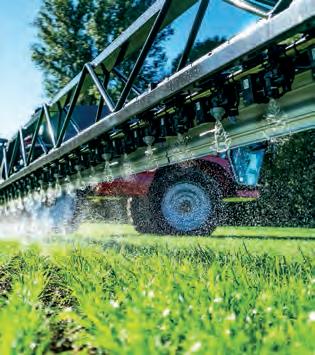
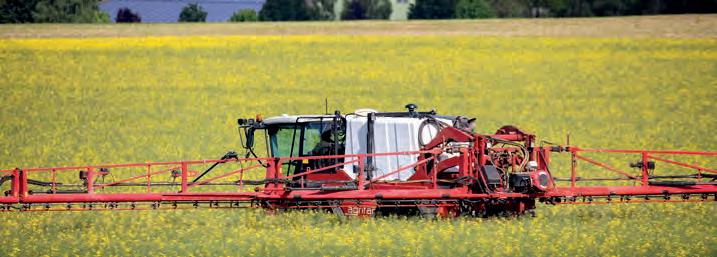
– Requires direct injection to apply more than one product
Pulse width modulation (PWM) is an electronic system that uses solenoids to turn (usually) individual nozzles on or off at rates up to 100 times a second.
This alters the rate without changing the pressure and means the droplet size is unaffected by forward speed differences or other changes. This also enables operators to vary the application rate while maintaining the correct droplet size.
Many of the PWM systems currently on sale already provide a facility to apply variable rates – but it is unlikely to do this to a resolution of a single nozzle – at 50cm or 25cm spacings. Check the specification because many limit the function to a number of nozzles clustered into ‘sections’.
Another benefit of PWM is it can alter the individual flow rate of different nozzles along the boom. This prevents over- and underapplication when turning, improving accuracy
as well as helping to combat the risk of resistance building up due to regular under-dosing.
It’s important to note that PWM is not compatible with many air induction nozzles used to reduce drift.
Precision rating: PWM spraying
+ Significant chemical savings
+ Able to apply accurate variable rates
+ Turn compensation cuts risk of resistance
– High capital cost investment
– Does not work with air induction nozzles
One way to overcome the difficulties of varying spray applications, without having to use separate passes for different products, is to directly inject undiluted products into clean water in a separate sprayline.
While direct injection has been around since the 1980s, it is one of the keys to improving precision by targeting products to specific areas, as well as varying rates of different products. Another benefit is it maintains the water volume.
Undiluted product, held in a tank, is pumped directly into several injection points spaced evenly on a separate sprayline on the boom, with the mixed spray continually recirculated at a pre-set pressure. There is no further need for mixing, enabling an instant start as soon as the nozzles are switched on.
Precision rating: Direct injection
+ Significant chemical savings
+ Enables different products to be applied at the same time
+ Precisely targets problem areas
– Undiluted chemical carried on sprayer
– Requires second spray line
– Chemical must be injected close to nozzles
Optical spot spraying delivers on-demand spray treatments that are detected and applied in real time.
Sensors or cameras on the boom scan the crop or ground and send this data to the terminal, where it is analysed by an algorithm to detect the presence of weeds, pests or diseases. It then turns on the appropriate nozzles to apply to the target or area.
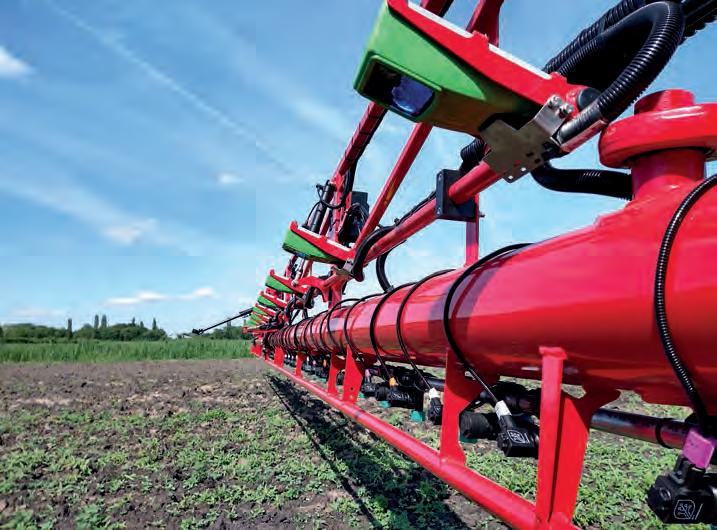

Currently this is largely confined to ‘green on brown’ spot spraying. Essentially these systems use cameras to identify ‘green’
weeds on bare soils and turn on the appropriate nozzles to spray them. Users in Australia and USA report chemical savings of up to 80 per cent or more.
Weed identification in growing crops (green on green) is considerably more difficult to achieve – particularly in cereals in typical Northern European situations. While algorithms to do to this are currently being developed by many of the larger manufacturers and numerous start-ups, proven systems are still not yet at a fully commercial stage.
Precision rating: Optical spot spraying
+ Significant chemical savings
+ Fully automatic operation
+ Precisely targets and treats problems
– High initial capital investment
– Green on Green algorithms still being developed
– Direct injection required for more than one chemical
Optical spot spraying delivers ondemand spray treatments that are detected and applied in real time








Kramer‘s telehandler series from 3.0 - 5.5 tonnes payload has been given a facelift. Visibility of the working area is a crucial element for telehandlers. Combined with a focus on safety, Kramer can score with a new engine bonnet design and other upgrades. Convince yourself!


NEW!

Contact your local dealer: www.kramer.de/dealerlocator






Once confined to contractors, front-mounted mowers are now used by smaller operators and farmers looking to improve their mowing efficiency. Working at slower speeds using two or three mowers, yet maintaining output, can only be a good thing for both operator and machine.



A front mower is very versatile in how it can be operated –much more so than rear models. It can be used with a rearmounted or trailed mower or as part of a butterfly set of mowers. They can also be used in combination with a forage wagon for zero grazing or even a round baler for clearing grass on construction projects.
Clever suspension systems are now incorporated into many new machines, and some manufacturers offer models that are effectively ‘trailed’, as opposed to ‘pushed’, and can oscillate to either side. Using these systems, the mower bed can now effectively ride over an obstacle (within reason) rather than just ploughing into it. Used in combination with other cutter-bar protections can greatly reduce damage caused by collisions.
Here we take a look at some of the various systems on the market and some of their interesting features.
With a completely new headstock design, the 3m Disco 3200 FC Move can be hitched directly to the tractor or via a traditional A-frame. The headstock
remains at a fixed height, while the linkage geometry allows the mower bed to move independently. A combined vertical movement range of 1000mm is achievable due to the mower being able to move 600mm upwards and 400mm down.
Mounting the pivot point low down enables the mower bed to react quickly to changes in terrain.
The active float hydro-pneumatic suspension can be adjusted on the move as two separate circuits take care of lift and suspension. The pressed steel Max Cut mower bed places the cutting disc further forward providing better overlap and, combined with Hardox inserts between the discs, is said to achieve a cleaner cut. The 3200 is fitted with seven discs with quick-change knives.

A front-mounted mower is in the front line of any outfit. It works into the unknown, often coming to grief more than any rear mower due to its position on the tractor hiding obstacles that are invisible to the operator
Suspension systems are incorporated into many machinesClaas Dissco 3200 FC Move
A novel feature is the anti-clockwise discs are painted red along with the knives to make identification easier. The mower is available with a V-tine conditioner or straight disc. All Claas mowers can run at 850rpm to save fuel. A double mirror option aids the operator in negotiating difficult junctions.
Relatively unknown here in the UK, Finnish manufacturer Elho offers a range of front mowers, represented here by the popular 3.2m working width NM3200F.
Like others in its range, this model features the pendulum centre system (PCS), that connects the cutter-bar to the upper body, allowing it to move backwards, swing and rotate to help reduce the force of impacts by up to 50%.
This works in combination with the HydroBalance suspension that uses an accumulator to allow the cutterbar to float over the field surface to reduce the risk of contamination, as well as cutting friction to help save fuel.


A novel HydroBalance top link option replaces the traditional top link and further aids suspension by allowing the mower to lift higher on headland turns.
Fitted with eight discs, the 3200F has a 2500mm-wide conditioner that works at 920rpm. It is fitted with round forged steel fingers and an adjustable spring-loaded counter bar that Elho says rubs off the surface wax as opposed to cutting it. The mower can also be set to work in
combination with the rear, as well as being set up to work in reverse drive format.
Fendt
For up-front work Fendt offers the 3.10m Slicer 310F or the 3.60m Slicer 360, available without a conditioner or with a tine or roller conditioner and suspension systems.


In ‘F’ format, they are available with a standard pendulum-type support, while ‘FQ’ versions employ threedimensional contour following. This provides 650mm of vertical travel as well allowing the cutter-bar to tilt from minus 6deg to plus 15deg, depending on whether the mower is heading up or down a slope. This movement is further enhanced by a cross swing of +/- 13deg. Even cutter-bar pressure is maintained by the TurboLift hydropneumatic system.
Access for maintenance is easy due to tool-less opening of the front guards. The blades are simply changed using the quick-change
spanners stored on the left side of the machine.
A handy feature of the FQ is its ability to be moved hydraulically left and right by 20cm to prevent misses working round curves when used in conjunction with a rear mower.
The F310R and the F350R offer working widths of 3.10m and 3.50m, respectively, and a streamlined design aids operator visibility.
Seven discs are fitted to the F310R, the F350R having eight, and both are fitted with quick-change, retractable blades as standard. The mowers can run using either clockwise or anti-clockwise PTO direction.
A premium hydro-pneumatic suspension system is designed to reduce drag resistance and allows the bed to follow the contours of the ground. A trapezium-based breakaway system takes care of any obstacles encountered in the field by automatically pivoting and actively lifting over the obstruction. Once the object is cleared the system then returns it to work.
A steel tine conditioner runs at a choice of two speeds – 755rpm and
A good feature is its ability to moved hydraulically left and right to prevent missesJohn Deere F310R and F350R Elho NM series Fendt Slicer Krone EasyCut F
1000rpm – and conditioning flaps have an opening range of 10mm to 50mm.
There are ten models in the Krone EasyCut F front mower range, offering working widths ranging from 2.71m-3.60m. All are fitted with the fully welded and permanently lubricated EasyCut cutter-bar.
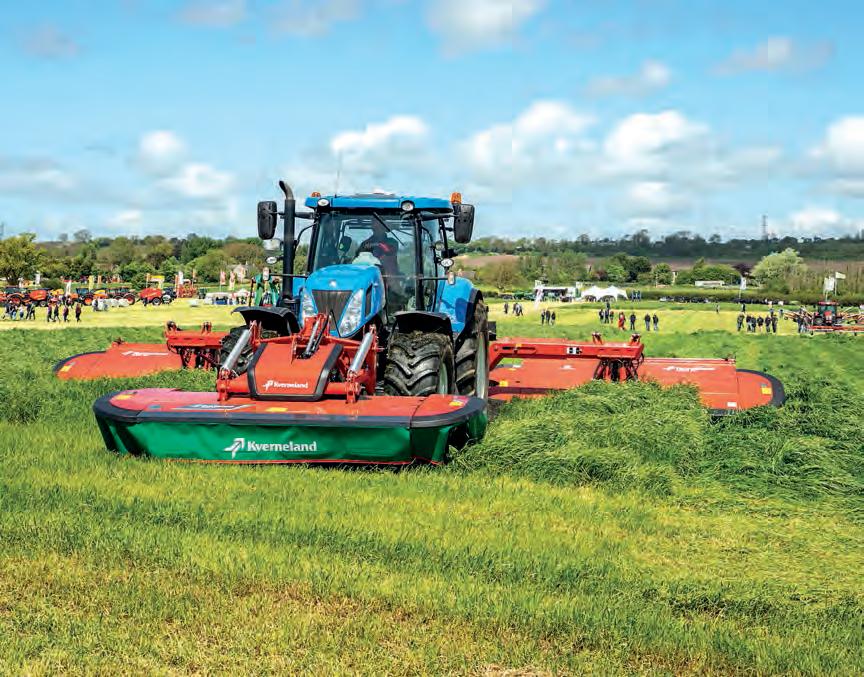
Large spur gears, with up to 66 teeth, are designed to rotate at slower speeds to help quiet running and increase longevity. Individual disc protection comes in the form of SafeCut. If an obstacle is encountered a quick-change roll pin shears allowing the disc to thread up 15mm to ensure it does not collide with neighbouring discs.
CV models are fitted with a steel V-tine conditioner, while CR models come equipped with rubber or steel crimping rollers.
Mowers can be specified with the optional pull-type suspension system that allows the mower to travel up/ down by 18deg. The mower deck is raised using a single-acting ram with a pressure gauge displaying the current ground pressure. This can be adjusted from the cab and locked off by a tap when required.
An additional lift cylinder can also be fitted to provide extra ground clearance during headland turns. Two cameras can be fitted to the nosecone to increase visibility when exiting awkward gateways and junctions.
Kuhn’s front mower conditioner offering comprises the FC 3125 DF-FF and FC 3525 DF-FF. With working widths of 3.10m and 3.50m, they are equipped with the Opti-Disc Elite cutter-bar, which is fitted with seven or eight discs with fast-fit quickchange blades.


Standard fitment is the DigiDrive conditioner with pivoting steel fingers. It uses a simple gear lever to select speeds of either 755rpm or 1000rpm, along with a five-position lever to alter conditioning intensity.
For those cutting more delicate crops, the optional Squareflex roller conditioner can exert a pressure of 500kg/m across the rollers.
Vertical movement of nearly 700mm is provided by the ‘dynamic support arms’. Due to their lower mounting on the tractor side, a
dynamic lift effect is created, which aids ground contour following in hilly conditions. Ground hugging is further improved by 30deg left and right oscillation.
The ‘lift-control’ hydro-pneumatic suspension is easily adjusted to prevent strain on the tractor’s front linkage.
Kubota
Branded in Kubota’s distinctive orange livery, its range of mowers share many features with its Vicon cousin, including the three-blade disc design. Fitted with eight discs, it can also be specified with the Express quickchange blade kit.
The 2.8m working width DMC7028FN
mower conditioner uses
the unique ‘free float’ pulled suspension system (FFS). Employing two compensation springs, this three-dimensional system instantly adapts to the ground contours with a vertical movement range of 450mm, along with 24deg of transverse adaptation.
The conditioner is equipped with nylon conditioner tines and has an adjustable conditioning plate. It can be set to run at either 600rpm or 900rpm by simply adjusting pulleys.
The 3300 FT series is the latest in the line-up of front mowers from Kverneland. The new-look range comprises the 3332FT and 3336FT, offering working widths of 3.2m and 3.6m, respectively.
They are equipped with either eight or nine oval discs with twin ProFit quick-change blades and employ the ProLink suspension, which provides three-dimensional tracking of ground contours. This provides 250mm of down movement and 420mm up movement with a tilting range of 24deg. Pressure and stability are maintained by two large widely spaced springs.
The ProLink
Kverneland 3300 FT series





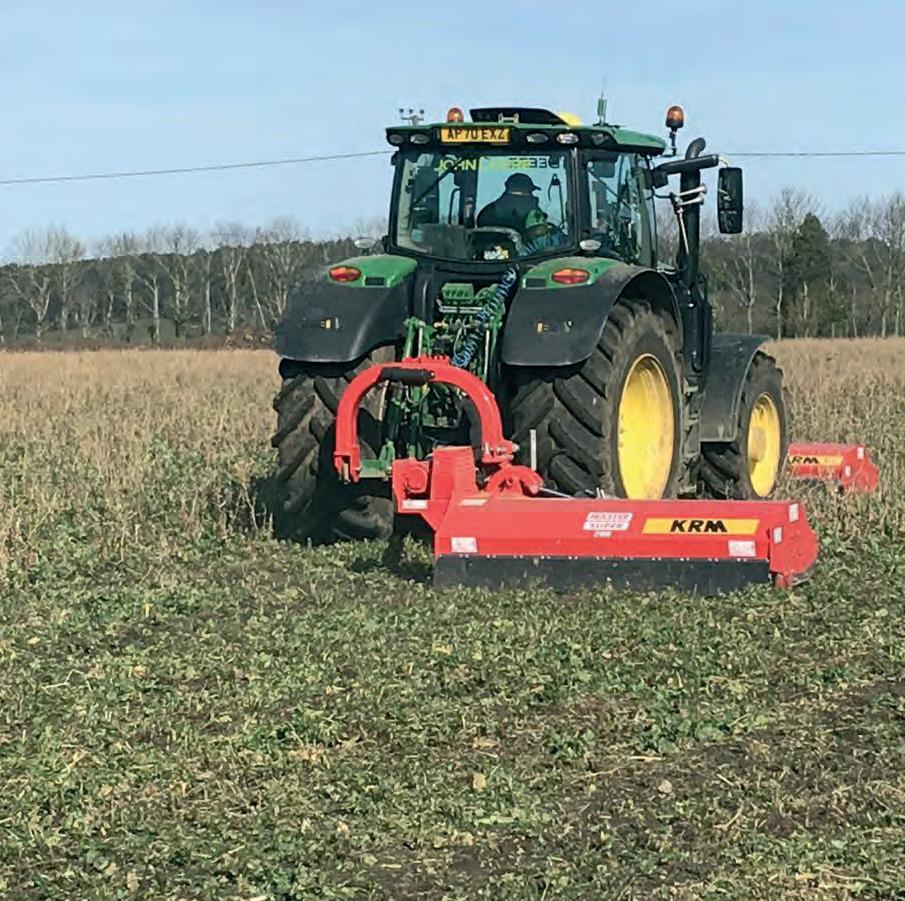

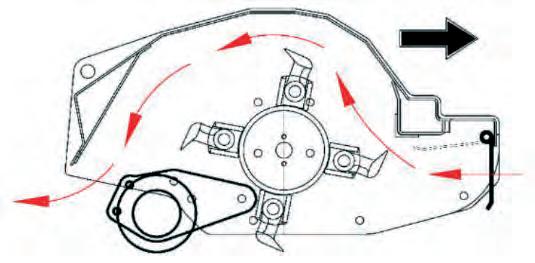
system also protects the cutter-bar. If a foreign object is encountered, triple-fold action takes place – the bed moves back and up, the springs aid lifting and the bed angles from 4deg to horizontal to clear it.
The mowers are claimed to feature the widest conditioner on the market with semi-swinging steel tines. Stubble height can be altered simply, without the need to adjust the top link on the tractor.

Massey Ferguson’s wide range of front mowers includes models from the 2m-wide, four-disc MF DM204FK-S Alpine right through to the 3.62m, seven-disc MF DM367 FQ mower conditioner with three-dimensional ground adaptation.

The 3.12m, DM316 comes as either the FP, with pivoting headstock and compact angle drive, or the FQ variant, which is equipped with the same TurboLift threedimensional suspension as the wider MF DM 367FQ.
This pendulum mounting system effectively pulls the mower through the crop and the TurboLift system provides infinitely variable ground pressure control. The two FQ models are mounted directly to the tractor without the use of an A-frame, which aids stability and reduces overhang.
Both the MF DM316 and MF DM367 models can be supplied as a straight mower, or with a choice of a tine (FC) or roller (RC) conditioners.
A tubular frame design for the Proglide F3100 includes an integrated suspension system, which places the centre of gravity as close as possible to the tractor.
It uses an active spring compensator to maintain an even cutter-bar ground pressure throughout the 500mm vertical travel range, as well as an oscillation of 17deg. This system also allows the cutter-bar to change angle when
mowing into a dip or up a bank.
Seven discs, fitted with quickchange blades, provide the mower with a 3.05m cutting width. It weighs 1250kg and can be fitted with a steel tine conditioner, which can run at speeds of 700rpm or 1000rpm.
To set the correct working height the operator can simply line up a pair of yellow arrows that are easily visible from the cab. An inclinometer, fitted to the headstock also aids correct top link setting for adjustment of cutting height.
A mirror option aids the operator in blind spots and there is even the option to fit a camera to further improve visibility.
The two models in New Holland’s DiscCutter F mower conditioner range offer working widths of 3.11m and 3.52m.

The DiscCutter F 320P and 360P are equipped with eight and nine discs, respectively and each disc is
fitted with two twisted blades, which are changed using a special tool. The cutting unit is suspended in a trapeze system and allows vertical movement of 550mm with a side inclination of 12deg. Both conditioners are fitted with polyethylene conditioner tines and DiscCutter models weigh between 1180kg and 1260kg.
For those not requiring conditioning, the 2.96m DuraDisc F 300 has a pendulum flotation system.
Pöttinger’s Alpha Motion suspension system is available on both the Novacat disc and Eurocat drum mowers.
There are two versions on the Novacat: the Pro is available with the extra dry steel tine conditioner, rubber crimping roller or simply as a straight disc mower with swath deflectors. An optional quick-change kit is available to swap the conditioner or to remove it altogether. Master models are mounted closer to the tractor but cannot be fitted with a conditioner. They
New Holland DiscCutter F Massey FergusonThe mowers are claimed to feature the widest conditioner on the marketMcHale Proglide F3100
Pöttinger Novacat and Eurocat
are available in working widths of 2.62m, 3.04m and 3.46m and quick-change blades are fitted as standard.
The Alpha Motion system uses an active support frame and link rods to allow the mower to react to undulating terrain. It provides the Pro model with a movement of minus 9deg and plus 12deg and a transverse movement of +/-16deg. Two large springs ensure a uniform bed pressure of 150kg.
A unique option for the Novacat Alpha Motion is the Sensosafe system, which detects wildlife in the path of the mower. If an animal is detected, the mower is automatically raised to avoid it and an alarm is raised in the cab warning the operator to stop.
Silvercut Disc F mowers from SIP are available in working widths of 2.97m to 3.32m. They come with several options: non-conditioner, steel or plastic tine conditioner (FSC FPC) and rubber roller conditioner (RRC), and have either hydro-pneumatic or mechanical sprung suspension.

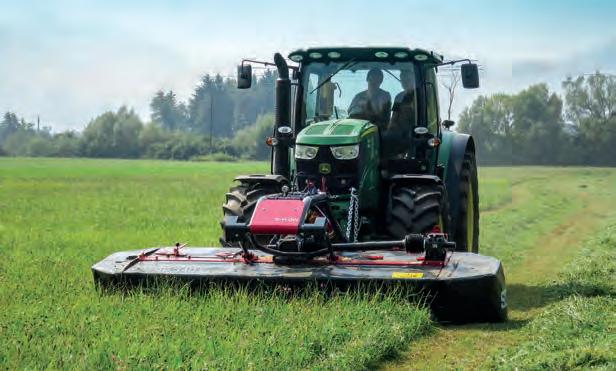

The S-Flow hitch allows the mower to follow the ground contours by providing +/-28deg lateral movement, with 6deg/200mm downwards and 140deg/300mm vertically upwards.
The discs are made from 4mm Hardox and feature a ‘disc drive safety system’ (DDSS) – a series of brass pins within the disc shear
should an obstacle be encountered.
The 2.97m-wide Silvercut 300 F comes with seven discs. There is also the option of three different disc rotation configurations to suit the application. The discs are fitted with quick-change system (QCS) spring blade holders for quick changes and allowing the blade to retract if an obstacle is encountered. Further protection comes in the form of the collision safety system (CSS).
Vicon has recently introduced a host of new features for its Extra732FT. With a 3.18m cutting width, it employ’s Vicon’s unique three-bladed discs, which provide a 50% higher cutting frequency and result in a cleaner cut stubble. The eight triangular discs can be specified with the express quick-change blade kit.
ProLink three-dimensional suspension is designed to enhance the cutterbar’s ground following and also helps protect it from damage. Should an obstacle be encountered, the NonStop BreakAway system allows the deck to move backwards and upwards to reduce the impact. A stubble height adjuster is integrated into the suspension system also for easy adjustment.
The Extra 732FT can be fitted with the SemiSwing steel tine conditioner. It offers two working speeds and dual adjustment of the conditioner plate.
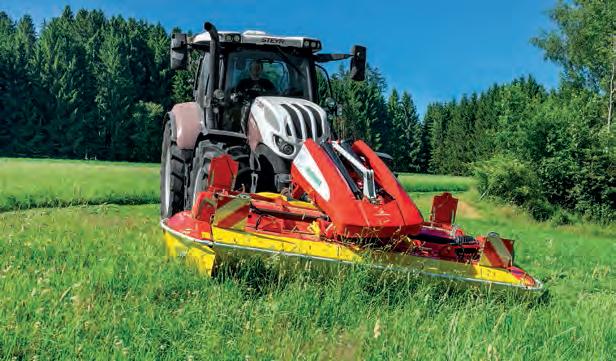
A unique option for the Novacat Alpha Motion is the Sensosafe systemAbove inset: This novel Sensosafe system from Pöttinger automatically lifts the mower if it detects wildlife in its path Vicon Extra732FT SIP Silvercut














KRONE EASYCUT MOWERS – BECAUSE NOTHING CUTS LIKE A KRONE Built with tried and tested KRONE innovations such as the SmartCut mowerbed which gives maximum disc overlap for the cleanest of cuts, and SafeCut protection which keeps impact damage and repairs to the mowerbed to a minimum. KRONE DuoGrip gives EasyCut mowers a unique centre of gravity mounting allowing for the best ground contouring and minimal soil contamination.

VEHICLE NEW HOLLAND CX8.70



WORDS AND IMAGES DAVID LALEY
Throughout the 1990s New Holland’s mid-range TX30 series were the combine harvester of choice on Will Smith’s mixed farm. Prior to 1997 Will favoured New Holland’s five straw walker TX32 to gather in his harvest. However, for the next eight seasons up until 2005 he switched his allegiance to Claas and its more powerful 190hp five straw walker Lexion 410.
“The New Holland TX32s I ran were excellent combines, but were becoming outdated. By the time I was ready to replace the last one Claas had introduced its Lexion range of combines equipped with the luxurious Vista cab,” says Will. “In 1997 this tempted me to make the switch to a brand-new Lexion 410, which at the time offered greater levels of comfort compared to New Holland’s equivalent TX62.
“While the Lexion 410 proved to be a decent combine, I actually preferred the separation system New Holland used. When my first Lexion 410 was due for replacement I very nearly returned to a Belgian-built combine. In 2002 New Holland introduced its all-new CX700 and CX800 range of five and six straw walker combines equipped with the space-age Harvest Suite cab. I came very close to purchasing a five straw walker model from the lower end of the new range. However, I got an excellent deal on another Claas Lexion 410 so I ran that up until 2005.”
By then New Holland’s TX replacement CX range was threeyears old and had been refined and improved significantly, so much so, that Will swapped his last Claas

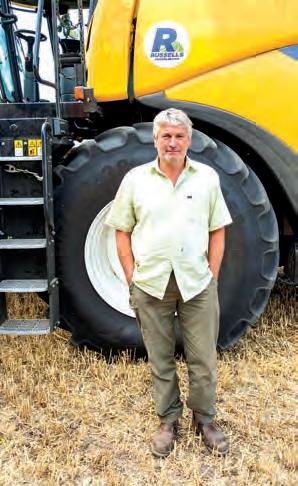
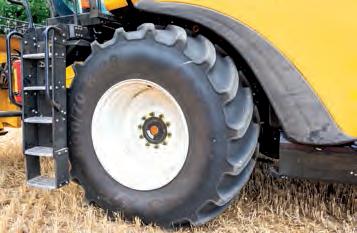
Above: Will says the CX8.70’s threshing system that comprises four drums and six straw walkers produces an excellent straw swath in all of the cereal crops he grows
Lexion 410 for a 218hp New Holland CX720. This was replaced by a more powerful 272hp Iveco-powered CX8030 before the first of two 318hp CX8040s arrived on Will’s farm. The last of these was swapped for a higher -capacity six straw walker CX8070 powered by a 364hp 8.7-litre sixcylinder turbocharged Iveco Cursor 9 engine.
Will was so impressed with the
SN & WR Smith
Location Church Broughton, Derbyshire
Farm 750 acres wheat, barley, oats, oilseed rape and beans; small herd of beef cattle
Right: Will Smith says the simplicity and specification of the CX range of combine harvesters is the reason why he’s run seven examples since 2005
Far right & above far right: The CX8.70 rides on Mitas 800/70 R38 tyres up front and Michelin 520/80 R26 tyres on the rear steering axle
CX8070’s performance he replaced it with another CX8070 before this combine was changed for the latest generation CX8.70 he currently runs in readiness for 2021. “The CX8070s were brilliant combines and we received excellent back-up from Hallmark Tractors Ltd that supplied all of the CX combines we’ve run out of its Cubley and Ashby depots,” he says.
“Our latest CX8.70 was supplied by Russells, that took over Hallmark Tractors Ltd in 2018 and we’ve continued to receive fantastic service. Since purchasing the CX720 back in
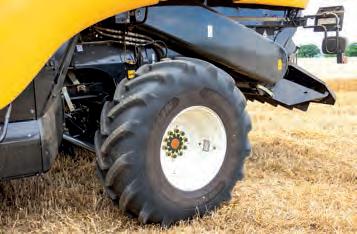
mixed farmer Will Smith has been running models from New Holland’s CX range since 2005. In 2020, he took delivery of a brand new 374hp CX8.70 and FMJ made the trip to find out the latest on this new machineAbove: The CX8.70’s 11500-litre grain tank is emptied into trailers waiting on the headland at a rate of 125 litres per second
2005 we’ve always run combines for one to four years and taken the opportunity to replace them sooner when we’ve been offered a decent trade-in deal.”
Last year New Holland’s CX range of high-capacity five and six straw walker combines celebrated their 20th anniversary. First unveiled in 2001 and then officially launched in 2002 with power outputs between 218hp and 374hp, the CX range has won no less than 33 prestigious awards during its long production run.
In 2007 the revamped CX8000 range was introduced and came equipped with New Holland’s latest-generation touch-screen IntelliView II performancemonitoring terminal, and Stafe IIIA-compliant engines. 2010 saw the introduction ECOBlue and selective catalytic reduction (SCR) technology to the CX8000 range, while from 2013 Opti-Speed auto-adaptive variablespeed straw walkers became available on both the CX7000 and CX8000 ranges.
In 2015 the CX7 and CX8 ranges replaced the CX7000 and CX8000
combines and were equipped with New Holland’s revamped Harvest Suite Ultra cab. 2020 saw the CX7 and CX8 ranges enhanced further with the introduction of the Ultra-Flow staggered threshing drum. Will Smith’s 374hp 8.7-litre six-cylinder turbo-charged FPT Cursor 9-powered CX8.70 slots in just behind New Holland’s current range-topping six straw walker combines, the 415hp CX8.80, and 460hp CX8.90.

Will uses the CX8.70 to harvest 750 acres of his own wheat, barley, oats, oil-seed rape and beans and 300 acres belonging to neighbouring


New Holland

CX8.70
Engine hours 400
Drum hours 340
Engine 8.7L, six-cylinder
turbo-charged FPT
Cursor 9
Max power 364hp
Transmission 4-speed
hydrostatic
Header 25ft wide
Varifeed
Knife speed 1300 cuts per minute
Reel diameter 1.07m
Elevator chains 4
Threshing drum
Width 1.56m
Diameter 0.75m
Rasp bars 10
Speed range
305-905rpm
Drum concave area
1.18sq.m
Bars 16
Wrap angle 111 degrees
Beater
Diameter 0.475m
Concave area
0.29sq.m
Rotary separator dia
0.72m
Speed 387-700rpm
Powered separation area 2.54sq.m
Straw walkers 6
Separation area
5.93sq.m
Total sieve area under wind control
6.5sq.m
Grain tank capacity 11,500 litres
Unloading speed 125L/ second
Tyres Front, Mitas 800/70R38; rear Michelin 520/80 R26
“The CX8070s were brilliant combines and we received excellent back-up”Will Smith’s CX8.70 comes equipped with a 25ft (7.6m) version of New Holland’s hydraulically adjustable VariFeed header that features a 1.07m-diameter reel and a 66cm-diameter auger with retractable fingers Following the completion of his 2022 harvest, Will Smith’s 2021 New Holland CX8.70 has now clocked 400 trouble-free engine hours and 340 threshing drum hours Left: Will’s CX8.70 comes equipped with a decent size 11,500-litre capacity grain tank. The tank extension lid folds away neatly and quickly for travelling on the road Above: The table of the VariFeed header can be extended forwards by up to 57.5cm to reduce losses in tinder-dry crops while New Holland’s automated header height control system enables it to follow ground contours accurately
farmers. “Following the completion of our 2022 harvest the CX8.70 has now completed 400 trouble-free engine hours and 340 drum hours,” he says. “It ran faultlessly and has been an excellent step up in performance from the last of the CX8070 combines.
“The CX8.70 is equipped with a lot more creature comforts and useful driver aids, including auto steer and the Ultra-Flow staggered drum, which I hope will help maintain its resale value when we trade it in.”
Up front, Will’s CX8.70 is equipped with a 25ft version of New Holland’s hydraulically adjustable VariFeed header that comes equipped with a 1.07m reel and a 66cm-diameter auger. “It’s a fantastic header to operate, while the hydraulically adjustable reel and table allow you to tailor the header for all types of crops.”
The VariFeed header also comes equipped with New Holland’s automated header height control system that can be used in three different operational modes. They include compensation mode that utilises a pre-established ground contact pressure to ensure laid or low growing crops such as peas or beans are gathered up and on to the VariFeed table efficiently. Automatic stubble height control uses a range of sensors situated on the underside of the header that work in conjunction with a set of automated hydraulic cylinders to maintain a pre-set stubble height.
Lastly, New Holland’s AutoFloat system uses sensors to ensure that the header automatically follows uneven terrain smoothly and accurately without penetrating the ground. From the header crops are transferred to the CX8.70’s threshing drum via a four-chain elevator equipped with a reinforced front cradle and drive system running at
575rpm, enabling it to cope with the densest crops. “It’s a brilliant system that enables you to push an impressive volume of crops through to the CX8.70’s threshing system efficiently without any loss of performance, increase in fuel use, or risk of blockages,” says Will.
If a blockage were to occur between the header and elevator, the New Holland’s hydraulic reversing system is capable of dealing with such issues by gently rocking the header and elevator drives backwards and forwards until they’re clear. The threshing system in Will’s CX8.70 comprises four drums and six straw walkers. Crops are initially separated by New Holland’s large 75cm-diameter Ultra-Flow staggered drum featuring offset rasp bars.
This optional drum has been designed to improve crop flow, reduce in-cab noise and fuel consumption, as well as lowering the risk of blockages while improving capacity by up to 10 per cent, claims New Holland. “The Ultra-Flow staggered drum runs noticeably smoother and quieter and has also



reduced split grains in the sample to an absolute minimum,” says Will.
The Ultra-Flow drum’s speed can be adjusted between 305rpm and 905rpm and it’s also matched to a 16-bar concave that provides 111
Above: Will has been very impressed with the CX8.70’s spacious 73dBA Harvest Suite Ultra cab that features 7% more glass area and many more additional creature comforts
Above right
multi-function handle is used to control the header and reel’s movement and speed, engage Intellisteer and operate the unloading auger
degrees of wrap angle. Crops then pass between a smaller diameter beater rotor and concave before New Holland’s 72cm-diameter rotary separator equipped with New Holland’s MultiThresh system takes over. It allows operators to adjust the distance between the rotary separator and concave. The smaller the gap, the more aggressive the threshing action. The system can be adjusted on the move from the comfort of the CX8.70’s cab.
The final part of forced separation is carried out by a smaller diameter straw flow beater before crops are distributed evenly across the straw walkers to complete the separation process.
Will’s CX8.70 comes equipped with six Opti-Speed adaptive variablespeed straw walkers. The system automatically regulates the speed of the straw walkers depending on the crop type. When travelling uphill straw walker speed is automatically reduced to ensure grain and material are kept within the threshing system. When working downhill straw walker speed is increased to prevent blockages.
“It’s a very clever system that allows you to push on without any
fear of losses, blockages or reduction in performance, even if conditions aren’t the best,” says Will.
“The CX8.70’s threshing system not only produces an excellent grain sample, but also a decent straw swath in all of our cereal crops, which we bale to support our small herd of beef cattle.”
Once grain has been separated the CX8.70’s self-levelling Opti-Fan
Left: The CX8.70’s climate control centre situated above and to the right of the operator also includes the combine’s lighting controls and a digital radio
Left: The Harvest Suite Ultra cab is equipped with the 26.4cm-wide Intelliview touch-screen terminal that’s capable of monitoring all major functions and is used to set up operating parameters



CX8.70’s cab includes 27 LED work lights, while inside there’s a lot more space and storage compartments.
“The Harvest Suite Ultra cab is an exceptionally comfortable and relaxing place in which to spend a long day and I really like the extra storage space, including the large portable cool box located below the CX8.70’s passenger seat,” says Will.
cleaning system compensates for the gravitational effects on crops in a similar way to the straw walkers. The cleaning process is enhanced further by New Holland’s Opti-Clean system that enables the grain pan, pre and top sieves to operate independently for greater capacity. Separated grain is then transferred to an 11,500-litre grain tank that can be unloaded at 125 lit/sec.
Will is also a huge fan of the CX8.70’s 73dBA Harvest Suite Ultra cab, which is equipped with 6.3sq.m of glass and a number of additional creature comforts compared to his previous CX8070. Externally the
At the heart of the CX8.70’s control console is the CommandGrip multi-function handle that’s used to control the header, engage Intellisteer, and operate the unloading auger. The console is also equipped with New Holland’s advanced 26.4cmwide Intelliview touch-screen terminal that’s capable of accurately monitoring all of the CX8.70’s major functions. It’s also used to set up the combine’s operating parameters such as drum speed and concave position.


Will has also been impressed with New Holland’s fully integrated auto-steering system, Intellisteer, that comes equipped with terrain compensation that uses sensors to calculate and correct the roll, pitch and yaw of the CX8.70 in work. “It’s a very straightforward system to engage and monitor through the Intelliview IV terminal and has definitely made harvest far less tiring as a result,” says Will. “The simplicity, performance and specification of New Holland’s CX range of straw walker combine harvesters are the main reasons I’ve been running them since 2005, and the CX8.70 has been the best of the lot so far.”
Thanks to Will Smith for his time and assistance with this feature.
“Sensors ensure the header automatically follows uneven terrain smoothly and accurately”inset: The CommandGrip











VEHICLE RENAULT ATLES 936RZ
In 2016 Sam Scrowston purchased a rare 260hp 2003 Renault Atles 936RZ with a 3m Sumo Trio and modernised its specification. FMJ travelled to Leven in East Yorkshire to find out his thoughts on the machine
WORDS AND IMAGES DAVID
Sam Scrowston first became fully aware of Renault’s short-lived Atles range of high-horsepower rigid tractors when he began working as an apprentice in the workshops of Claas Eastern’s Catfoss depot in 2007.


Renault first introduced the Atles in early 2000 to compete with the likes of John Deere’s 8010, New Holland’s 70A, and Case IH’s Magnum MX range of flagship rigid tractors. The Atles originally comprised three models, the 205hp 915RZ, 240hp 925RZ, and the 250hp 935RZ all powered by the same 7.2-lire six-cylinder turbocharged and intercooled Deutz BF6L1013EC engine matched to a Funk 18x8 powershift transmission.

In 2001 the Atles range was revamped resulting in the introduction of the 240hp 926RZ, and 260hp 936RZ that were equipped with the same engine and transmission configurations as the previous models. Just 86 of the flagship 936RZ were built at Renault’s Le Mans manufacturing facility between 2001 and early 2004.
By this time Renault had already a sold a 51 per cent majority stake in Renault Agriculture to Claas in 2003. This soon became an 80 per cent share before Claas completed the takeover in 2008. The Atles range lived on in Claas’s green, white and red livery until 2006 and a new
adjustable tilting and telescopic steering column
Glebe Farm Machine 2003
Renault Atles 936RZ
Purchased 2016
Used for Seven years
Owner/Operator Sam Scrowston Location Leven, East Yorkshire
“In 2001 the Atles range was revamped resulting in the introduction of the 240hp 926RZ, and 260hp 936RZ”Left: The Atles’ Integrale cab includes a fully Left: Sam Scrowston became fascinated with Renault’s Atles range of high-horse power tractors when he began working as apprentice service technician for Claas Eastern
LALEYAbove: Sam Scrowston bought this ultra rare tractor from a dealer in East Yorkshire back in 2016 to head up his father Derek’s fleet
2003 Renault Atles 936RZ
Engine 7.2-litre
6-cylinder
turbocharged and intercooled Deutz
HP 260hp
Torque back-up 40%
Fuel tank capacity
455-litre
Transmission Funk
18F/8R powershift
Linkage Category 3
Lift capacity 12 t
Turning circle
Sam is a huge fan of Renault’s roomy uncluttered Integrale cab that he says is loaded with creature comforts that wouldn’t look out of place on a more modern tractor
5.65m
Height 3.24m
Length 5.73m
Wheelbase 3.04m
Weight 10.3 tonnes
Tyres Front BKT
600/65R28 Rear
BKT 710/70R38
flagship model, the 282hp Atles 946RZ was also introduced during this time.
The Renault-derived Atles range was phased out following the introduction Claas’s own five model highhorsepower Axion range during 2006. When Sam began working as an apprentice service technician for Claas Eastern in 2007 he worked on a large variety of new Claas Axion and Arion models, as well as tractors from the Renault-based Ares and Atles ranges and ended up becoming a huge fan of the legacy models.
“The older Ares tractors were advanced for their time, and came equipped with the spacious Integrale cab, proven Deere power sytems and a whole host of electronic creature comforts including Tractocontrol, Renault’s active wheel-slip control system,” says Sam.
“They were easy to work on, and maintain, and after I’d returned from spending five months working for a Claas dealer in New Zealand I ended up helping my father Derek source a 114hp 2002 Ares 616RZ in 2008 to use on the 200-acre arable he runs with my mother Susan.”
In 2013 a second Renault Ares joined the Scrowston’s fleet in the shape of a turbocharged 130hp 2002 640RZ purchased through Claas Eastern specifically to handle a 4m wide Amazone drill and front press.
“They were both affordable tractors that provided my father with a lot
more comfort and horse power than he’d been previously used to,” says Sam.
“As a result we’ve been able to run a pair of high-specification modern classics economically ourselves which has allowed us to complete our land work more efficiently.
“We still run the 616RZ and earlier this year bought a more powerful 164hp 2003 Claas Ares 816RZ to use with a newer 4m Kuhn combination drill my father bought.”
After working as a Master Technician with Claas Eastern Sam currently holds the role of Service Foreman at its Catfoss depot, and also helps out on his parents’ farm in his spare time.
While he’s enjoyed maintaining and occasionally operating his father’s pair of Renault Ares 616RZ and 640RZ Sam still hankered after owning one of the much larger and rarer Atles tractors.
“I’d worked on several Claas liveried Atles tractors at work and really wanted to own one of the earlier Renault versions but I knew finding one wouldn’t be an easy task,” says Sam.
“In 2016 we decided to move away from a plough and power-harrow based cultivation system so we could establish our winter wheat, spring barley and spring oats more economically.


“This gave me even more of an incentive to track down my dream

tractor which I eventually found for sale online with a second-hand machinery dealer in East Yorkshire.”
“It had clocked just 3800 hours with one previous owner near Goole, and appeared to have been very well looked after. The cab steps had even been fitted with non-slip plastic

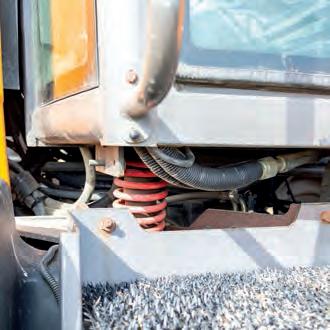

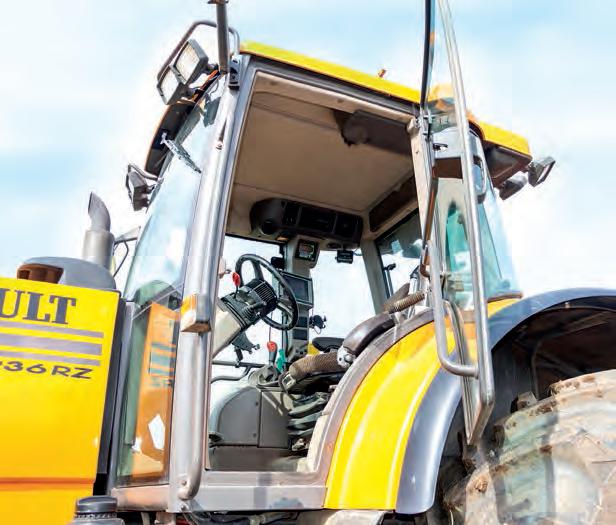
matting.
“Once the Atles was in my ownership I gave the tractor a thorough service replacing all of its oil, belts and filters.

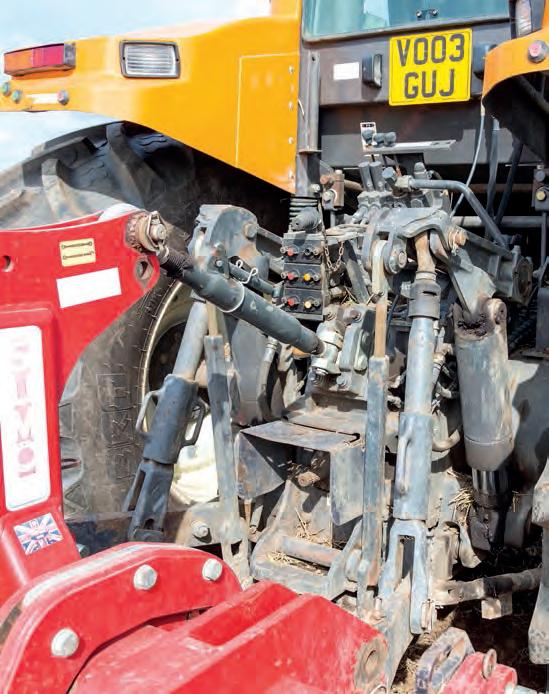
“I also had to reseal the tractor’s steering and lift rams, and replace some bearings in the front axle before fitting the wheels with a new set of BKT tyres.”
Not only did Sam go through the tractor with a fine-tooth comb he also chose to modernise the Atles’
specification prior to putting it to work on his father’s farm with a 3m Sumo Trio cultivator.

“I replaced all of the Atles’s headlights and work lights with LED bulbs and I also installed a Claas GPS Pilot S3 guidance screen, antenna, and Pilot Flex steering wheel sourced from a 2009 Claas Axion 820 to improve the tractor’s efficiency, make it easier to operate and eliminate any unnecessary overlapping when using it with the Sumo Trio,” explains Sam.
Claas introduced the Outback Guidance derived GPS Pilot S3 terminal in January 2009 to provide operators of their combine harvesters, tractors, and foragers greater levels of technology and functionality as standard.
The GPS Pilot S3 terminal incorporates a colour, touch-sensitive 8.4 inch wide screen that features a configurable keyboard to enter data such as A-B lines for individual fields and specific tasks.
GPS Pilot S3
Field borders can also be mapped to calculate the exact area of any given field, while job details, weather conditions and field names can all be stored in the terminal’s 1GB of internal memory and transferred at any time to a personal computer or laptop with a USB connection.
The operator can choose from four
different on-screen displays that show field coverage and where a combine, tractor, sprayer or forager is positioned.
The GPS Pilot S3 can be used with a variety of different signal types, and corrections including the European Geostationary Navigation Overlay Service, Europe’s regional satellitebased augmentation system (SBAS) that provides a pass-to-pass accuracy of 15cm to 30cm.
Alternatively, the terminal can also be used with the OmniSTAR correction service that uses a differential signal located over the Equator that provides pass-to-pass accuracy of 5cm to 10cm. A third option is Claas’s Baseline HD that utilises a tripod mounted base station and works in much the same way as RTK and provides pass-to-pass accuracy of 4cm to 8cm.
Lastly the terminal can be used with a fixed RTK base station to gain the best pass-to-pass accuracy of 2cm to 3cm. Sam uses the GPS Pilot S3 Screen in conjunction with Claas’s Pilot Flex auto-steering system that was designed specifically to be compatible with the S3 guidance screen.
“The S3 screen’s navigation processor sends steering commands to the Pilot Flex steering wheel’s electric motor. These commands are then directly applied to the Atles’s steering system. It works very well and was straightforward to set up,” says Sam. Weighing in at 10.3t, Sam’s stunning
“The Funk powershift transmission is a joy to operate”
4400-hour Atles pumps out 260hp at a leisurely 1800 rpm from its 7.2l turbo charged and intercooled Deutz engine featuring unit injection designed to reduce fuel consumption.
Power is delivered to the ground via an 18x8 Funk powershift transmission controlled by Renault’s tri-functional lever that also incorporates a programmable manoeuvring gear engaged by a single button on the lever.
“The 7.2l Deutz engine is superb and provides you with loads of low-end grunt for primary cultivation work with the Sumo Trio, which it bosses easily,” says Sam.
“The Funk powershift transmission is a joy to operate too and incredibly smooth between ratios.”
Tractocontrol
Traction is provided by a set of chunky BKT 600/65R28 and BKT 710/70R38 front and rear tyres while the 5.73m long Atles is capable of turning within its own length.
“For such a big tractor its surprisingly fleet-footed and nimble when turning on headlands and the tyres barely leave a mark,” says Sam.
The Atles 936RZ’s load sensing hydraulic system provides 110l of oil per minute, while the tractor’s category 3 rear linkage is capable of lifting an impressive 12t. The tractor’s hydraulics are also enhanced by Renault’s active wheel-slip control system called Tractocontrol, or TCE.
Tractocontrol reacts instantaneously to higher levels of wheel-slip when carrying out heavy draft work. A radar unit measures the tractor’s true ground speed to calculate any wheelslip, and the system reacts by reducing draft or adjusting the depth of the implement automatically.
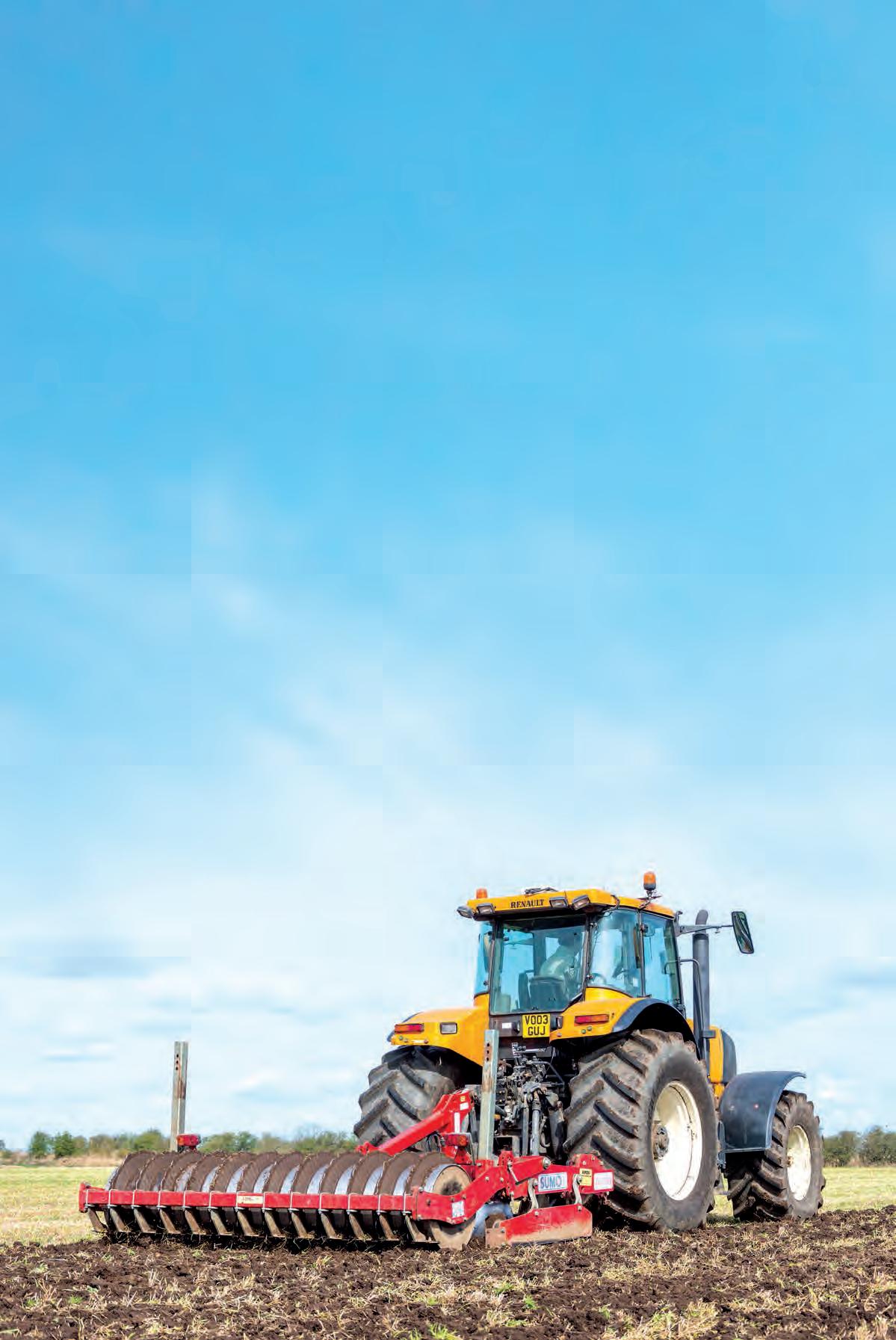
The operator can program the desired working depth of the implement
from a scale of 0-100 using the Tractocontrol touchpad. The system will then automatically calculate the appropriate level of draft required.
“It’s a clever system that saves the operator from having to reach for the spool levers when conditions are challenging and wheel-slip is an issue,” says Sam.

He is a huge fan of the Atles’s spacious Integrale cab and the extras it comes equipped with. These include Renault’s Hydrostable suspension system. The Hydrostable system was first introduced by Renault in 1987 and was awarded gold medals at that year’s SIMA and Royal Shows.
This suspension system fitted to Sam’s 2003 Atles comprises a set of springs and shock absorbers on all four corners of the Integrale cab that’s connected to a torsion bar linkage with anti-rollbars to limit movement and isolate significant levels of shock from
the cab.
Externally, the Integrale cab is fitted with eight powerful work lights, adjustable telescopic and panoramic mirrors, a large opening roof hatch and a side mounted exhaust positioned away from the operator’s line of sight beside the front right corner post of the cab.
The cab’s spacious uncluttered interior includes a fully adjustable tilting and telescopic steering column while the front right and centre A-pillars contain integrated LCD screens to monitor the tractor’s performance, ground speed, engine speed, fluid and fuel levels.
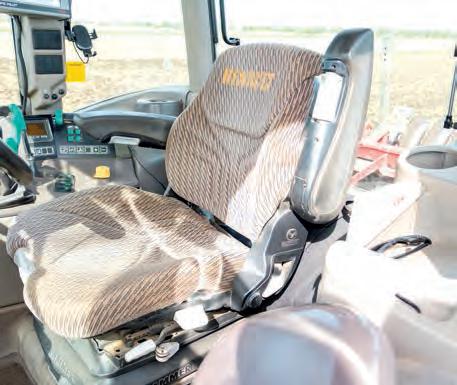
There’s a plenty of useful storage space and cubby holes behind the Atles’s buddy seat, while the operator is provided with a luxurious fully adjustable air suspended Grammar seat.
Sam has added just 600 hours to the ultra-rare tractor over the past seven years .
“I really enjoyed finding the Atles in the first place and giving the tractor a new lease of life,” smiles Sam.
“20 years after it left the Le Mans factory it remains an impressive tractor to operate that’s filled with lots of styling ques, and driver aids you’re likely to find within the design of much more modern and far more popular high horse power rigid tractors today.”
Thanks to Sam Scrowston for his time and assistance with this feature.
“20 yearsafter it left the Le Mans factory it remains an impressive tractor” Above: 19 The Atles’s spacious Intergrale cab comes equipped with this luxurious air sprung fully adjustable Grammar seat Above inset: The Atles’s tri-functional lever is used to operate the tractor’s programmable Funk 18x8 powershift transmission which Sam says works very smoothly


















A new initiative launched in April encourages agricultural and horticultural businesses to knock down barriers and increase work experience opportunities for people from outside the industry.
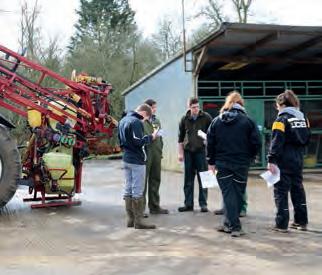
Alack of quality work experience opportunities is one of the barriers young people face when considering a career in our sector, especially when they are not from a farming or growing background.
This follows research by The Institute for Agriculture and Horticulture (TIAH), AHDB, the Chartered Institute of Horticulture, Lantra, LEAF, NFU and TFA, that are now all working together to address this.
A social media campaign during National Work Experience Week in April, helped raise awareness among farmers and growers about the need to provide work experience. This is being followed by further work during the year to seek feedback from employers to identify the common barriers to offering work experience and develop materials to support more farmers and growers.
This is part of a wider cross-sector action plan co-ordinated by TIAH and supported through a working group to attract more people into farming and growing careers.
We need new talent
Agriculture and horticulture industries need to attract new talent. Research shows that we must make closer connections with people from outside the industry by providing first-hand experience of the range of opportunities available.
Although there are already great initiatives promoting careers, there is not only a gap when it comes to giving people the chance to really understand what these jobs involve, but also more opportunity for the different organisations to work together.
There are valid reasons why farmers
Richard Longthorpe is a Yorkshire farmer, TIAH board member and chair of the careers working group

and growers may be hesitant to offer work experience. They may, for example, be short of time or staff to support someone, concerned about health and safety or simply worry about having someone inexperienced on farm.
Offering work experience, however, provides farmers and growers with an ideal opportunity to showcase our individual businesses and our industry. It is likely to provide a more sustainable and resilient alternative to more traditional methods of recruitment.
Working together as an industry we have a greater chance of breaking down barriers and supporting businesses to provide a quality experience for potential recruits.

Benefits for both
A good example are Gaynor and Kieran Wellwood, dairy farmers in Saltby, Leicestershire, who have a long-term commitment to offering
work experience to both veterinary and agricultural students on their farm.
The couple began to support work experience students on their farm because they wanted to inspire the next generation of farmers and vets. They have two students on the unit at any one time. This ensures that they understand the variety of skills and challenges on the farm.
Gaynor says offering work experience has benefited the business because they find that students who have a positive work experience may return during or after they have completed their studies, which eases recruitment in the long term. Additionally, they have found that having students on the farm creates fresh enthusiasm for all involved in the team, providing a harmonious working environment. Organisations that would like to support any aspect of the careers action plan, including the work experience initiative, can contact info@tiah.org.
Right: Work experience can also provide on-the-job training to help equip young people with useful, practical skills
Far right: Job placements introduce students to the skills and challenges on the farm from a working farmer’s perspective
“
Agriculture and horticulture sectors need to attract new talent ”



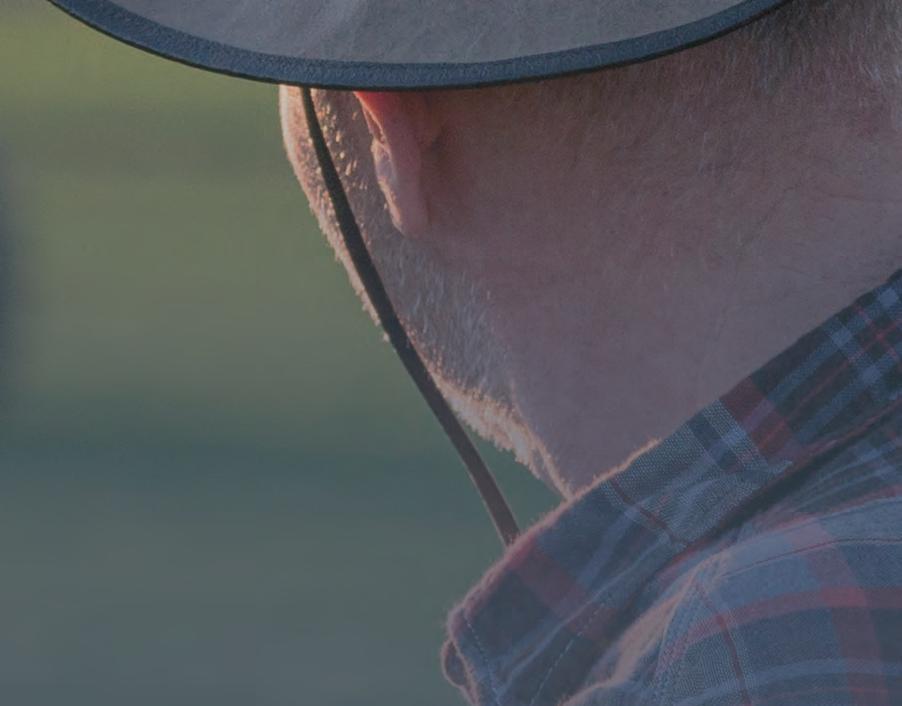








Cheshire, where Charlie Law’s New Holland T7.210 is fresh from the first grassland action of the season. FMJ saw how his tractor is set up for winter and summer duties and how the switch from left to right view is seamless
Machine New Holland T7.210 AutoCommand
Operator Charlie Law
Owner C.R Law
Contracting
Location Chester ADDITIONS
Ram Mount Xgrip x2 £61.99

Ram mounts for boxes, £40-50 depending on fasteners
Airline x2 PCL £23 Amazon
Chrome exhaust cover £234 Agri accessories
Wrap carrier & toolbox No longer available
CB TTi TCB950 £89
post-hedge trimming valet and had only done some forage rye merging since. The 2017 model was bought in 2019 and has clocked 3888 hours.
In the cab
The T7 is ambidextrous, with a McConnel PA 6570 VFR, Charlie has set his tractor out for left-and right-handed operations. With a couple of homemade brackets he has also attached a Ram mount X grip phone holder and used another Ram Mount to position his Revolution box for the hedge-cutter. “Spending most of the day looking out of that side, made sense to have my phone there too,” he says. Familiar with the Ram Mount pages in the
The T7.210 came to C.R. Law Ag Contracting in 2019 from Malpas Tractors. It’s well spec’d out, with a full LED work light package, AutoCommand transmission and front linkage. It’s a real all-rounder and ideal for Charlie’s business. As a mostly one-man operation when it comes to tractors, the bulk of his work is hedge trimming in the winter and grass harvest in the summer. Outside that Charlie uses excavators for
.farm improvement works.
We had the pick of two T7.210s and there is also a limited-edition Blue Power spec tractor, but that had just been on a topping job and was not available. Although New Holland never offered the 210 in Blue Power, which for one of the most popular models seemed odd, Charlie’s tractor was spec’d and painted to Blue Power finish. The standard Blue and white tractor, however, had had its

Sparex catalogue, Charlie has adopted the system for most things in his cab that aren’t screwed down.
On the right side, there is another X-grip mounted for summer operations, with

“We had the pick of two T7.210s and a limited Blue Power spec tractor”






the control box for his Kuhn Mergemaxx 950 mounted. This has the Ram Mounts system attached onto the New Holland


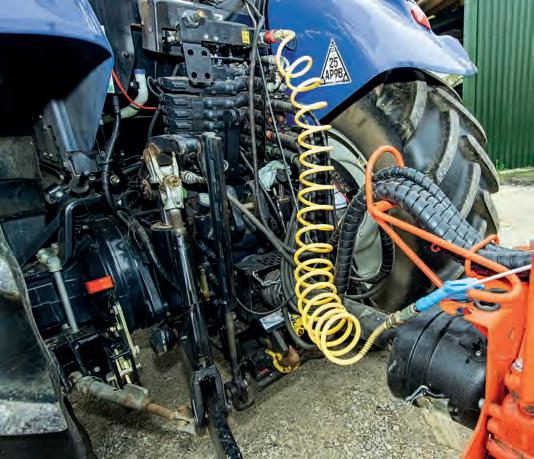
Being a one-man tractor, standards are high. There is an airline for cab cleaning and one outside for machines and radiators. Dirty overalls are banned, without exception. “I carry a spare pair of overalls in case I have a problem that requires getting spanners out and crawling under anything; I don’t want that in my cab,” he says.
Farm Fit Engineering, with a metal box to address the lack of storage on the tractor. This still allows 10 rolls of 750mm wrap to be carried and some tools. There is a strobe light on the frame too to add some visibility to the outfit when traveling the narrow lanes at night.

accessory rail, where a CB is also mounted. The cab is spotless - except the floor, which Charlie did apologise for.
One of the main jobs in grass season is round baling. Running a McHale Fusion+ Charlie had a bespoke wrap carrier made by
The T7 is mostly OEM fit extras, it has the full Lighting package, with Belt line driving lights and the full 16 LED work light kit. To keep his cab clean Charlie uses Autosmart and Autogylm products, taking the approach of ‘keep it right’. All of his kit reflects the same approach.

5
“I carry a spare pair of overalls in case a problem requires crawling under anything”

































Mark carries out all the cultivations as well as drilling oilseed rape with a Väderstad TopDown and BioDrill.
Mark Turner works at Rise Farms, Skirlaugh, near Hull, where he carries out all the spraying, fertiliser spreading and cultivations/drilling

FMJ: What was the first tractor you operated?
MT (Mark Turner): This was a John Deere 2850 2WD with a buckrake, pairing up round bales. I would love to own a 50 Series one day.
FMJ: What is your current tractor?
MT : A Valtra N174 Direct for general everyday use. For cultivations I use a Fendt MT940 crawler and a Bateman RB35 for spraying/fert.
FMJ: What’s your favourite machine you’ve operated?
MT : Last year I got a Väderstad TopDown with BioDrill and that’s the next level. I am also very happy with the Valtra tractor, it’s a great brand.
FMJ: What’s your best and worst day?
MT : A good day is when I get
Below: A past finalist in the FSOOTY competition, Mark takes pride in work spraying and fertilising with the Bateman RB35.
Below right: Mark’s first tractor was this John Deere 2850 he used for pairing up bales with a buckrake.

satisfaction from the job, watching the wildlife and then finishing the day off with a grand sunset. Worst day was June/July 2007 when we had 24 hours of non-stop intense rain that terrible caused flooding.
FMJ: What don’t you climb in the cab without?
MT : My lunchbag and ‘phone, recs if I am spraying.
FMJ: What tools are essential to keep on the tractor?
MT : On the Valtra is the circlip pliers for changing PTO shaft. Also, my ‘phone, so I can use the App for fault codes etc, before I get in touch with dealer.
FMJ: What development in farming has transformed your job?

MT : GPS is common now. But sprayer
technology is constantly changingPWM, individual nozzles, auto-boom height, mapping, record keeping on the move...
FMJ: What machine would you like to get your hands on?
MT : I would like to try the Valtra N175 Direct also the new Q series, but I haven’t a need for that size really. If I didn’t have the Fendt MT940 then would like the 942!

FMJ: What’s playing in the cab?
MT : I never have the radio on! Instead, I have a mixture of songs from Amazon music, streamed via Bluetooth to my cochlear implant. It’s brilliant. No external noise, just the music.
FMJ: What advice would you give young or aspiring operators?
MT : Never be afraid to ask for help/ guidance! Also, in this day an age with GPS, from time to time keep manually operating the machine. It’s a good skill to have that will always be useful.
“ Sprayer technology seems to be constantly changing”







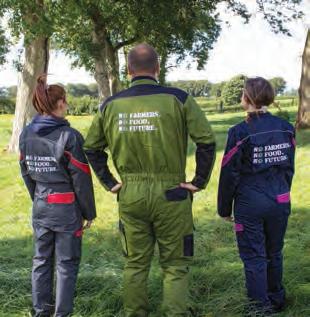













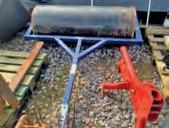











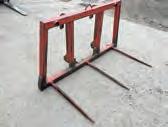
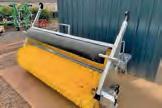















4,000kg of
Compared to other leading brands, Merlo has always been a relatively small player in the UK telehandler market. However, increasing popularity of the bright-green brand has seen a steady rise in market share and demand for models such as the 27.6 and 33.7.
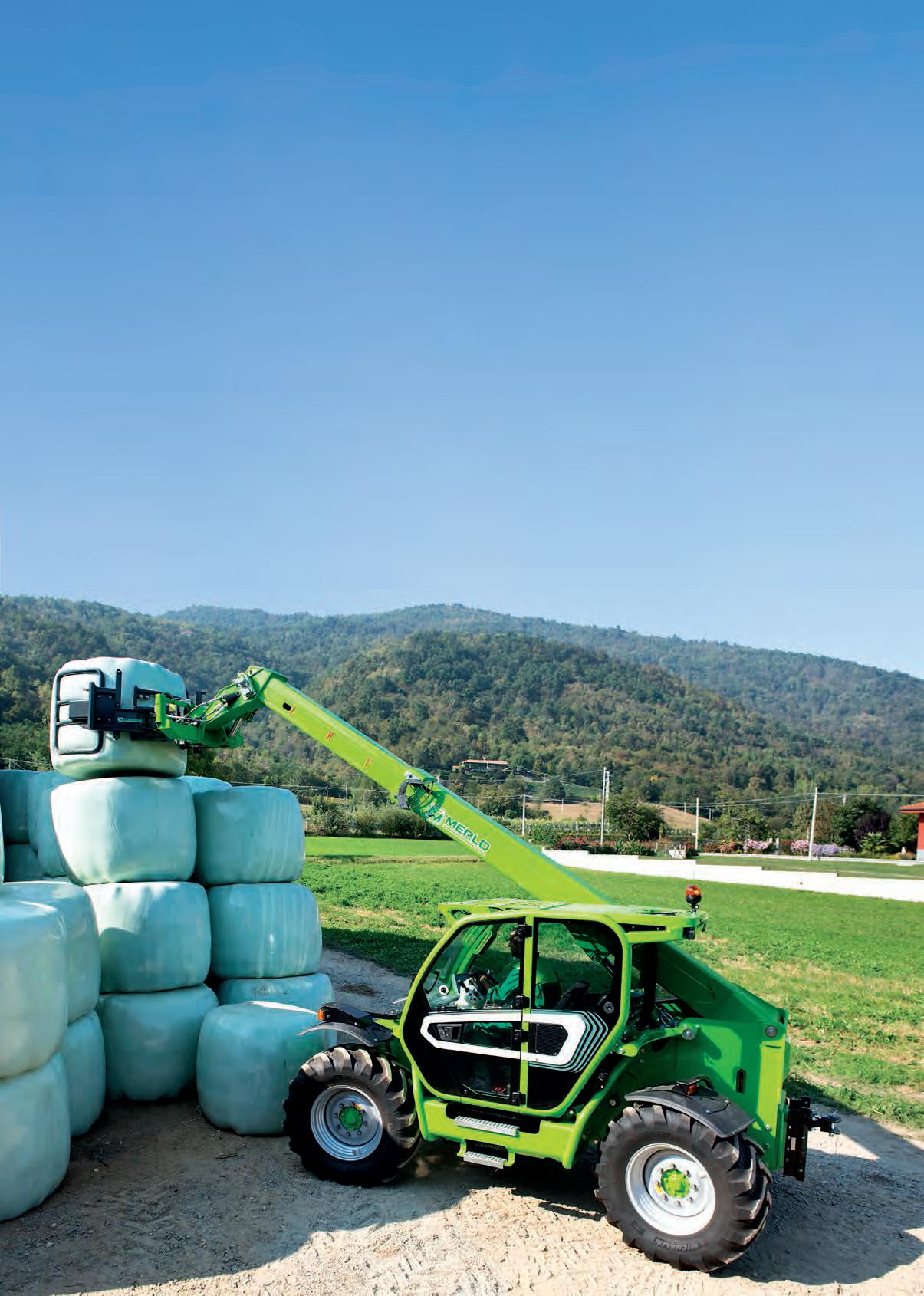
Merlo was originally established in
in the popular 7m
the
1964 by Natalina and Amilcare Merlo, and in 1966 its new and modern Cervasca factory began producing dumpers and concrete mixers for the building sector. In 1981 Merlo hit a turning point with the launch of its first telescopic handler, the SM 30. It offered all the performance of a forklift truck with the versatility of a hydraulic telescopic boom crane.
Merlo first launched its familiar
Panoramic range of telescopic handlers on the UK market in 1987. They ranged from 2.8t to 10t capacity, lifting to heights of 6m up to a dizzy 18m. At first the Merlo brand wasn’t that popular here and limited numbers were brought into the country for construction use. However, their unique integral boom side-shift and 40kph transport speed enabled the green machines to offer
With
lift capacity
category,
TF42.7 has been one of the key sellers for Merlo in the UK. Still in the current line-up, we assess what is on offer from the Turbofarmer 42.7, which has had a number of improvements since its launch in 2014WORDS HOWARD SHERREN IMAGES HOWARD SHERREN/MERLO
“All the performance of a forklift truck with all the versatility of a hydraulic telescopic boom crane”
features not provided by the competition.
The next new range of Panoramics appeared in 1994 when the ‘Turbofarmer’ series was revealed, starting with the P27.7 EV. The machines were specifically designed for British farmers and sales began to increase. In 1997 the P27.7 was replaced by the P28.7 and the P30.7 was joined by its bigger brother the P35.7. Popular models such as 34.7, 38.7, 40.7 and 41.7 also followed. To assist buyers, model designation was fairly straightforward: the first two digits indicated the load and the second digit was the height, so in this case the P35.7 could lift 3.5t to 7m.

As farmers demanded more lift, the eagerly awaited Turbofarmer II models appeared in 2014 with the launch of the TF42.7-120, which achieved 4.2t lift capacity to 7m. It sat alongside the TF38.10 that achieved 10m and above the popular TF33.7 and 35.7 models, powered at launch by 120hp Deutz engine, but the UK saw very few of these models at launch.
In 2015 Merlo increased power using a 156hp Deutz engine, which became most sought after. A 136hp AdBlue version arrived in 2017, before increasing to 145hp in Stage V

Merlo
TF42.7-140
Engine 4cyl Deutz
TCD3.6 L4, AdBlue
Power 136hp
Transmission
Hydrostatic (CV-Tronic option)
Top speed 40kph Hydraulics 150L/ min
Max lift capacity 4200kg
Max lift height
7.10m
Max forward reach 3.70m
Fuel tank capacity 140 litres
Dimensions LxWxH
(m) 4.49x2.25x2.46
Weight 7450kg
Tyres 405/70-24
models. The supplier was changed in 2023 when engine supply became a problem and a 136hp Perkins took its place.
The transmission remained a two-speed hydrostatic with an option of the new CV-Tronic infinitely variable version. All came with load sensing and offered a greater flow of 150 lit/min to power attachments more efficiently. The variable pump technology offered greater hydraulic performance with accelerating hydraulics to improve efficiency.
Also, features such as a reversing fan were standard, as were the trailer hitch and trailer brakes on agri models. The 42.7 remains a popular choice in the current line-up as it utilises the same ZM2 headstock configuration as the smaller models before moving up to the ZM3.

Perkins, Deutz and Kubota Merlos boasted an array of engine suppliers, such as Perkins, Deutz and Kubota, and the 42.7 did receive multiple engine options. The initial 120hp Deutz engine was upgraded in 2015 to a massive 156hp Deutz engine that did not need AdBlue. It was one of the largest telehandlers on the market and gained particular desirability on the used market.
The model remained until the introduction of Stage IV final
emissions regulations when AdBlue was introduced on the TF42.7-140 with a 136hp Deutz in 2018. As mentioned before, power was increased to 145hp in 2020 with the launch of Stage V, before engine availability was hit hard and a Perkins unit was reintroduced, reducing power back to 136hp.
Engine feedback has been generally good as many appreciated the increase in power, especially those with the initial 156hp unit. With
the addition of an extra tank, AdBlue did create a few issues, as pumps, quality and level sensors occasionally gave problems.
Fuel consumption has also been considered lower than the previous engines, despite the extra horses. A reversing fan and larger oil cooler also increased cooling capacity, which is especially useful when using constant pump attachments such as straw spreaders or sawdust dispensers.
Merlo headstock and locking
remained relatively unchanged and will take a lot of pressure. Check for signs of abuse and the condition of the pressure pipe that can rub and rot through
clean.
Worn headstock bushes are quite easy to change if the pins can be persuaded out. Check the crowding ram for damage and pitting that would result in ram seal failure, indicated by oil leaks. Check the retaining bracket bolts are kept tight.
Check the attachment fittings are correct if changed from the original screw-on Merlo type. The electric sockets on the front of the boom for fitting self-operated man baskets became standard on this model; ensure the covers and brackets are all in place.

“Merlos boasted an array of engine choices, such as Perkins, Deutz and Kubota”
The TF42.7 originally used a 120hp non-AdBlue engine that was quickly changed for a 156hp engine. This unit attracted plenty of interest and was kept till 2017 when it was swapped for an AdBlue 136hp Deutz power plant
2006 | Successful 26.6 model replaced by the 32.6, allowing 3.2t to 6.4m. Available in two specification levels, the Compact range also consisted of the smaller 25.6 and 8m 28.8, powered by 100hp Deutz engine. Also joined by larger frame Turbofarmer P models 34.7, 38.7, 40.7 and 41.7.
2009 | Original Deutz engine replaced by similarly powered Stage IIIA Perkins unit; no noticeable change in performance.
2012 | New modular design introduced with Turbofarmer 2.
2013 | Controls and cab interior updated with new shuttle buttons and joystick design. New Turbofarmer II models revealed: 38.7, 40.7 and 42.7. Flagship 42.7 wins machine of the year 2014 at Agritechnica.
2014 | Engine changed on smaller models to Kubota V3800 to meet Tier 4 emissions, featuring electronic management, a diesel oxydation catalyst and particulate filter with active regeneration.
2015 | Initial 120hp engine in the TF42.7 replaced with a 156hp Deutz engine, again delaying use of any AdBlue exhaust treatment. Very few 120hp engines made it to the UK in the 42.7.
Check the fan for broken fins; the cowling/support has been known to crack. Look over the coolant hoses for signs of perishing and kinks. One crucial point is to check filters and the wiring on all machines for signs of rodent damage.
The transmission is one of the key areas that sets the machine apart from the competition. Like previous models, the two-speed transmission
Axle ground clearance was praised as ideal for working on the clamp, with 460mm clearance on the standard 405 tyres. The swivels will need attention, some were greasable but most were neglected. Check hub seals for leaks and track rods for play.
is operated by a rocker switch on the steering column that selects between gears 1 and 2, allowing infinitely variable speeds up to 25kph or 40kph. Take your foot off the accelerator and the machine remains stationary, unlike other torque amplifier transmissions. However this led to further problems where brakes aren’t used for long periods on earlier models.
The transmission also benefits from a cruise control, by holding
Do your best to assess the main lift ram and compensating ram for oil leaks, then for wear in the pins and bushes especially on higher hours machines. Although relatively simple to replace, major damage could occur if left too long.
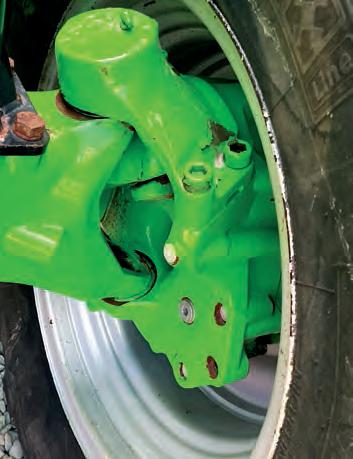

2016 | 120hp 33.7 launched to replace the smaller 32.6, now with a Deutz engine. Several new features include a reversible fan and automatic hydraulic acceleration, but no models make it to the UK. The 120hp engine replaced by a 115hp unit and first models arrive in the UK in January 2017.
2017 | The 156hp non-AdBlue Deutz engine replaced by 136hp AdBlue Deutz to meet latest emissions regulations.


2020 | Engine power increased to 145hp from 136hp, the di erence being only slightly noticeable
2021 | New Stage V models introduced, increased engine e iciency, new-style joystick, screen, fenders and styling.
2023 | Engine changed to Perkins and reduced to 136hp due to supply issues.
The new exhaust on the later 136hp Tier 4 engine was located in the worst possible position. Ensure it hasn’t been knocked, and check each fender skin, frame and headlights for cracks and damage.
the shuttle lever forwards for more than a few seconds, a beep sounds and the machine remains travelling at that speed, which is ideal for long periods of road work. Shuttle controls are again duplicated on the joystick as before – on top on Tier 4 and underneath on Stage V. Four-wheel drive is permanently engaged for maximum traction in all conditions, while the parking brake sounds a buzzer if not activated when the operator leaves the seat. It is also activated automatically when the engine is shut-off.
The CV-Tronic transmission option builds on the existing hydrostatic transmission, using one electro-

hydraulically controlled pump and two axial piston motors to give smooth uptake of power. The transmission offers maximum torque at low speeds, plus as much as a 12 per cent increase. There were a few early teething issues and it is less common in the UK, predominantly due to the increased price tag. Track-rod end life is usually very good at 3000-4000 hours, but assess the play where possible.
The 42.7, like other models in the TF range, uses a load-sensing (LS) pump with an electro-mechanical joystick .At 150 litres the pump gives excellent performance with a two-section boom to achieve a maximum height of 7.1m and forward reach of 3.7m.

Boom suspension continued to be a popular option, although most salesmen were good at specifying it as standard. The standard Merlo carriage used the traditional threepoint latching, with a single springloaded pin required to lock and unlock attachments. The pin is often abused and damaged at the end. If any wear is present it will likely be in the housing. The headstock can be
machined to take a new sleeve to eliminate any play.
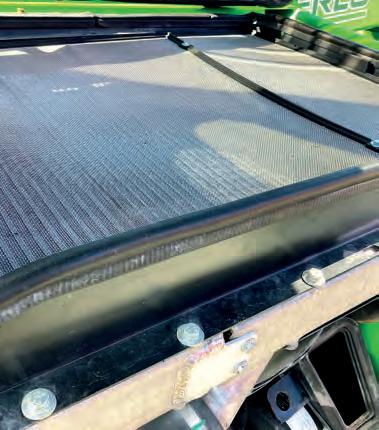
The bushes on the boom and crowding ram are relatively cheap and easy to replace if pins have been well greased. The attachment locking activation pipe will often require changing due to frayed or damaged braiding. Check the couplers are in good order and assess if they will need to be changed to match your attachments. Also, it is worth noting, if you don’t currently run a Merlo, a check-valve will be required on all the associated attachments to avoid any pressure loss.
Also highly sought-after are TT models, which allow 530mm of side movement on the longest reach. Give
“Both doors can be pinned back allowing the operator to jump on and o quickly”
a once over of any pipes, including the internal boom pipes for signs of oil leaks. Check the lift ram bushes for signs of play, as only the top of the compensating ram wasn’t greasable and ensure they aren’t leaking oil.
The Merlo cab is another strong attribute to the machine, not just for
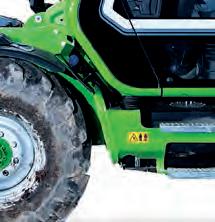




the excellent all-round visibility, but also the 1010mm of width space for the driver.


The Merlo is still one of the only handlers on which both doors can be pinned back to the side of the machine, allowing the




operator to jump on and off quickly. Unfortunately, the doors can also be knocked-off in some cases.
Three different seat options were available, starting with the basic mechanical suspension, followed by a basic air seat and finally the Grammer air seat, the preferable option. However due to supply issues, the latter may not be available on newer machines. The airconditioning option has improved in

efficiency and become more popular. Assess the condition of the fans, which generally should be better than on older models.


Check the joystick operates correctly, also each of the shuttle buttons and shuttle work without creating an error. Also ensure the load monitor works, as load sensors can be a common problem, often indicated by errors, a flashing display or de-rated slowmoving boom.
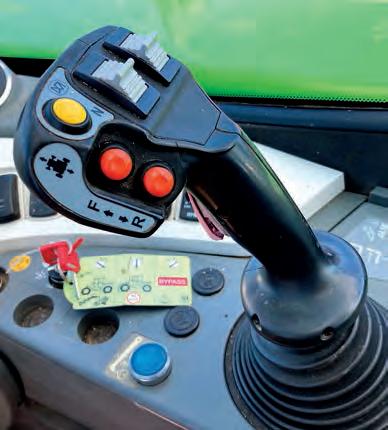
moving boom. The standard CDC dynamic load control
range was first seen in 2014 before arriving in the UK in 2015, and still remains in the current Merlo line-up. It sits alongside the 10m TF38.10. The smaller TF38.7 and TF40.7 were dropped from the offering

The air conditioning has been continually improved in previous years, but there have been issues. The rear fan design has been modified but still requires maintenance to keep in good shape. Check it works and the system reduces the temperature.
wheels and tyres. The 42.7 is predominantly supplied on 405/70R24 Mitas tyres fitted at the factory and should generally last around 4000 hours before replacement. The wider 460/70R24 Michelin XMCL radial hasn’t been available in large numbers in the last two years, although Trelleborg is a very good replacement.




Thanks to service technicians at RVW Pugh Ltd, Holmes Chapel, and Merlo UK for their help compiling this guide.
display provides information such as attachment in use, worked area/loads, boom positioning, operation parameters and stability index. Cab suspension (CS) is also a popular choice on the 42.7, the only telehandler to offer such an
extra.
Finally, investigate the


All tyre manufacturers agree on the importance of the correct pressure to guarantee the performance of their tyres. In agriculture, the variety of vehicles, applications and implements require regular and appropriate adaptation of tyre pressures to ensure their service life and other key performance factors like traction, fuel saving and soil protection.
Finding the tyre pressure you should use can be challenging, but now the European Tyre and Rubber Manufacturers’ Association and 12 leading tyre brands have collaborated to produce a smartphone app that puts all the key data in the operator’s hands.
The new Agro Tyre Pressure app is claimed to be the only one that combines each manufacturer’s pressure, load and speed table databases. Users of Bridgestone, Continental, Cultor, Firestone, Kleber, Maximo, Michelin, Mitas, Nokian, Taurus, Trelleborg and Vredestein tyres need to select their tyre brand and size, along with the axle load and working speed to find the most appropriate tyre pressure for the job.

Machine Mart’s latest range of impact wrenches includes two units that can be used away from mains power – an essential factor when running repairs are needed out in the field.
The Clarke CIR18LIC is a half-inch drive impact wrench supplied with two 2Ah batteries and a charger. It o ers max torque of 450Nm and comes with three built-in LED work lights.

Wearing parts supplier Agricast has extended its range of replacement tungsten carbide cultivator points.
The company now o ers tungsten carbide parts for the Köckerling Allrounder, Kongskilde Vibroflex, Lemken Karat and Väderstad Topdown, as well as an expanded range of universal fitment points.
Like Agricast’s tungsten-tipped plough points and weld-on parts, the new cultivation points are said to deliver maximum wear resistance and great value for money.
“We’ve had considerable success with our tungsten range of parts since introducing them in 2018,” commented Agricast managing director William Robinson. “Customers have praised the quality and durability of the parts, and we’ve been keen to respond to customer demand wherever possible.”
www.agricast.net

If you don’t need quite as much torque, the Clarke CCIW160 is the latest addition to the range. Another half-inch drive impact wrench that also comes with two 2Ah batteries and a charger, it o ers maximum torque of 160Nm and has a no-load speed of 0-2200rpm.
Also available is the Clarke CIR13C half-inch drive impact wrench. Weighing only 2.4kg and o ering maximum torque of 350Nm, it is powered by 12v auxiliary sockets, portable 12v power packs or most 12v batteries. The kit includes a 12v socket adaptor and 12v battery clips and is also supplied with two double-ended impact sockets (17/19mm and 21/23mm).
www.machinemart.co.uk





























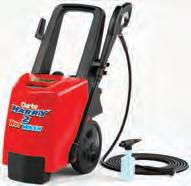














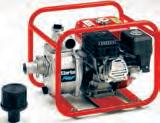
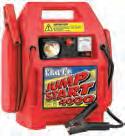
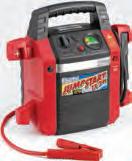
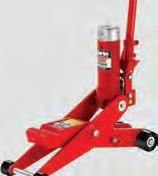
























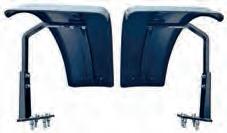

















WORDS AND IMAGES GEOFF ASHCROFT


It is your responsibility as the driver of the towing vehicle, to ensure all lights work. At the rear of the trailer, those lights need to include two red side lights, two red brake lights, a number plate light and two amber-coloured indicators.
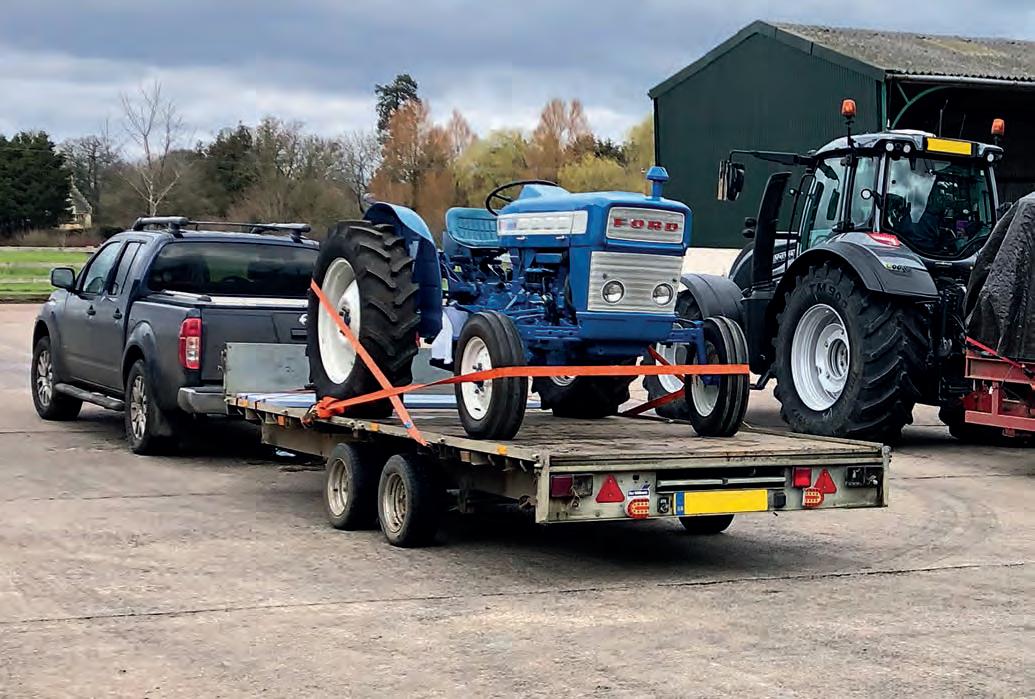

Two triangular rear red reflectors are also required, along with at least one fog lamp on the back of trailers more than 1.3m wide – the fog lamp must be fitted to the offside rear. And those trailers manufactured after 1 October 1985 that are wider than 1.6m also require front marker lights with a clear lens.
While most older vehicles use seve-pin sockets, newer vehicles and trailers can be equipped with 13-pin sockets. Seven-pin meets the legal lighting requirements for towing, where

When keeping trailers in a roadworthy condition, the law asks all lights to be operational. Where do you start when the lights have gone out?
“Newer vehicles can be equipped with 13-pin sockets”
all else fails, and there’s a requirement to use lights, the Connix wireless, magnetic lighting kit provides basic lighting functions such as side lights, brake lights and indicators to warn other road users
Right: Conventional 7-pin towing electrics are numbered as follows. With both stop lights supplied through one pin, if only one bulb illuminates, the chances are the other bulb has failed. Dimly lit bulbs are a result of an earth fault


Far right: The more complex 13-pin system provides additional power supplies for greater functionality. This enables the towing vehicle to provide power for reverse lights (8), a permanent power supply (9), fridge connection (10), a spare (12) and multiple earths (11 and 13)
Left: Connix transmitter plugs into any 12-volt towing vehicle using the 7-pin system, and relies on Bluetooth to send the required signal to the magnetic light units. It’s a canbus compatible system

Below left: This towing vehicle is equipped with a 13-pin socket, which provides extended functionality for newer trailers using a 13-pin plug and wiring loom. Additional pins are used to operate reversing lights for example, or supply internal power for caravans
Below: This trailer uses 13-pin electrics and has an connecting lead to connect it to the towing vehicle. Check pins for corrosion, and establish that power is passing through the wires using electrical test equipment

13-pin provides greater functionality and advanced power features. This can be to supply power for caravans and also trailer stability systems.
Additionally, 13-pin electrics are also used to operate trailer reversing lights. Most 13-pin towing vehicle set-ups are clever enough to cancel out the towing vehicle’s fog light and reverse lights when a trailer lighting socket is attached.
There is compatibility between both 7- and 13-pin systems, and this can be achieved using a towbar electrics adapter. These are available as seven-to-13 and vice-versa, allowing either the towing vehicle or trailer to operate with the minimum standard connections.


If your tow vehicle has a 7-pin socket and your trailer is

“Chasing electrical faults is a tedious game”
Left inset: A 13-pin to 7-pin trailer socket adapter can also be used to convert 13-pin trailer sockets to a 7-pin system, to suit older towing vehicles. Pin sockets are also numbered, making it easy to check the functionality of each connection

equipped with 13-pin electrics, you won’t get the additional capability, as this handy adapter only extends the basic seven-pin functions.
Chasing electrical faults is a tedious game, but it rarely gets more complex than a bad/loose connection or a failed bulb. So start by making sure all socket connections are in good condition and are corrosion-free. This will ensure good electrical conductivity, which can be helped by a few

Left: This male plug socket plugs into the tow vehicle’s female socket, relying on the pins of both sides being a clean, interference fit. Any dirt or corrosion in here is likely to prevent a reliable electrical connection, sending the driver on a wild goose chase to trace and cure the problem
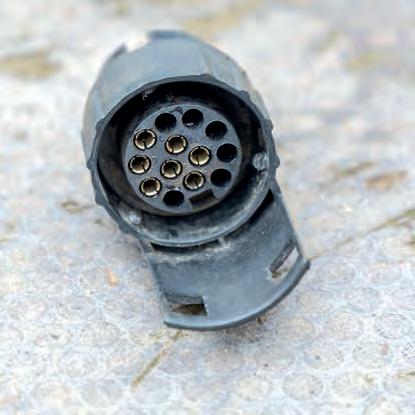
Above inset: A 13-to-7 pin adapter can be used to convert a modern towing vehicle equipped with 13-pin electrics into one that can create a 7-pin outlet to power an older trailer. Along with an earth, 7-pin supplies power for side lights, brake lights, number plate light, indicators and fog lamp

Below: It’s important that light lenses are both clean, and intact. Broken lenses allow dirt and water ingress, which leads to corrosion and ultimately, power failure through poor connections. Replace or re-seal as required




generous squirts of a lubricant such as WD-40.

Corroded terminals will need cleaning up. It’s also worth checking for any wires that may be trapped, chafed or simply loose in their sockets, that could also need replacing or tightening.
Use of a multimeter or a 12-volt electrical-test screwdriver is a good place to start to ensure that the towing vehicle is sending power to the towbar socket.
Left: With a 13-pin to 7-pin vehicle socket adapter, this towing vehicle instantly gains compatibility to operate older trailers equipped with the 7-pin system. This handy adapter only extends the basic 7-pin functions to meet the legal lighting requirements for towing


Left: Using a 12-volt electrical testing screwdriver, check for power at the pins. You’ll need to connect to the earth pin, then carefully work your way around the numbered pins making a connection with the vehicle lights turned on. Power will illuminate the screwdriver
Below inset: Junction box at the back of trailers makes it easy to check for power. The main fed in to the box can be checked first, with each power rail offering an onward supply that is used to feed individual lights

Below left: Replaceable extension leads are easy to replace if they’re accidentally left connected when the trailer is detached. While this can limit damage, it does mean additional sockets are used, increasing the chances of poor connections

www.ntta.co.uk www.gov.uk www.smmt.co.uk
Establish power by connecting between the earth pin –number 3 – and systematically checking power at the remaining pins numbered 1 to 7. This will at least narrow down the location of the problem – towing vehicle or trailer.
With the towing socket connected, it is then a matter of progressively checking for power at every connection, to rule out loose or bad joints. Intermittent faults can be harder to track down. Wiggling connectors or sockets can


highlight a loose fit. Some trailers use a junction box that receives power at the back of the trailer, where it is then distributed to individual light units.
Be sure to remove the light lenses and, after cleaning them, check for power at the bulbs too. If power makes it to the bulb pins but doesn’t illuminate the bulbs, then it’s likely that a bulb filament has failed.
And if you don’t have an assistant to press the brake pedal for you, wedge a piece of wood between the seat base and the brake pedal, to activate the brake lights.

“Wiggling







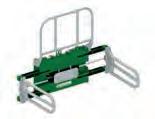




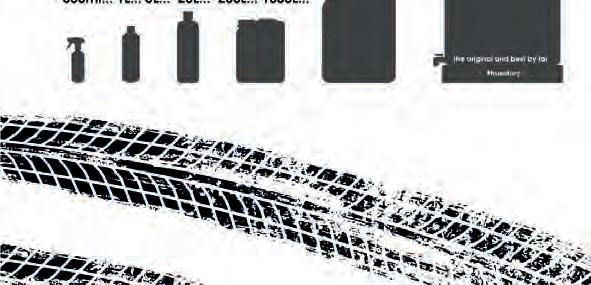











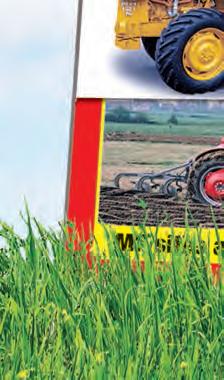
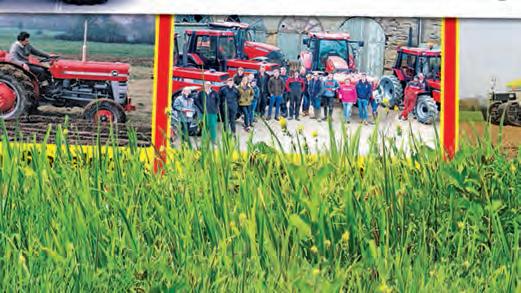




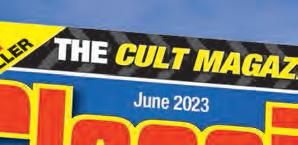











1982 Zetor Crystal 10011 Turbo // Hydrocut Simian
Above: Lincolnshire-based Dee Hardman first operated a hedge-cutter more than 50 years ago. He still loves the work and bought this smart 1982 Zetor Crystal 10011 Turbo and heavy-duty Hydrocut Simian hedge-cutter last year
Dee Hardman rst operated a hedge-cutter in 1972 for a farmer and contractor near Diss, south Norfolk. More than 50 years later he’s still cutting hedges with a 1982 Zetor Crystal 10011 Turbo and a Hydrocut Simian hedgecutter. FMJ visited Dee last autumn to see his Zetor in action
WORDS AND IMAGES DAVID LALEY
Dee Hardman was brought up on a farm in Suffolk where, from a very early age, he became fascinated with operating and tinkering with all types of farm machinery. In the early 1970s he studied agriculture at Chadacre Agricultural Institute at Bury St Edmunds. In 1972, while working on a large farming estate near Diss, on the Norfolk/Suffolk border, he had the opportunity to operate a hedgecutter for the first time.
task on all of the farms I worked at for the next 25 years.”
Hedge-cutting became my favourite task on all of the farms I worked at for the next 25 years
In 1997 Dee chose to go self-employed and bought himself an old David Brown 1200 matched to a Bomford Brigand long-reach hedge-cutter. “I didn’t have the 1200 for long because unfortunately its crankshaft snapped. I ended up swapping it for a 65hp Belarus 572, which I absolutely loved using for hedge-cutting,” he smiles.
the Bomford 588 to sit level on the front of the Unimog and it became my all-time favourite hedge-cutter.”
Renault Nectra
“I was given the keys to a Lambourncabbed Ford 4000 attached to a Bomford Bushwacker hedge-cutter, and really enjoyed using it,” he says. “It was fitted with a 1.2m heavy-duty flail head that could work at a maximum height and reach of just over 4.5m. It was a very manoeuvrable and easy-tooperate outfit that got me hooked on hedge-cutting, which became my favourite
“You sat up at a decent height in the Belarus’ cab so you could see the flail head perfectly through the large glass windows and windscreen fitted to the 572’s six-post cab.
“I ran the 572 and Brigand for the next two seasons before swapping them both for my ultimate hedge-cutting combination, a 1985 Mercedes-Benz Unimog U1000 matched to a heavy-duty front-mounted Bomford 588 contractors’ specification hedge-cutter that had a maximum reach of up to 6m. I modified

After running the Unimog/Bomford successfully for several years Dee swapped it for a more modern JCB Fastrac 155-65, which he used with a later Bomford Turner hedge-cutter that he again altered to his own specification. “I never quite gelled with the Fastrac, so I ended up changing it for a rare special-edition Renault Nectra, which had all the credentials to be a superb hedge-cutting tractor. It was equipped with a comfortable tall cab and had a decent long wheelbase
Owner Dee Hardman Location Stow, Lincolnshire Occupation Self-employed engineer, machinery operator and contractor Hours 7600
for stability,” he explains.
“Unfortunately, it was plagued with gearbox problems and after becoming disillusioned with its performance I chose to sell up and had a stint lorry driving before going back to working on various large farms.”

In 2014 Dee moved from Suffolk to Lincolnshire where he continued to work on farms as a machinery operator and began hedge-cutting again, this time with a classic Massey Ferguson 2620 fitted with a 150hp turbocharged Perkins Phaser engine that had previously powered a Dodge-based Renault lorry. He used the 2620 with a mid-mounted Econ hedge-cutter, which he admits he didn’t enjoy operating as much as the front and rear-mounted Bomford-based flails he’d run previously.


“The re-powered 2620 and Econ hedgecutter made an excellent combination but I always preferred looking at the flail head from the front or the rear, I felt like I had a better view and control of the flail head when it was mounted on an arm attached to the front or

Turbo
Engine 4.6-litre
four-cylinder
turbocharged Zetor
Z8002 diesel
Bore and stroke
110mm x 120mm
Rated speed
2200rpm
Power 100hp
PTO hp 94 @ 1000rpm
Fuel tank 90 litres
Clutch 325mm single dry disc plate
Transmission 8 forward 4 reverse with torque
multiplier
Top speed 17.5mph
Steering Power assisted
Rear linkage capacity 3.4t
Hydraulic pump output 31L/min
PTO speeds
540/1000rpm; 6 and 21-spline shafts
Tyres Front, 7.50 x 20; rear, 18.4/15 R34 and 480/85 R34
Length 3.94m
Height 2.47m
Weight 4.2 tonnes
rear of the tractor,” he says. He eventually moved the Massey Ferguson 2620 and Econ trimmer on before settling with his partner Laura at his current home, a rented smallholding near Lincoln, in 2020. He continued to operate machinery for local farms while completing engineering projects in his workshop at home. A talented engineer in his own right, back in the 1990s he competed successfully in the sport of tractor pulling in the PPA mini modified division with his Rover V8-powered tractor called Hayley’s Comet, named after his daughter.
Last year he had the chance to cut back some overgrown hedges locally and needed a suitable tractor and hedgecutter to complete the task. He found just what he was looking for in the shape of a very tidy 1982 Zetor Crystal 10011 turbo that had been attached to a heavy-duty Hydrocut Simian
hedge-cutter. “I found it for sale locally near Lincoln where it had worked for the vast majority of it’s life,” he says.
“The 10011 was originally supplied by former Zetor dealer George Howard and Sons from Louth and it appeared to be in excellent cosmetic and mechanical order. When I got it home, I gave it a comprehensive service, and replacing all of its fluids and filters. The only component I ended up replacing was the water pump while I also fitted a new Alliance 480/85 R34 rear left tyre. The tractor’s left-hand side carries the bulk of the hedge cutter’s weight when it’s folded close into the cab or when it’s working at its maximum reach of 7.7m. The last thing I wanted was an older tyre going bang while in operation.”
Zetor’s 10011 joined the Crystal range of tractors in 1980, slotting in between the 8011 and larger six-cylinder 12011. It was effectively a turbo-charged version of the four-cylinder 85hp Crystal 8011 that was originally launched in 1969.
The 10011 is powered by a water-cooled, direct injection, 4.6-litre, four-cylinder
The 10011’s major selling point was its enormous and well speci ed at-deck cabAbove: The 10011’s spacious flat-deck cab comes with a dash-mounted hand throttle, floor-mounted gear levers, heavy-duty interior cladding and roof insulation, and a sprung seat Left: A previous owner fitted the 10011’s huge cab with these guards to stop branches and debris from overgrown hedges breaking the glass Right: The Hydrocut Simian is attached to the 10011 from the rear and features a bracing frame that runs below the tractor’s rear axle. It’s then attached to the tractor’s chassis rails using a jack to pivot the mounting brackets so they line up with the bolt holes
turbocharged Zetor 8002 engine that develops 100hp at 2200rpm and 94hp at the PTO shaft.
Dee’s example is fitted with Zetor’s standard 90-litre fuel tank. Power is transmitted through a single-plate dry clutch to an eight-forward, fourreverse speed constant mesh transmission equipped with a torque multiplier that doubles the number of forward and reverse ratios, enabling the 10011 to travel at a top speed of 28kph.
At the rear both 540rpm and 1000rpm power-take off shafts can be used to power a whole host of implements, including the Hydrocut Simian hedge-cutter’s shaft-driven oil pump. Stopping power is provided by a set of hydraulically engaged dry disc brakes while the 10011 also features power assisted steering and an adjustable front axle that offers the operator up to four different track widths.
Left: The Hydrocut Simian’s clever boom geometry is controlled by four hydraulic rams. The main arm can swing through 90 degrees, allowing the tilting Hornet flail head to work close to the side of tractor, as well as over, above and below overgrown hedges and trees Left inset: The left-hand side of 10011 carries most of the Hydrocut Simian’s weight when it’s folded for transport. To avoid an inconvenient blow-out, Dee replaced the tractor’s original left-hand rear tyre with this new ballasted Alliance 480/85 R34 tyre
The 10011 comes equipped with a Category 2 rear three-point linkage capable of lifting a modest 3.7t while the tractor’s hydraulic system was fitted with lower-link sensing as standard when new. The 10011’s hydraulic pump is situated in the bell housing and provides a useful output 31 litres/min. Without doubt the 10011’s major selling point back in the early 1980s was its enormous and well specified 83Db(a) flat-deck cab, which came equipped with a sprung seat, thicker interior cladding, floor-mounted gear levers and a neat hydraulic quadrant situated to the right of the operator. Notable external features included an air compressor, windscreen wiper blade and front-hinged doors that could be held partially open to allow more air in on a warm day.
Dee’s later black, orange and creamliveried 10011 was first registered in 1982, the year Zetor transferred production of the
Crystal range to the ZTS Martin Corporation’s facilities in Slovakia. The 10011 was replaced by the 10111 in 1985. “It’s been a very good tractor and is an excellent match for the heavy-duty Hydrocut Simian,” says Dee. “It’s fitted with a lovely long-stroke engine and the transmission works well too. However, while the cab is incredibly spacious, I feel like I’m sitting too low down to see the flail head properly at work, which is why I’ve now found a buyer for the tractor in Northern Ireland.
“I’ve just done a deal on a 1985 Belarus 860D, which I intend to modify to suit the Simian hedge-cutter this autumn. It’s going to be equipped with ballasted rear wheels and tyres from a combine harvester, while I’m going to fit larger tyres from an old Mercedes Benz Unimog on the front. I also intend to fit an Opico turbocharger to the engine to create a bit more power, and a Massey Ferguson front loader to increase its versatility as well.

“I’ve fond memories of the Belarus 572 I used to run, which I maintain was one of the best tractors I’ve ever used for hedge-cutting. The goal will be to create an economical and rugged outfit to cope with tough overgrown hedges locally, which I know will be well within the ageing Simian’s capabilities.”

Dee Hardman bought this lovely 1982 Zetor Crystal 10011 Turbo and Hydrocut Simian hedge-cutter specifically to cut back and manage thick, often overgrown hedges on properties and farms close to his home in Lincolnshire
Originally from Sudbury, Suffolk, in the early 1950s Hydrocut was the first specialist engineering company to design and introduce a hedge-cutter that used hydraulic controls and rams. The Simian came along in the early 1980s and was an updated version of Hydrocut’s most famous heavy-duty hedge cutter, the Giraffe, latterly named the G-RAHF for legal reasons.
The Gira e Hydrocut launched the rear-mounted Giraffe in 1976. It was primarily designed for use with Ford’s 6600 tractor, but could be used with several other manufacturers’ models and came with a minimum power requirement of 60hp. The Giraffe had the longest and largest reach of any other hedge-cutter at the time.

It was capable reaching up to 7m in height and 7.7m horizontaly, and could also trim the tops of hedges with a level flail up to 5.5m in height. It came equipped with its own self-contained hydraulic system that comprised a 145-litre oil tank and a PTO driven pump. Its clever boom geometry was controlled by four hydraulic rams, which allowed it work either side of the host tractor
and enabled it to work over the sides of hedges, below ditches and around most other obstacles such as trees, signposts and telegraph poles.
The Giraffe’s main arm could swing through 90 degrees so it could work tight up to the tractor’s cab while the flail head could tilt through 230 degrees.
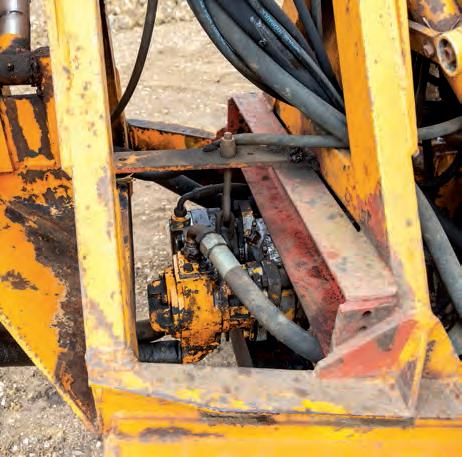
The updated Simian was similar in design but could be equipped with a new multi-purpose 1.2m flail head called the Hornet and Hydrocut’s improved indexable breakaway boom. In 1980 the list price for the Simian fitted with the Hornet flail head was £7000, and it remained in production until the mid-1990s.
“Despite its age it’s been very reliable and is great for taming the toughest hedges,” says Dee. “However, it did take me a little while to

Top: Dee recently sold his Zetor Crystal 10011 Turbo to a buyer in Northern Ireland and has now purchased this 1985 Belarus 860D from a local contractor to refurbish and use with the Hydrocut Simian later this autumn
Left inset: The rear-mounted Hydrocut Simian comes equipped with its own self-contained hydraulic system that includes a 145-litre oil tank and a PTO-driven pump
acclimatise to its control layout.
Since I first began using it, I’ve fitted a Bomford flail head so it folds in closer to the tractor and I’ve also uprated the hydraulic pump. I’m really looking forward to putting it through its paces on some tough hedges with the Belarus 860D later this year, while I also intend using it with a saw blade attachment.”
ACKNOWLEDGEMENTS Thanks to Dee Hardman for his time and assistance with this feature.
Is your classic tractor still putting in a shift that puts modern kit to shame? Prefer the bark of an old-school six-cylinder? Favour on-farm fixes without connecting a laptop? We want to see your older machines in action. Send details of your working classics, ideally with a photo or two, to info@farmmachineryjournal.co.uk and they could feature in FMJ soon!


was the rst hedge-cutter that used hydraulic controls and rams



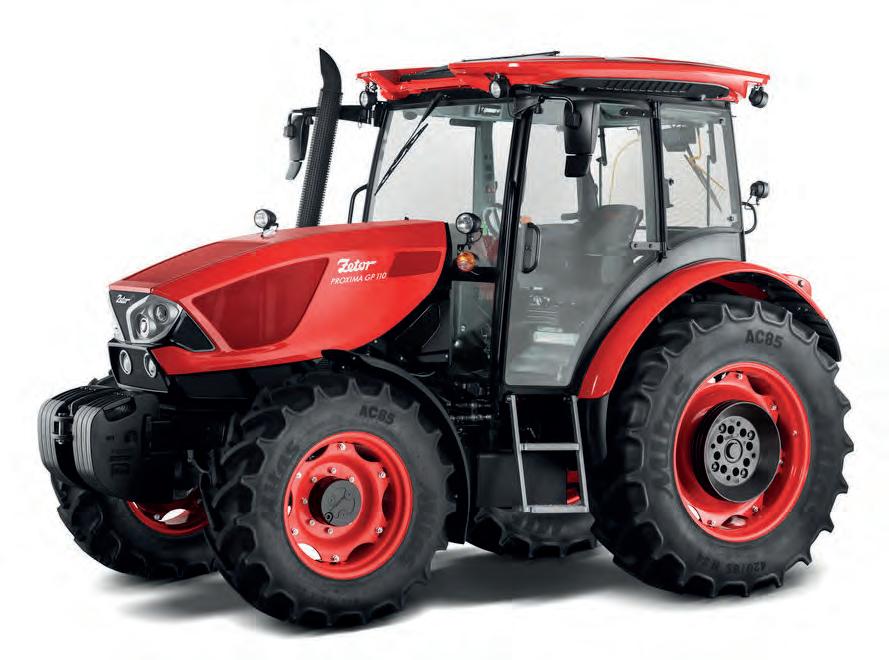



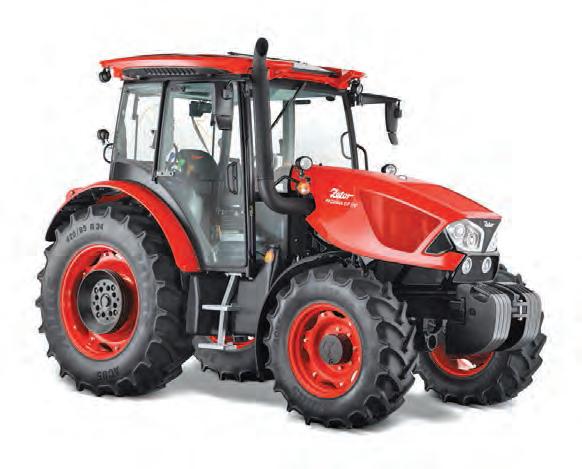
JUNE 9



HOW FLEXIBLE, EXTENDING AND DRAPER HEADERS HELP MAKE IT EASIER TO BRING IN THE HARVEST FOCUS ON


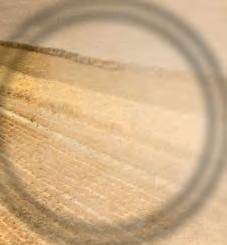


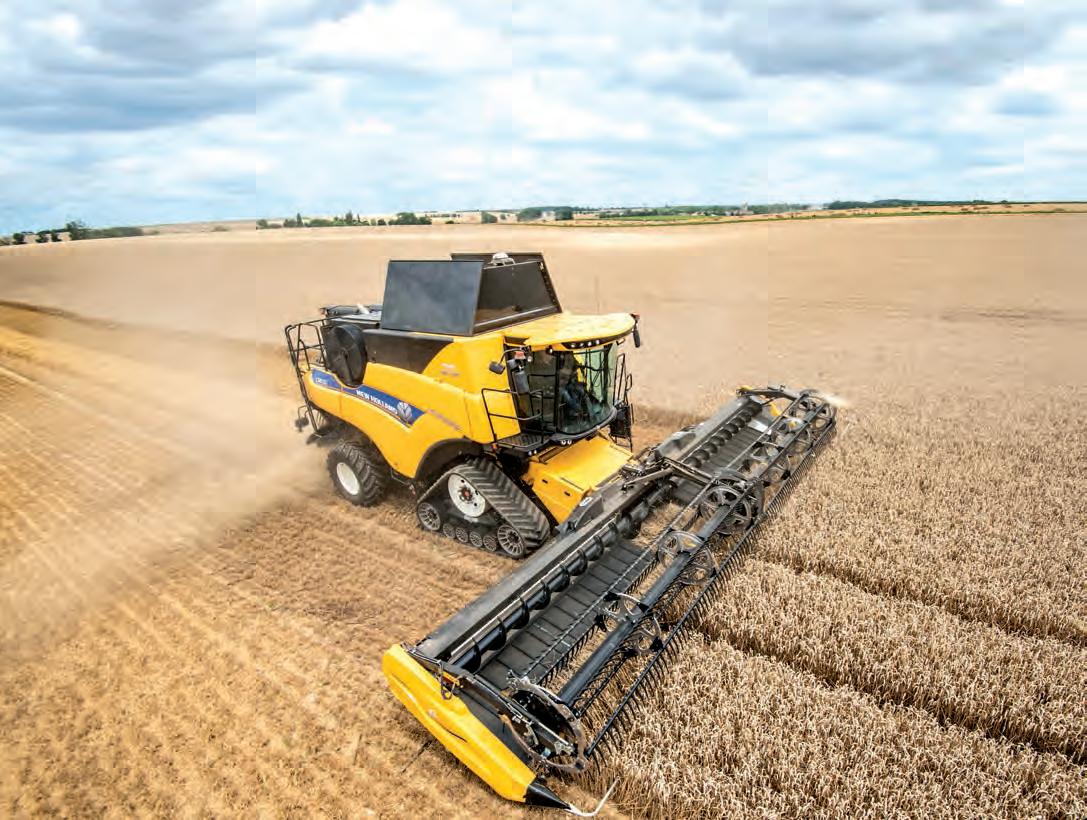
A LOOK AT THE LATEST COULTERS FOR STRIP-TILL, DIRECT DRILLING AND MINIMUM DISTURBANCE



IT’S SHOW TIME! FIND OUT ABOUT NEW EQUIPMENT THAT WILL BE MAKING ITS DEBUT AT CEREALS

PLUS… THEJOHN DEERE 6R 185 HOT TOPIC LOOKS AT HOW WE FUEL MODERN MACHINES HOW LATEST SPRAYER TECHNOLOGY BOOSTS ACCURACY AND EFFICIENCY AND MORE!*
MAKE SURE YOU NEVER MISS A COPY OF FARM MACHINERYJOURNAL BY SUBSCRIBING SEE PAGE 64 FOR MORE DETAILS

























Maschio power harrow, 6m, c/w packer roller and levelling bars, £11,250. Tel: 028 37 548971. Co. Tyrone. [FW240]
Krone Comprima V150 baler, 2012, 35k bale count, good condition, in full working order, video can be sent of it baling straw recently, £9,500 + VAT. Tel: 01931 714676. Cumbria. [FW208]
Amazone ZA-X Perfect 1402 fertiliser spreader, 2018, 10-18m discs, hydraulic headland deflector and hopper cover, very good condition, £2,950 + VAT. Tel: 01931 714676. Cumbria. [FW209]
Vicon PS753 fertiliser spreader, gwo, £750 + VAT. Tel: 07970 471773. Devon. [FW216]


Quivogne Pluto cultivator, 3m short discs, c/w steel ridge roller and leveller harrow, good condition, £4,950 + VAT ono. Tel: 07976 794383. Shropshire. [EFW58]



Zagroda ring rolls, 8.3 x 21” with hyd shatter boards, 2015, £9,900. Tel: 028 37 548971. Co.Tyrone. [FW239]
Twose folding rollers, 6.4m, crimped rings, and clod breakers in very good condition, £3,500. Tel: 07751 917839. Doncaster. [EFW77]
Horstine Agri band fert spreader, only done 4 acres, change of cropping policy means it’s no longer required. Near perfect condition and at a greatly reduced price compared to new. Can load onto lorry/trailer. £5,500 no VAT. Tel: 07785 912999. Evesham. [FGW1]



Teagle
fertiliser spreader, has done very little work, barn stored, as new condition, retirement forces sale, £1,000 ono. Tel: 07817 084209. Malton, N Yorks. [FGP9]




Reco Sulky DPX Prima fertiliser spreader, twin discs, 18-28m spread, will hold approx 3 x 600kg bags, 540rpm PTO drive, manual rate adjust, hydraulic open/close, new agitator bearings, good condition, ready to go, £1,095 + VAT. Tel: 01823 429431. Somerset. [FW206]
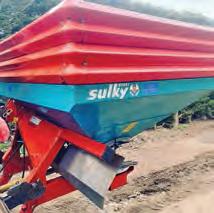

KRM M2 Bogballe fertiliser spreader, 2004, 2 sets of veins, E2 (new E6), PTO drive, mudflaps, road lights, hopper ladder, hopper grates, hopper cover, electronic control box, electric rate adjust, £3,295 + VAT. Tel: 01823 429431. Somerset. [FW202]
Manitou (Whites Handling) telehandler grab, 2013, 7ft 6in wide, good Kverneland tines, twin ram, hydraulic hoses, good tidy grab, Manitou brackets, £2,295 + VAT. Tel: 01823 429431. Somerset. [FW203]
Horstine Agroband fertiliser applicator, for potato or veg beds, good metal, new pipework, comes with tractor fixing brackets, barn stored, good working order. Tel: 07761 796012. N Yorks. [EFW151]

Cherry 10’ buck rake, 2017, fitted with KV tines and hydraulic push off, very good condition, ready for work, £3,400 + VAT. Tel: 01931 714676. Cumbria. [FW211]

Quicke 210 Silograb, 2016, 2.1m (7ft) wide, approx 1.1m3 capacity, twin ram, tines all present and mostly straight (would benefit from some TLC), new hydraulic hoses, Euro 8 brackets, £1,595 + VAT. Tel: 01823 429431. Somerset. [FW204]
McHale bale splitter, new tines, euro 8 brackets, gwo, £895 + VAT. Tel: 07970 471773. Devon. [FW213]







Land Rover Discovery TD5 Landmark, 2004, 5 new tyres, 12 months MOT, 158,000 miles, good condition, £3,950. Tel: 07791 259768. Craven Arms. [EFW148]


SIP Roto 185 drum mower, 6ft 6” gwo, £875 no VAT. Tel: 07970 471773. Devon. [FW218]
LWC topper, 9ft, new, £POA. Tel: 01286 830009. Gwynedd. [FW222]
Muck grab, 5ft, c/w Euro brackets and pipes, new, £POA. Tel: 01286 830009. Gwynedd. [FW220]
Buckets, 5ft, 6ft, 7ft, new, with Euro brackets, in stock, £POA. Tel: 01286 830009. Gwynedd. [FW221]

471773. Devon. [FW220]
The Electric Wheels Nipper, all electric 4x4 UTV. A versatile, slim all-terrain buggy. Road legal with 75 mile range and featuring an electric rear tipper for easy transportation of supplies. New from £13,495 + VAT, used models also available. Tel: 0333 3582175. Norfolk. [DW258]

John Deere 324 mower/ conditioner, 8ft, deceased estate, v. tidy, £4,250. Tel: 07771 852774. Somerset. [FW228]


Bale spike, new, euro 8 brackets, £275 + VAT. Tel: 07970 471773. Devon. [FW217]

Tel: 07773 480324. Cumbria. [EFW24]
Quicke 150 Silograb, 1.5m (5ft) wide, 8 tines top and bottom, all tight and straight, new hydraulic hoses, nice tidy grab, Euro 8 brackets, £1,295 + VAT. Tel: 01823 429431. Somerset. [FW205]
Ford Ranger XL, 18,000 Miles, 2017, FSH, c/w canopy load liner and tow pack, shod on good all terrain tyres and has a recent MOT, drives very well, £POA. Tel: 07740 683113. Cheltenham. [EFW81]


Icon, 2017, 2.4 manual,
Toyota
with DAB radio, hands free, reversing camera, A/C. full-service history, 94k miles, £16,950 + VAT. Tel: 01931 714676. Cumbria. [FW212]
LWC topper, new, 6ft, £POA. Tel: 01286 830009. Gwynedd. [FW223]
Kuhn GMD 700 GII mower, 9ft, 2011, in good order, £4,500. Tel: 07771 852774. Somerset. [FW229]

Major 9ft topper, no belts, in excellent working order, £900 ono. Tel: 01327 361531. Northants. [FGP2]

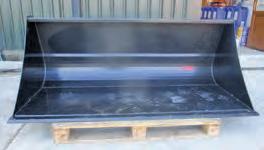
ZTR-185 mower, two drum, £1,250. Tel: 07771 852774. Somerset. [FW232]


Bomford RS-12 topper, 4ft, gwo, £775 no VAT. Tel: 07970 471773. Devon. [FW215]
West muck spreader, 10t, rear discharge, slurry door, £7,900. Tel: 028 37 548971. Co. Tyrone.


Kane 14t trailer, 18 foot, half pipe, rear steer, 560 tyres, air/hyd brake, £POA. Tel: 028 37 548971. Co. Tyrone. [FW237]

Kuhn BP305 flail topper, 2017, f/w hyd side shift, roller and whale tail flails, vc, video can be sent of it running, £4,950 + VAT. Tel: 01931 714676. Cumbria. [FW213]


Talex Boccain 225 swath wilter, new, 2.25m working width, tine savers, £3,750 + VAT. Tel: 07970 471773. Devon. [FW214]
Abbey 900 vac tanker, c/w extra fill valve, owner retired, £1,950. Tel: 028 37 548971. Co.Tyrone. [FW235]
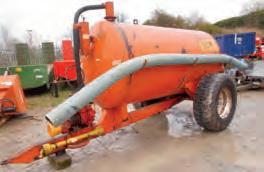
Kverneland match plough, as new KV 25 boards, c/w spool block, hydraulic top link, hydraulic cross shaft, adjustable disc and skimmers and also bogie wheel unit and adjustable tail pieces, £4,000. Tel: 07547 719279. Angus. [EFW127]
AS Marston 700 dung spreader, done little work, still paint on inside, £4,900. Tel: 07771 852774. Somerset. [FW225]
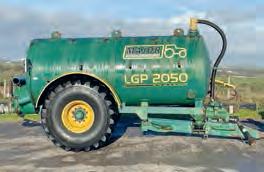
TO ADVERTISE HERE FREE SEE DETAILS AT THE END OF THE SECTION
Claas Volto 52
, 4 rotor, 2015, excellent condition, done little work, £4,750 + VAT. Tel: 01931 714676. Cumbria. [FW207]

Samasz rotary hay tedder/trailer, p4-531c, 4 rotars plus 6 arms (pcs) working width 5.3 m, transport width 2.95 m, transport height 2.75 m, rpm 540, weight is 695 kg, three point linkage, purchased new three years ago – never used due to semi-retirement, stored inside, instruction manual available, purchaser to collect, £5,250. Tel: 07557 383844. [EFW143]
Bailey 16t TB trailer, 5/2022, silage sides, grain chute, hyd door, mudguards, front & rear mud flaps, beacon, rev lights, high level rear lights, as new, £POA. Tel: 01823 253808. Somerset. [FW200]

Krone KW 5.5m tedder, one owner, excellent condition light use, barn stored, £3,250 + VAT. Tel 07887 543683. Bucks. [DEW53R]

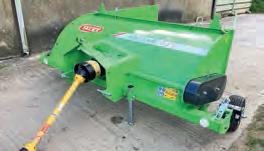
Ifor Williams GB 84 trailer, 8ft x 4ft, twin axle, general purpose deck, 2,600 kg, updated to 3,500kg, gross weight, good tyres and spare, fully working lights and brakes, very good condition, £2,400 + VAT. Tel: 07774 816630. Newark. [EFP8]
West grain/silage trailer, 10t, in excellent order, £POA. Tel: 07771 852774. Somerset. [FW230]

AS Marston dump trailer, 14t, on 10 stud axles, £4,900. Tel: 028 37 548971. Co.Tyrone. [FW238]
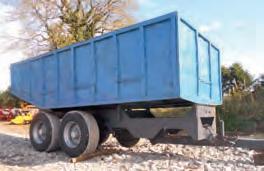
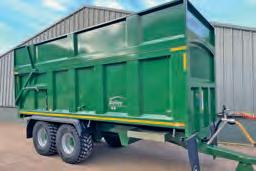


01286 830009.
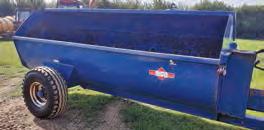
Skilled arable operator. Location: Hampshire. A permanent full time opportunity has become available in Hampshire on two family estates operating to leading standards. The position would suit an enthusiastic, conscientious and responsible individual with extensive experience in combinable cropping, and includes competitive remuneration, a family house and other benefits. PA1/PA2 qualifications required. Please apply with CV to Philip White, chidden@ supanet.com; or call 07836 217174 for further information.
Farm manager. Location: North Lincolnshire. Kitchen Garden Produce grows and packs shallots and asparagus for major retailers. We are looking for a hands-on farm manager to take an active and keen interest in the farm and the business as a whole. This is a long term, unique and varied role in a supportive and forward-thinking business. You will have; practical experience and understanding of all farming practices, proven strong leadership skills and people management, proven track record in successful crop production, keen interest in the growing, harvesting and storing of root veg and specialist crops and excellent communications skills. You will be; dealing with all aspects of crop production and storage, agronomy, staff management, machinery operations, maintenance and the implementation of health and safety, working with the management team to ensure the efficient running of the business, learning from the principal and taking increasing responsibility, and enthusiastic, practical, positive, communicative and an effective team leader. Very competitive package and start date to suit by agreement. CV and covering letter to Chris Kitchen chris@kgp.org.uk by 9th May.
Harvester driver/tractor driver. Location: Perthshire. Pea harvest July, August & September. Accommodation available. Email neil@brucefarms.co.uk
Assistant farm manager. Location: Lewes, East Sussex. Due to continued expansion an exciting opportunity has arisen to help manage our farm team, as well as assist the Managing Director. Iford Estate near Lewes, East Sussex, comprises 1200ha of mixed farming, including 800ha of arable cropping, as well as many diversified property and leisure enterprises. The estate is also leading the way in providing large scale Biodiversity Net Gain for developers and actively exploring all natural capital markets. Responsibilities; coordination of day to day activities, keeping accurate and up to date records, assisting with the purchase of farm inputs and sales, crop and grain store monitoring, ensuring regulatory compliance, assisting with implementing our ambitious Nature Recovery Scheme, and tractor and livestock work as required. Salary dependent on skills and experience, housing available if required. For further information to discuss the position in confidence, call Ben Taylor on 07974 267780 or to apply please send CV and covering letter to ben@ifordestate. com. Closing date 5th May 2023.
PDI assembler. Location: Levens. P.V. Dobson renowned for its long-running association with the Massey Ferguson brand and sister company Fendt are looking for a Pre delivery inspection assembler. The role is within our industrial sector of the business. Position will be workshop based. Follow Pre Delivery Inspection checklist for all machines. Run & test before delivery to customer. Can follow Policy & Procedures and working practices, maintain a safe and tidy work area at all times. Able to work as part of a small team of 5. Have an ability to overcome and document problems in a logical and methodical manner. Should display a positive attitude towards work and the working environment. Knowledge of Excavators, Dumpers & Telehandlers is essential. Full clean driving licence. Training will be given. Contact Nicola Taylor at P.V. Dobson on 07718 785401 or email nicola@pvdobson.com
Mechanic/technician. Location: Skipton. P.V. Dobson renowned for its long-running association with the Massey Ferguson brand and sister company Fendt are looking for an experienced agricultural mechanic. The candidate will be experienced working on agricultural machinery, possibly Manitou tele-handlers and/or plant. They will also confident in the use of diagnostic software/ equipment, hydraulic, electrical and engine repairs. The majority of the work will be based in our modern workshop at Skipton. The candidate will be expected to demonstrate initiative, be responsible and have a mature outlook. We also expect high standards with regard to customer service, administration and paperwork. Please contact P.V. Dobson, Skipton Branch Manager Will Bell on 0773 663 2841 wbell@ pvdobson.com
Sales representative. Location: Lancashire. P.V. Dobson renowned for its long-running association with the Massey Ferguson brand and sister company Fendt are looking for a sales representative. We are on the look out for a dynamic, hard working, organised individual to join our successful sales team. Representing both the company and some key franchises this is a great opportunity for someone who wants to take an already strong territory and drive it to the next level. Experience in plant/agri machinery in some form is essential, full training and support will be given from our experienced team. Package depending on experience. Please email your CV in the first instance to wbell@pvdobson.com or call William Bell, Sales Manager at P.V. Dobson on 07736632841 for a confidential discussion
Farmer looking for Summer & Autumn work, 32 years in farming looking for relief tractor drive/ combine drive. For short term, can do emergency work, have fork lift licence, have touring caravan to stay in & done most things. On the farm can do a good days work, self employed, 65 but still got a good days work. Please contact me on 07973 872610 or email pedleyhill@ btinternet.com
Field based technical support.
Location: nationwide. Maschio
Gaspardo is a leading worldwide manufacturer of agricultural machinery and is looking to recruit three experienced service engineers in the UK. One for each of the following territories north, midlands and south. The successful applicants will join a dedicated team which is being created as a result of the decision to establish a Maschio Gaspardo subsidiary branch in the UK. We are looking for three new members of staff in different locations around the UK, the successful applicant will have a strong knowledge of agricultural practices and good technical knowledge of agricultural machinery. If you are a strong team player, keen to travel and able to relate to farmers and agricultural dealers, we would like to hear from you. Your career development is important to us. We want to invest in the right candidates, giving them the opportunity to learn and grow with the business. Please email your CV to Taryn.cochran@opico.co.uk www.opico.co.uk/vacancies
Mobile plant technician
Location: Levens, Skipton or Chorley. P.V. Dobson renowned for its long-running association with the Massey Ferguson brand and sister company Fendt are looking for an experienced plant mechanic. The candidate will be experienced working on construction machinery. They will also confident in the use of diagnostic software/ equipment, hydraulic, electrical and engine repairs. The majority of the work will be based out on site. The candidate will be expected to demonstrate initiative, be responsible and have a mature outlook. We also expect high standards with regard to customer service, administration and paperwork. Contact Nicola Taylor at P.V. Dobson on 07718 785401 or email nicola@pvdobson.com
Experienced tractor driver/ plant operator, mechanic and labourer. Location: Leicestershire. Looking for regular contractual or seasonal opportunities. NPTC/ NPOR. Call 07794 467215.
Ploughing & cultivating services. Location: Perthshire. Also topping grass services. Please call 07760 151294.
General farm worker. Location: South Warwicks. General farm worker required for mixed farming operation. Heritage Farms is a mixed farming operation currently comprised of 1500 ewes and 400 ewe lambs with some arable land in addition. We are seeking to employ a good all-round farm worker who will assist the farm as part of our four-person team. Interest in working in all aspects of the business, i.e. sheep, arable, conservation and some building/ carpentry is essential. Many tasks will include but not exclusive to general sheep work, maintenance of fences and sheep sundries, some carpentry on stables and sheep feeders for example and the4 day to day operation of the general running of the farm. This role would be well suited to someone self-motivated wishing to gain experience across a variety of agricultural practices. Full driving licence is essential alongside a good sense of humour and a can do attitude. Accommodation is available. Please email hfarmsoxhill@yahoo.co.uk or phone 07980 823381.
Experienced tractor driver and general farm work, looking for full time job with accommodation, any area considered. Expereinced in agriculture have tickets for related 360 work, hedge and verge cutting, grass cutting with flail, and bat wing toppers, gang mowing, trailer work and muck spreading with side and rear discharge spreaders, chain saw work, have experience with livestock, anything considered Tel 073794 93966.
Agricultural engineer, looking for experienced Agricultural engineer towork on all Claas, Massey Ferguson, Fendt, Manitou, Kioti and more. Must have a minimum of 5 years’ experience on above brands and be prepared to relocate to beautiful North Queensland - Australia. Contact me for more information with a CV and cover letter. 0061 407 417546. Cairns.

Job opportunity in Australia. JCB Gippsland is part of the largest JCB dealer group in Australia, we currently have vacancies in parts and service. Free air return air travel, accommodation and visa sponsorship available for the right candidates. For more information contact Jon. jon@michaelagroup. net.au +61 (0) 4999 57007 Phone 0499957007Advert Town VIC Australia.
Agricultural Engineers. Various locations. At Chandlers we have excellent career opportunities for engineers to work with some of the most prestigious agricultural machinery brands. We have opportunities for experienced Engineers qualified in Land Based Engineering and for any relevant equipment such as HGV or Plant. For further information please visit http://www.chandlers.co.uk/ careers or call 01476 590077.
Agricultural Service Engineer. Location: Kelso, Scotland. Agricultural Engineer role available with leading dealer Scot Agri. We provide machinery sales, service, and parts from JCB, Massey Ferguson, HORSCH, KTWO, Berthoud and more across our nine agricultural depots. We are currently looking for an engineer to join our team in Kelso. We would welcome applications from engineers with plant or agricultural experience. In return we offer a competitive salary and overtime rates, generous annual leave entitlements, a company van and training opportunities. For more information and to apply visit www.scotagri.com/careers or send your cv to hr@scot-jcb.co.uk
Tractor driver/general farm worker. Location New Zealand. A vacancy has arisen to join Springdale Farming Co. Ltd on their 640ha operation on South Island, 65 km south of Christchurch, commencing June 2023. We are an English farming company that moved to NZ in 2001 from Lincs. Position would suit a farmer’s son looking to travel and gain experience. A wide range of arable crops are grown all under lateral irrigation and in winter months graze a large number of dairy cos whole in-calf. Store lambs and ewe-hoggets are also grazed. We also run a busy contracting business operating two Claas 5300 large square balers, and offer range of services to neighbouring clients including harvesting and cultivations. The farm runs a modern fleet of John Deere tractors ranging from 150 to 340HP. We offer a competitive remuneration package including on-farm accommodation. Please forward, via e-mail a brief covering letter and cv to billdavey@xtra.co.nz
Self-propelled sprayer/arable operator. Based in Pembrokeshire. Raymond Bros run a mixed farming enterprise in the north of the picturesque county of Pembrokeshire. The business comprises of 2,000 acres of combinable crops, 400 acres of potatoes and 2 dairy herds. An opportunity has arisen for an enthusiastic and conscientious operator to undertake spraying/ liquid fertilizer operations. Equipment includes: John Deere R4140 and R4040i. The successful candidate will need to: demonstrate a high level of attention to detail, have a PA1 and PA2 essential, have ability to maintain and service machinery, keep accurate records, and be a strong team player. Additional duties may include: operating potato harvester and a range of arable/potato duties. The successful candidate can expect a competitive remuneration package. Accommodation can be sourced if required. Please apply with covering letter and CV by email to raymond.jordanston@gmail.com or ring Nigel Raymond on 07866 493380.
Harvest Your Potential With an Agriculture Course at SMB College Group! As a Further and Higher Education college, SMB College Group has educated generations of land-based and Agricultural professionals at their 850-acre Brooksby Campus, situated in the heart of the Leicestershire countryside. With a working livestock and arable farm, industry-expert lecturers and purpose-built landbased workshop facilities, the Brooksby Campus is the perfect environment to hone your Agricultural skills and kick-start your career in the land-based sector. Whether you’re looking for a great land-based college option for when you leave school, or are looking to re-train, SMB College Group is the place to be for studying Agriculture, Land-based Engineering, Countryside & Environmental Management, Horticulture and more. College buses are available across the county of Leicestershire, and on-site accommodation is available for students from further afield. Find out more about the courses on offer, book your place on an open day, or apply for a course at www.smbcollege group.ac.uk, or give the Enquiries team a call on 01664 850 850.
Gain valuable practical experience in America with The Ohio Programme. Big acres, big equipment. Improve your skills and knowledge. Enhance your career prospects. If you have a strong interest in agricultural crop production and machinery then this is for you. Age range 19 to 28.
Minimum NVQ 2 or one year of full time agricultural education needed. Programs from 8 to 12 months. Can be used towards college industrial placements (with your colleges approval). You’ve read and dreamed of agriculture in the USA, now’s your chance to experience it in real life. Host placement organized, help with visas, health insurance, travel plans, full back up whilst in the USA. For more information contact John Beardmore at 001 6142926678 or email beradmore.4@osu.edu
With a readership of owners and operators of modern farm machinery, there’s no better place to advertise than the Farm Machinery Trader pages in Farm Machinery Journal. Trade and private machinery adverts are FREE and you can also have a FREE picture!













Complete the form below and post it to us with your photograph, email your advertisement to classifieds@farmmachineryjournal.co.uk or place your advert online at www.farmmachineryjournal.co.uk
If required, your photo (JPEG or PDF) should be sent as an attachment to your email message. In addition to the wording required, please provide your full name and address (not for publication).









Rear Link



The Tractor Twitcher


David Laley, aka The Tractor Twitcher, has been photographing farm machinery of all ages for almost 30 years and is now a valued FMJ contributor. In this new column he delves into his extensive archives to bring us all a fascinating insight into the machinery he’s captured at work on his travels over the years
In between the rain, spring work is now well under way across the UK. In his first instalment of photos The Tractor Twitcher brings us a variety of drills he’s photographed during springtime since 2012.
1 This mighty 330hp John Deere 8345R is seen here kicking up the dust in March 2012 with this 6m-wide Sumo-Moore Versadrill
2 In a scene straight out of the early 1980s, the late Bill Bentley prepares to go drilling with his wonderful Massey Ferguson 698 and Massey Ferguson 30 drill in March 2012
3 This impressive 240hp Fendt 724 Vario equipped with front and rear Stocks dual wheels was seen drilling vining peas on the Yorkshire Wolds in March 2016 with this Sumo Agri-Weld and Herriau-based combination drill


4 One of the more unusual drilling outfits
The Tractor Twitcher discovered in 2016 was this Caterpillar-powered Challenger 765 drilling grass seed for turf production with a specially made drill


5 Sugar beet is seen here being drilled in South Yorkshire in 2017 with this New Holland T7.235 matched to a 12-row Kverneland Accord Monopill drill mounted on the back of a Cousins drill harrow
6 This rare blue-liveried New Holland M115 was seen earlier this year near Gainsborough drilling spring beans with this 4m-wide KRM Sola cultivator drill


